Feasibility Study of Hydropower Plant in Satara District, India
VerifiedAdded on 2023/06/07
|37
|8948
|126
AI Summary
This research paper presents a feasibility study of the hydropower plant in Satara District in India. The study proposes the modification and replacement of the three major components of hydro unit namely wicket gates, wear plates, and seal rings which can improve the efficiency of Koyna Hydropower plant by approximately 2% and the capacity of the plant can also be increased by 3 percent to 5 percent.
Contribute Materials
Your contribution can guide someone’s learning journey. Share your
documents today.
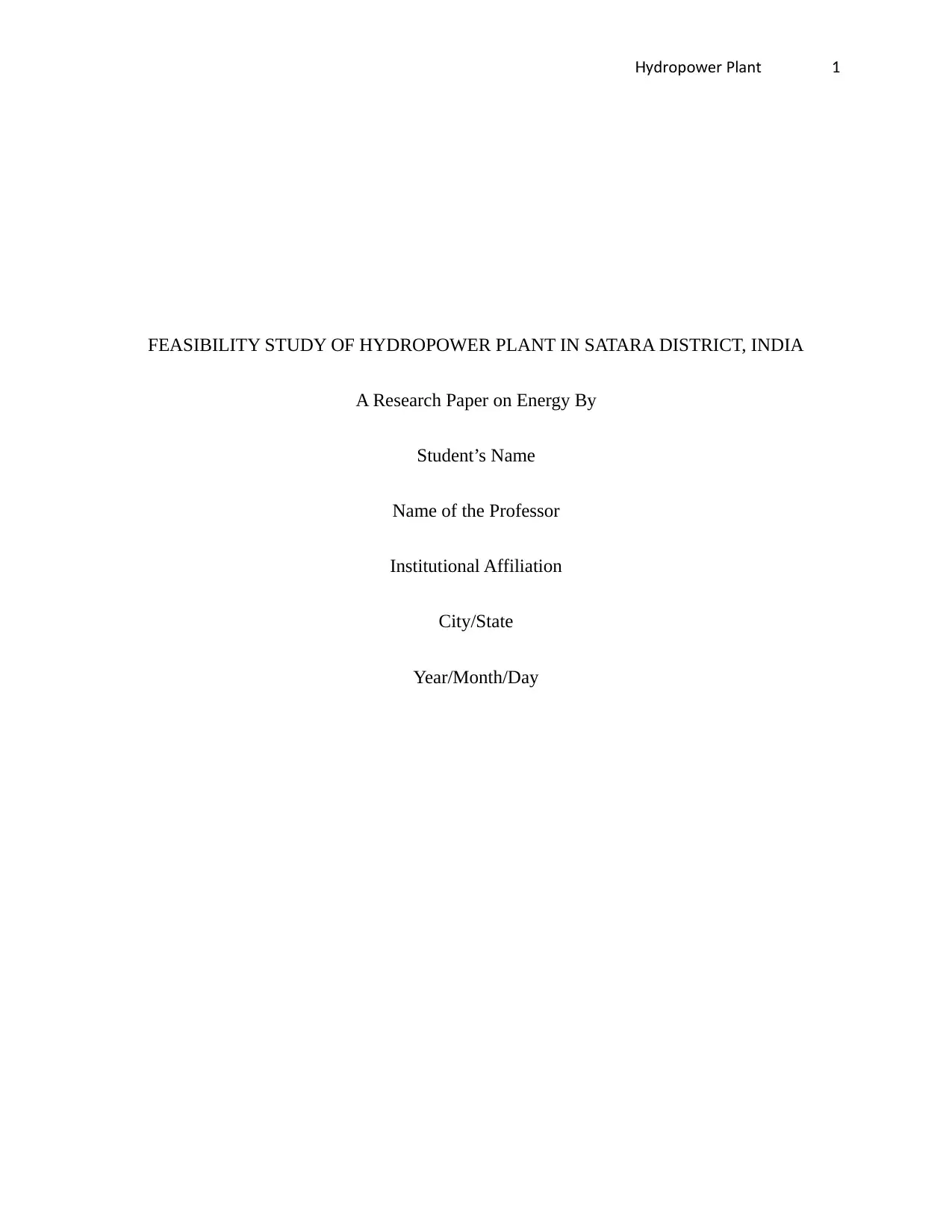
dropo er PlantHy w 1
FEASIBILITY STUDY OF HYDROPOWER PLANT IN SATARA DISTRICT, INDIA
A Research Paper on Energy By
Student’s Name
Name of the Professor
Institutional Affiliation
City/State
Year/Month/Day
FEASIBILITY STUDY OF HYDROPOWER PLANT IN SATARA DISTRICT, INDIA
A Research Paper on Energy By
Student’s Name
Name of the Professor
Institutional Affiliation
City/State
Year/Month/Day
Secure Best Marks with AI Grader
Need help grading? Try our AI Grader for instant feedback on your assignments.
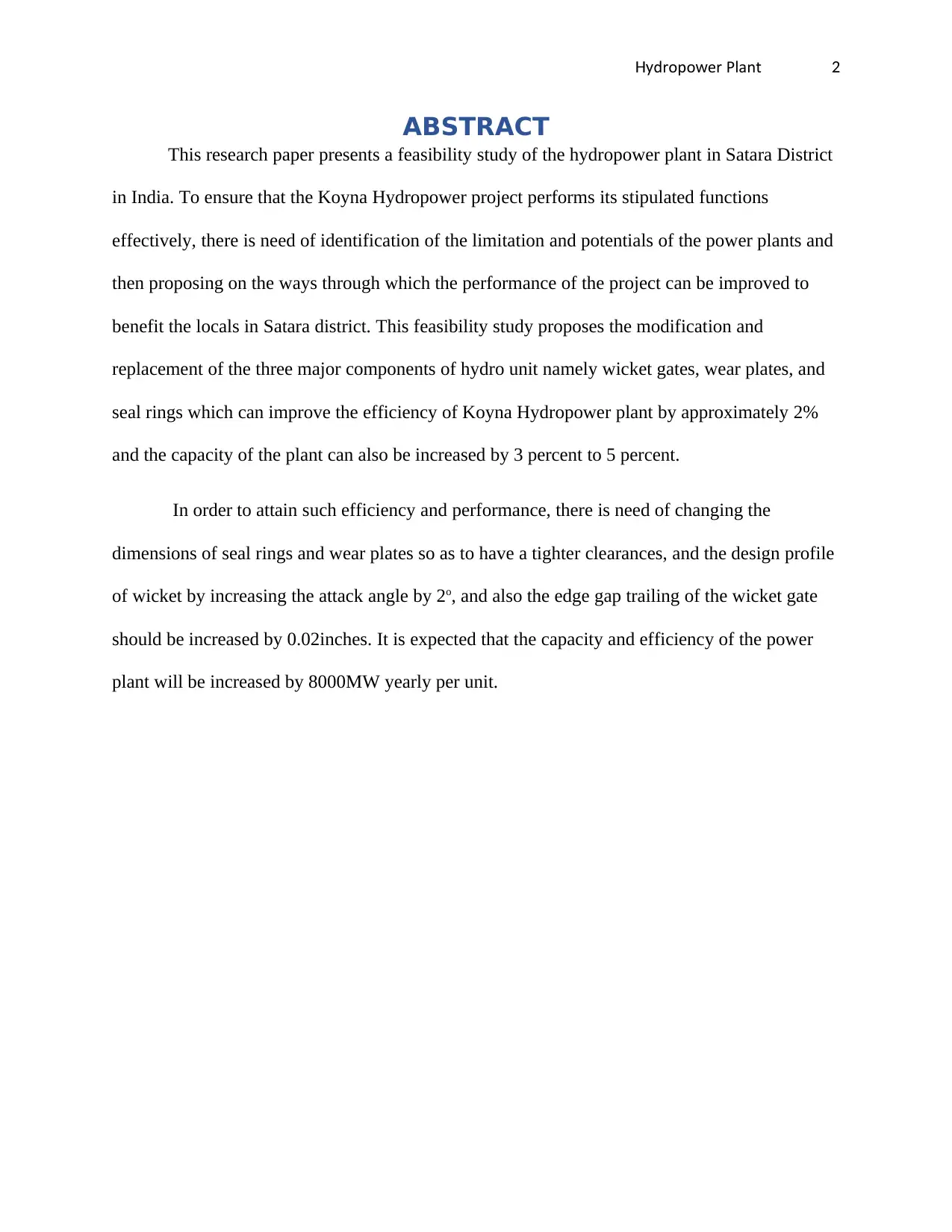
dropo er PlantHy w 2
ABSTRACT
This research paper presents a feasibility study of the hydropower plant in Satara District
in India. To ensure that the Koyna Hydropower project performs its stipulated functions
effectively, there is need of identification of the limitation and potentials of the power plants and
then proposing on the ways through which the performance of the project can be improved to
benefit the locals in Satara district. This feasibility study proposes the modification and
replacement of the three major components of hydro unit namely wicket gates, wear plates, and
seal rings which can improve the efficiency of Koyna Hydropower plant by approximately 2%
and the capacity of the plant can also be increased by 3 percent to 5 percent.
In order to attain such efficiency and performance, there is need of changing the
dimensions of seal rings and wear plates so as to have a tighter clearances, and the design profile
of wicket by increasing the attack angle by 2o, and also the edge gap trailing of the wicket gate
should be increased by 0.02inches. It is expected that the capacity and efficiency of the power
plant will be increased by 8000MW yearly per unit.
ABSTRACT
This research paper presents a feasibility study of the hydropower plant in Satara District
in India. To ensure that the Koyna Hydropower project performs its stipulated functions
effectively, there is need of identification of the limitation and potentials of the power plants and
then proposing on the ways through which the performance of the project can be improved to
benefit the locals in Satara district. This feasibility study proposes the modification and
replacement of the three major components of hydro unit namely wicket gates, wear plates, and
seal rings which can improve the efficiency of Koyna Hydropower plant by approximately 2%
and the capacity of the plant can also be increased by 3 percent to 5 percent.
In order to attain such efficiency and performance, there is need of changing the
dimensions of seal rings and wear plates so as to have a tighter clearances, and the design profile
of wicket by increasing the attack angle by 2o, and also the edge gap trailing of the wicket gate
should be increased by 0.02inches. It is expected that the capacity and efficiency of the power
plant will be increased by 8000MW yearly per unit.
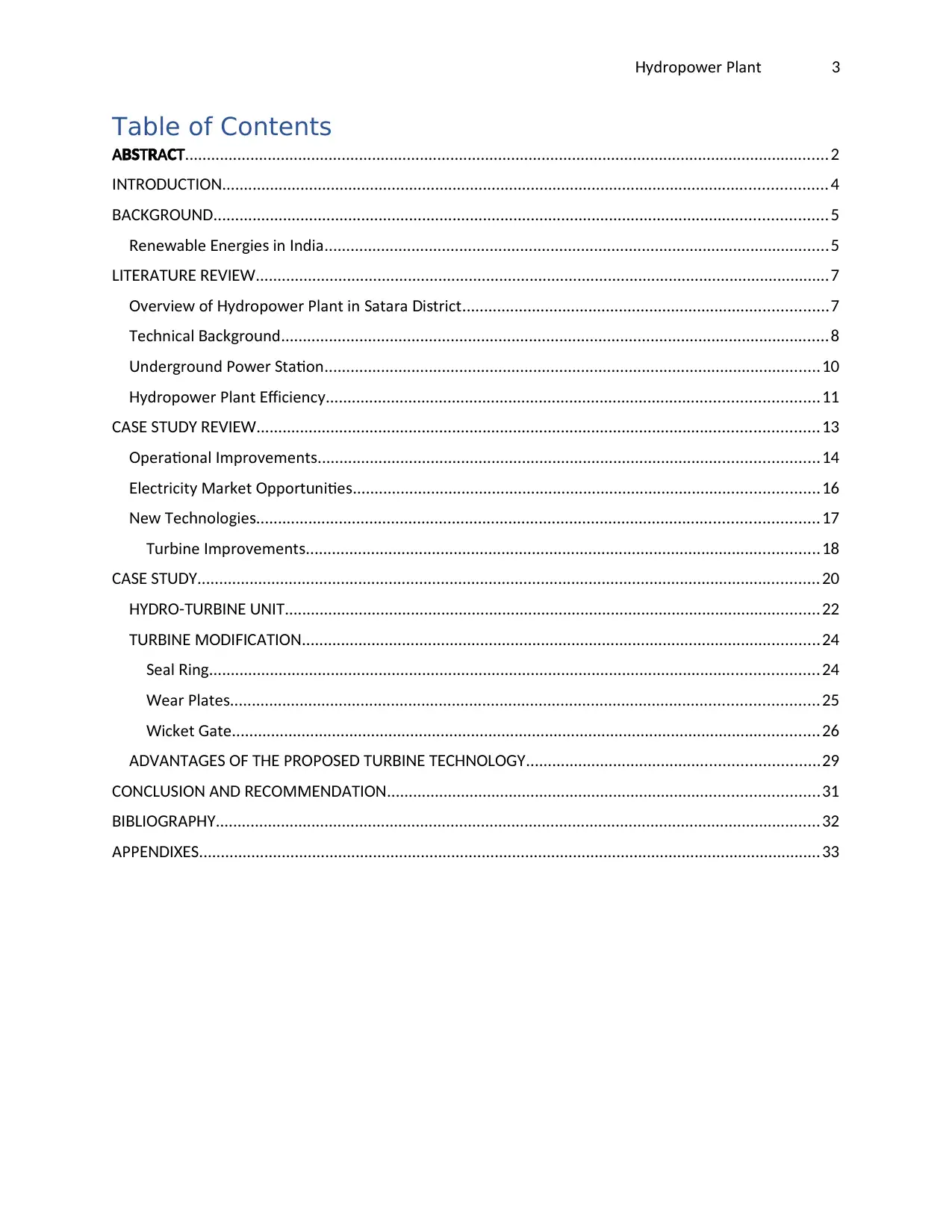
dropo er PlantHy w 3
Table of Contents
A T A TBS R C ....................................................................................................................................................2
T TIN RODUC ION...........................................................................................................................................4
AB CKGROUND.............................................................................................................................................5
ene a le ner ie in ndiaR w b E g s I ....................................................................................................................5
T ATLI ER URE REVIEW....................................................................................................................................7
er ie o dropo er Plant in atara i trictOv v w f Hy w S D s ....................................................................................7
Tec nical ac ro ndh B kg u ..............................................................................................................................8
nder ro nd Po er tationU g u w S ..................................................................................................................10
dropo er Plant iciencHy w Eff y.................................................................................................................11
A TC SE S UDY REVIEW.................................................................................................................................13
perational mpro ementO I v s...................................................................................................................14
lectricit Mar et pport nitieE y k O u s...........................................................................................................16
e Tec nolo ieN w h g s.................................................................................................................................17
T r ine mpro ementu b I v s......................................................................................................................18
A TC SE S UDY...............................................................................................................................................20
T THYDRO- URBINE UNI ...........................................................................................................................22
T M ATURBINE ODIFIC ION.......................................................................................................................24
eal inS R g............................................................................................................................................24
ear PlateW s.......................................................................................................................................25
ic et ateW k G .......................................................................................................................................26
A A TA T P P T TDV N GES OF HE RO OSED URBINE ECHNOLOGY...................................................................29
A MM ATCONCLUSION ND RECO END ION...................................................................................................31
APBIBLIOGR HY...........................................................................................................................................32
APPENDIXES...............................................................................................................................................33
Table of Contents
A T A TBS R C ....................................................................................................................................................2
T TIN RODUC ION...........................................................................................................................................4
AB CKGROUND.............................................................................................................................................5
ene a le ner ie in ndiaR w b E g s I ....................................................................................................................5
T ATLI ER URE REVIEW....................................................................................................................................7
er ie o dropo er Plant in atara i trictOv v w f Hy w S D s ....................................................................................7
Tec nical ac ro ndh B kg u ..............................................................................................................................8
nder ro nd Po er tationU g u w S ..................................................................................................................10
dropo er Plant iciencHy w Eff y.................................................................................................................11
A TC SE S UDY REVIEW.................................................................................................................................13
perational mpro ementO I v s...................................................................................................................14
lectricit Mar et pport nitieE y k O u s...........................................................................................................16
e Tec nolo ieN w h g s.................................................................................................................................17
T r ine mpro ementu b I v s......................................................................................................................18
A TC SE S UDY...............................................................................................................................................20
T THYDRO- URBINE UNI ...........................................................................................................................22
T M ATURBINE ODIFIC ION.......................................................................................................................24
eal inS R g............................................................................................................................................24
ear PlateW s.......................................................................................................................................25
ic et ateW k G .......................................................................................................................................26
A A TA T P P T TDV N GES OF HE RO OSED URBINE ECHNOLOGY...................................................................29
A MM ATCONCLUSION ND RECO END ION...................................................................................................31
APBIBLIOGR HY...........................................................................................................................................32
APPENDIXES...............................................................................................................................................33
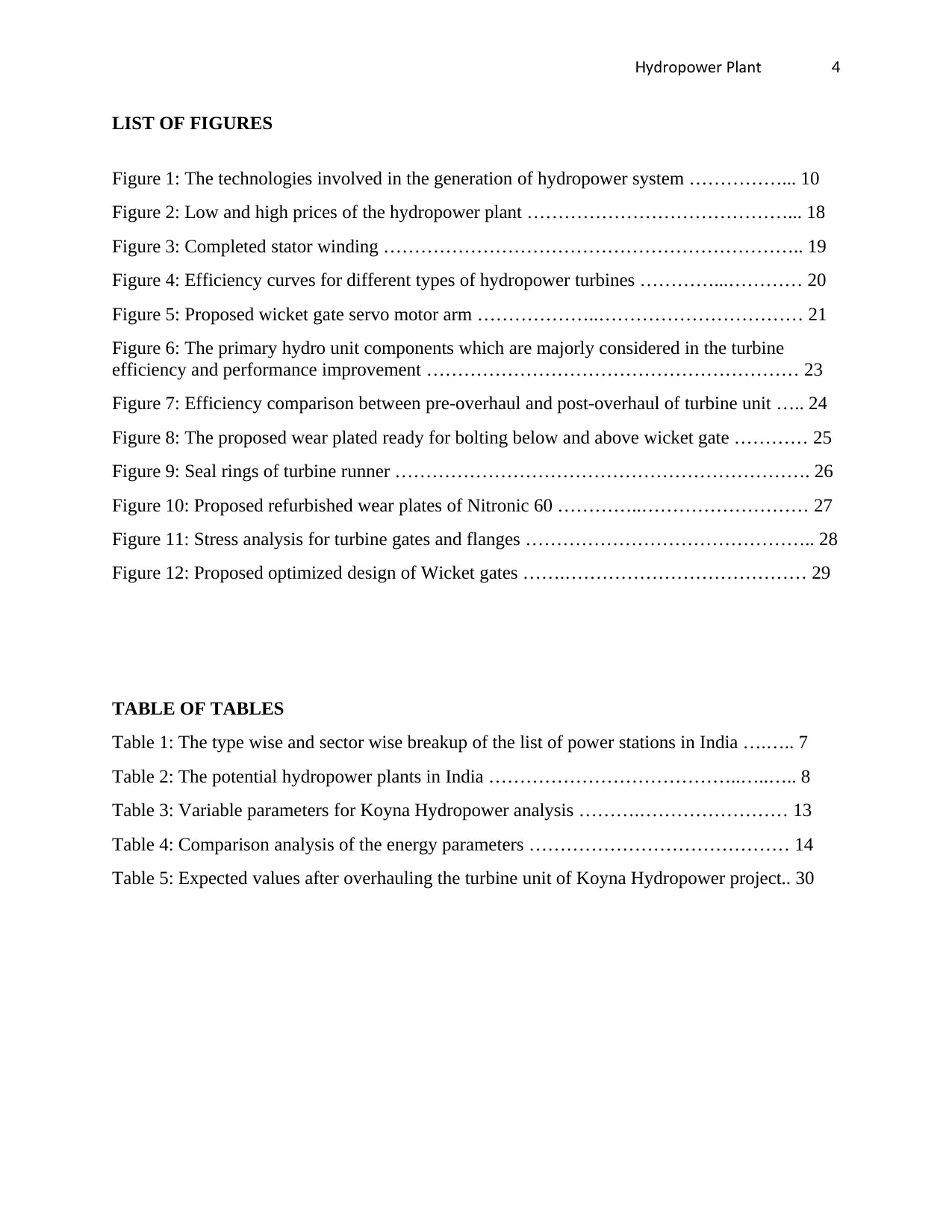
dropo er PlantHy w 4
LIST OF FIGURES
Figure 1: The technologies involved in the generation of hydropower system ……………... 10
Figure 2: Low and high prices of the hydropower plant ……………………………………... 18
Figure 3: Completed stator winding ………………………………………………………….. 19
Figure 4: Efficiency curves for different types of hydropower turbines …………...………… 20
Figure 5: Proposed wicket gate servo motor arm ………………..…………………………… 21
Figure 6: The primary hydro unit components which are majorly considered in the turbine
efficiency and performance improvement …………………………………………………… 23
Figure 7: Efficiency comparison between pre-overhaul and post-overhaul of turbine unit ….. 24
Figure 8: The proposed wear plated ready for bolting below and above wicket gate ………… 25
Figure 9: Seal rings of turbine runner …………………………………………………………. 26
Figure 10: Proposed refurbished wear plates of Nitronic 60 …………..……………………… 27
Figure 11: Stress analysis for turbine gates and flanges ……………………………………….. 28
Figure 12: Proposed optimized design of Wicket gates …….………………………………… 29
TABLE OF TABLES
Table 1: The type wise and sector wise breakup of the list of power stations in India ….….. 7
Table 2: The potential hydropower plants in India …………………………………..…..….. 8
Table 3: Variable parameters for Koyna Hydropower analysis ……….…………………… 13
Table 4: Comparison analysis of the energy parameters …………………………………… 14
Table 5: Expected values after overhauling the turbine unit of Koyna Hydropower project.. 30
LIST OF FIGURES
Figure 1: The technologies involved in the generation of hydropower system ……………... 10
Figure 2: Low and high prices of the hydropower plant ……………………………………... 18
Figure 3: Completed stator winding ………………………………………………………….. 19
Figure 4: Efficiency curves for different types of hydropower turbines …………...………… 20
Figure 5: Proposed wicket gate servo motor arm ………………..…………………………… 21
Figure 6: The primary hydro unit components which are majorly considered in the turbine
efficiency and performance improvement …………………………………………………… 23
Figure 7: Efficiency comparison between pre-overhaul and post-overhaul of turbine unit ….. 24
Figure 8: The proposed wear plated ready for bolting below and above wicket gate ………… 25
Figure 9: Seal rings of turbine runner …………………………………………………………. 26
Figure 10: Proposed refurbished wear plates of Nitronic 60 …………..……………………… 27
Figure 11: Stress analysis for turbine gates and flanges ……………………………………….. 28
Figure 12: Proposed optimized design of Wicket gates …….………………………………… 29
TABLE OF TABLES
Table 1: The type wise and sector wise breakup of the list of power stations in India ….….. 7
Table 2: The potential hydropower plants in India …………………………………..…..….. 8
Table 3: Variable parameters for Koyna Hydropower analysis ……….…………………… 13
Table 4: Comparison analysis of the energy parameters …………………………………… 14
Table 5: Expected values after overhauling the turbine unit of Koyna Hydropower project.. 30
Secure Best Marks with AI Grader
Need help grading? Try our AI Grader for instant feedback on your assignments.
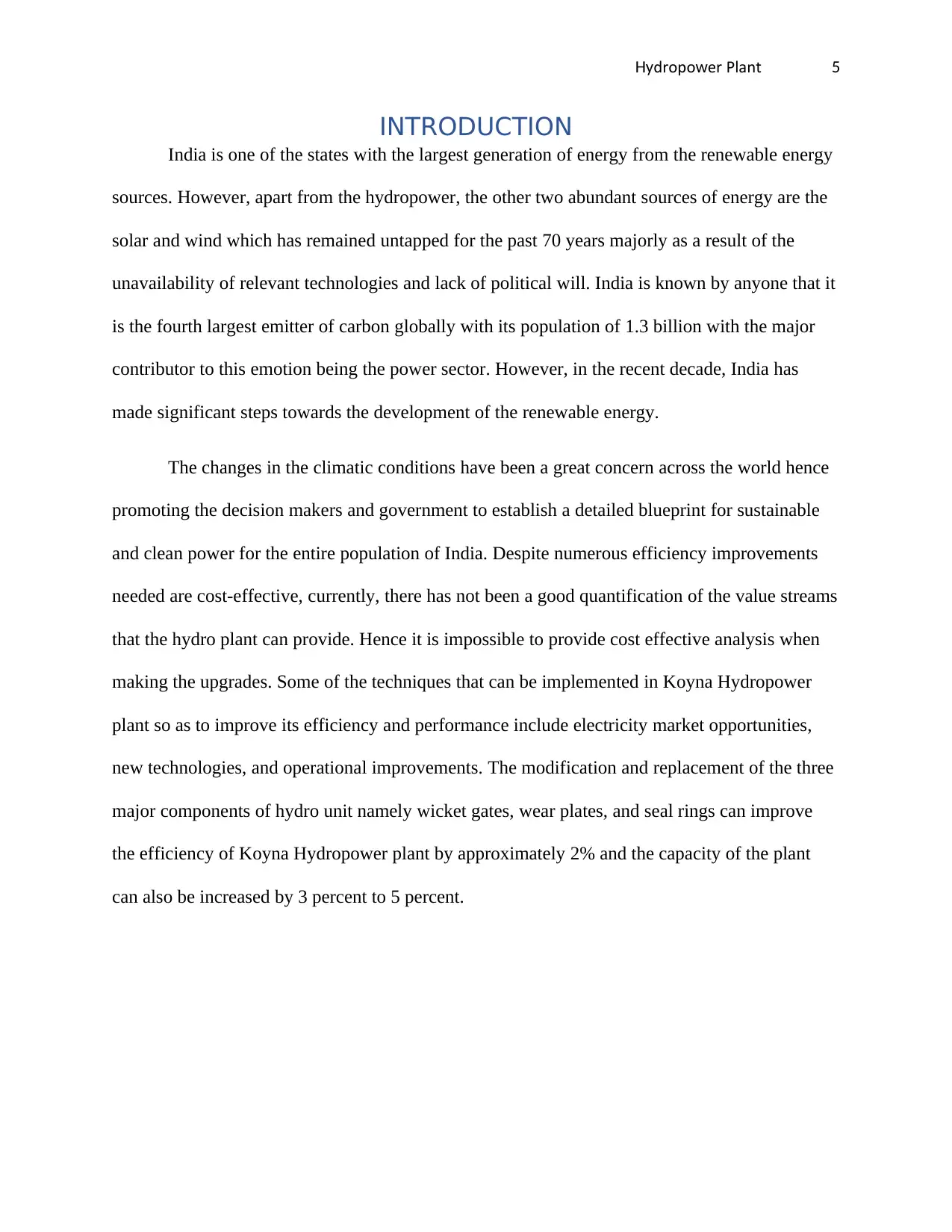
dropo er PlantHy w 5
INTRODUCTION
India is one of the states with the largest generation of energy from the renewable energy
sources. However, apart from the hydropower, the other two abundant sources of energy are the
solar and wind which has remained untapped for the past 70 years majorly as a result of the
unavailability of relevant technologies and lack of political will. India is known by anyone that it
is the fourth largest emitter of carbon globally with its population of 1.3 billion with the major
contributor to this emotion being the power sector. However, in the recent decade, India has
made significant steps towards the development of the renewable energy.
The changes in the climatic conditions have been a great concern across the world hence
promoting the decision makers and government to establish a detailed blueprint for sustainable
and clean power for the entire population of India. Despite numerous efficiency improvements
needed are cost-effective, currently, there has not been a good quantification of the value streams
that the hydro plant can provide. Hence it is impossible to provide cost effective analysis when
making the upgrades. Some of the techniques that can be implemented in Koyna Hydropower
plant so as to improve its efficiency and performance include electricity market opportunities,
new technologies, and operational improvements. The modification and replacement of the three
major components of hydro unit namely wicket gates, wear plates, and seal rings can improve
the efficiency of Koyna Hydropower plant by approximately 2% and the capacity of the plant
can also be increased by 3 percent to 5 percent.
INTRODUCTION
India is one of the states with the largest generation of energy from the renewable energy
sources. However, apart from the hydropower, the other two abundant sources of energy are the
solar and wind which has remained untapped for the past 70 years majorly as a result of the
unavailability of relevant technologies and lack of political will. India is known by anyone that it
is the fourth largest emitter of carbon globally with its population of 1.3 billion with the major
contributor to this emotion being the power sector. However, in the recent decade, India has
made significant steps towards the development of the renewable energy.
The changes in the climatic conditions have been a great concern across the world hence
promoting the decision makers and government to establish a detailed blueprint for sustainable
and clean power for the entire population of India. Despite numerous efficiency improvements
needed are cost-effective, currently, there has not been a good quantification of the value streams
that the hydro plant can provide. Hence it is impossible to provide cost effective analysis when
making the upgrades. Some of the techniques that can be implemented in Koyna Hydropower
plant so as to improve its efficiency and performance include electricity market opportunities,
new technologies, and operational improvements. The modification and replacement of the three
major components of hydro unit namely wicket gates, wear plates, and seal rings can improve
the efficiency of Koyna Hydropower plant by approximately 2% and the capacity of the plant
can also be increased by 3 percent to 5 percent.
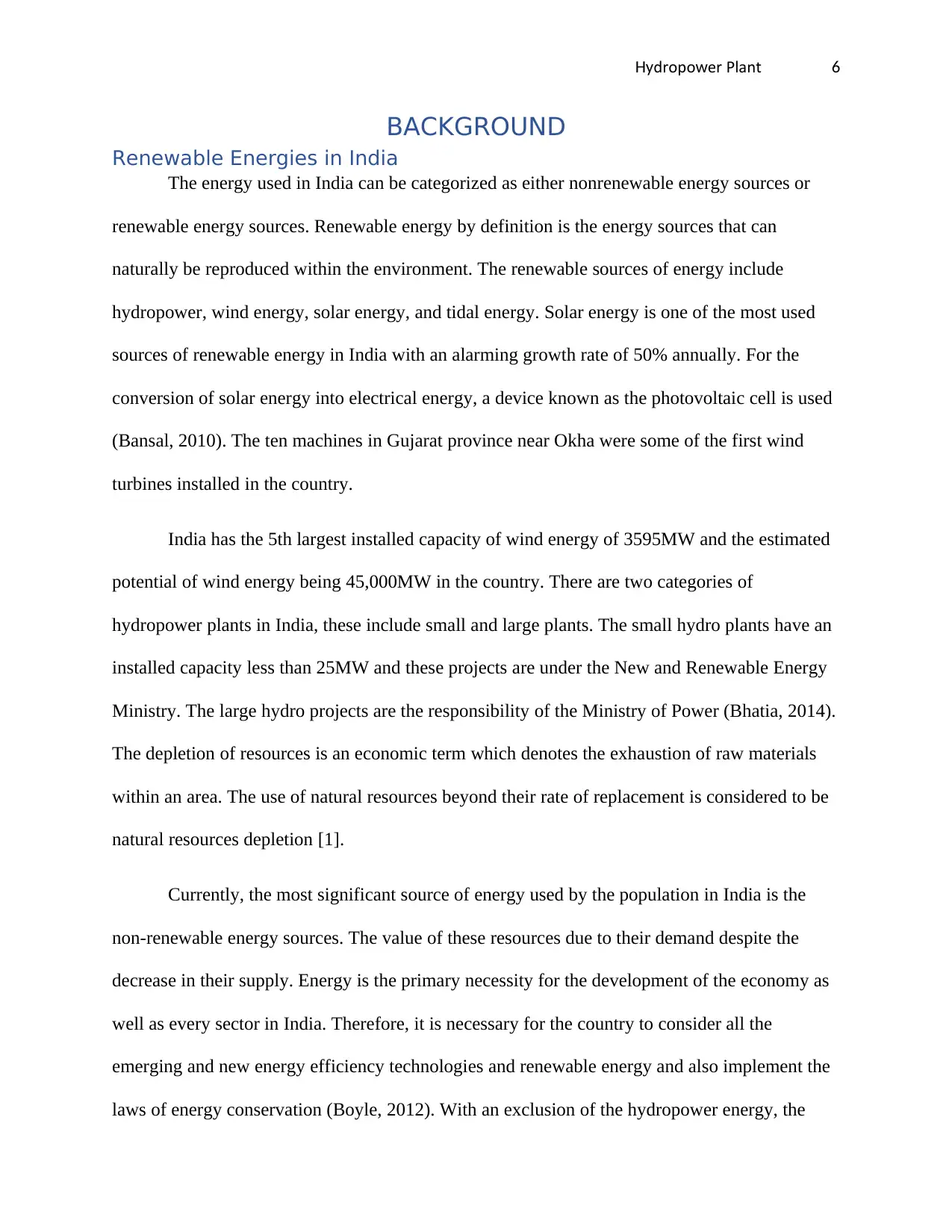
dropo er PlantHy w 6
BACKGROUND
Renewable Energies in India
The energy used in India can be categorized as either nonrenewable energy sources or
renewable energy sources. Renewable energy by definition is the energy sources that can
naturally be reproduced within the environment. The renewable sources of energy include
hydropower, wind energy, solar energy, and tidal energy. Solar energy is one of the most used
sources of renewable energy in India with an alarming growth rate of 50% annually. For the
conversion of solar energy into electrical energy, a device known as the photovoltaic cell is used
(Bansal, 2010). The ten machines in Gujarat province near Okha were some of the first wind
turbines installed in the country.
India has the 5th largest installed capacity of wind energy of 3595MW and the estimated
potential of wind energy being 45,000MW in the country. There are two categories of
hydropower plants in India, these include small and large plants. The small hydro plants have an
installed capacity less than 25MW and these projects are under the New and Renewable Energy
Ministry. The large hydro projects are the responsibility of the Ministry of Power (Bhatia, 2014).
The depletion of resources is an economic term which denotes the exhaustion of raw materials
within an area. The use of natural resources beyond their rate of replacement is considered to be
natural resources depletion [1].
Currently, the most significant source of energy used by the population in India is the
non-renewable energy sources. The value of these resources due to their demand despite the
decrease in their supply. Energy is the primary necessity for the development of the economy as
well as every sector in India. Therefore, it is necessary for the country to consider all the
emerging and new energy efficiency technologies and renewable energy and also implement the
laws of energy conservation (Boyle, 2012). With an exclusion of the hydropower energy, the
BACKGROUND
Renewable Energies in India
The energy used in India can be categorized as either nonrenewable energy sources or
renewable energy sources. Renewable energy by definition is the energy sources that can
naturally be reproduced within the environment. The renewable sources of energy include
hydropower, wind energy, solar energy, and tidal energy. Solar energy is one of the most used
sources of renewable energy in India with an alarming growth rate of 50% annually. For the
conversion of solar energy into electrical energy, a device known as the photovoltaic cell is used
(Bansal, 2010). The ten machines in Gujarat province near Okha were some of the first wind
turbines installed in the country.
India has the 5th largest installed capacity of wind energy of 3595MW and the estimated
potential of wind energy being 45,000MW in the country. There are two categories of
hydropower plants in India, these include small and large plants. The small hydro plants have an
installed capacity less than 25MW and these projects are under the New and Renewable Energy
Ministry. The large hydro projects are the responsibility of the Ministry of Power (Bhatia, 2014).
The depletion of resources is an economic term which denotes the exhaustion of raw materials
within an area. The use of natural resources beyond their rate of replacement is considered to be
natural resources depletion [1].
Currently, the most significant source of energy used by the population in India is the
non-renewable energy sources. The value of these resources due to their demand despite the
decrease in their supply. Energy is the primary necessity for the development of the economy as
well as every sector in India. Therefore, it is necessary for the country to consider all the
emerging and new energy efficiency technologies and renewable energy and also implement the
laws of energy conservation (Boyle, 2012). With an exclusion of the hydropower energy, the
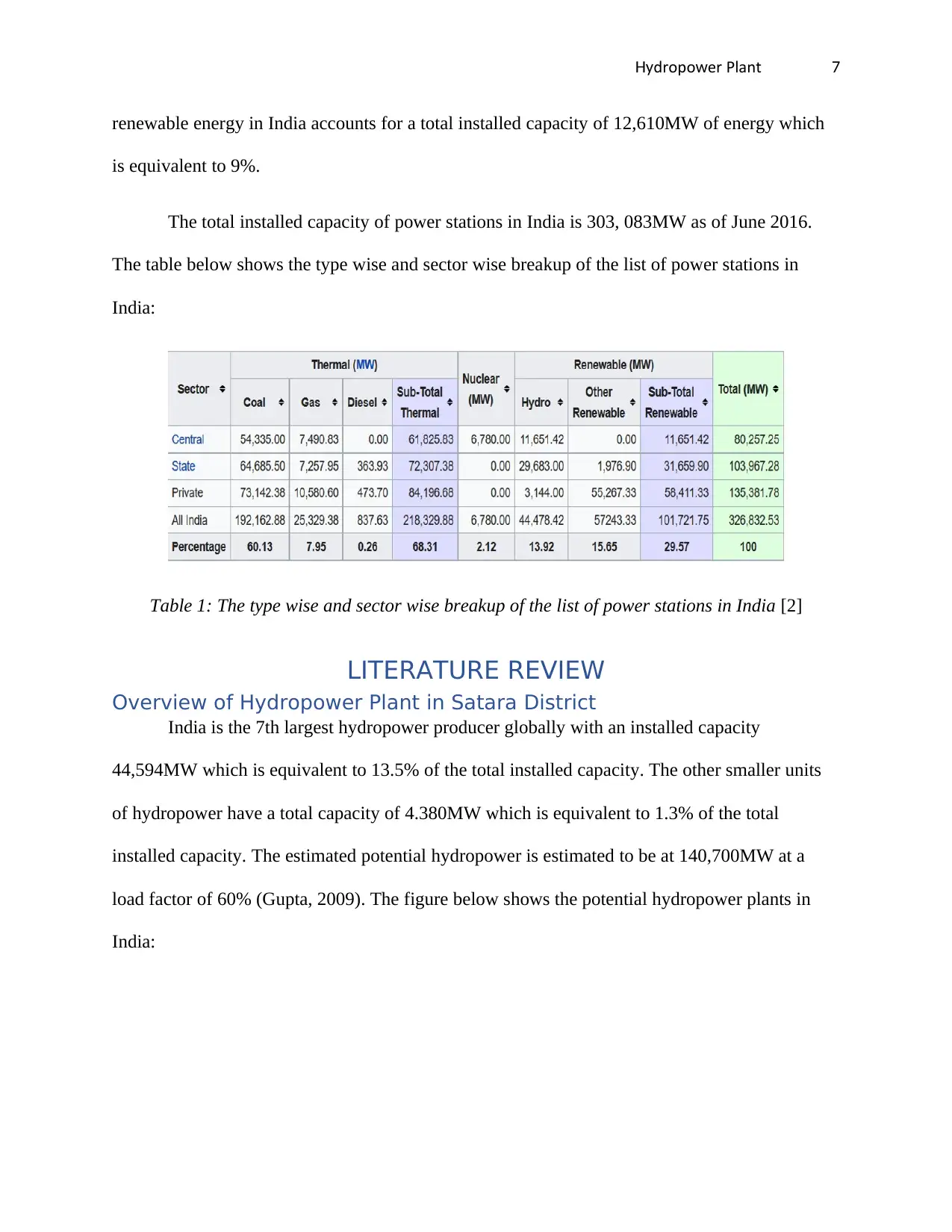
dropo er PlantHy w 7
renewable energy in India accounts for a total installed capacity of 12,610MW of energy which
is equivalent to 9%.
The total installed capacity of power stations in India is 303, 083MW as of June 2016.
The table below shows the type wise and sector wise breakup of the list of power stations in
India:
Table 1: The type wise and sector wise breakup of the list of power stations in India [2]
LITERATURE REVIEW
Overview of Hydropower Plant in Satara District
India is the 7th largest hydropower producer globally with an installed capacity
44,594MW which is equivalent to 13.5% of the total installed capacity. The other smaller units
of hydropower have a total capacity of 4.380MW which is equivalent to 1.3% of the total
installed capacity. The estimated potential hydropower is estimated to be at 140,700MW at a
load factor of 60% (Gupta, 2009). The figure below shows the potential hydropower plants in
India:
renewable energy in India accounts for a total installed capacity of 12,610MW of energy which
is equivalent to 9%.
The total installed capacity of power stations in India is 303, 083MW as of June 2016.
The table below shows the type wise and sector wise breakup of the list of power stations in
India:
Table 1: The type wise and sector wise breakup of the list of power stations in India [2]
LITERATURE REVIEW
Overview of Hydropower Plant in Satara District
India is the 7th largest hydropower producer globally with an installed capacity
44,594MW which is equivalent to 13.5% of the total installed capacity. The other smaller units
of hydropower have a total capacity of 4.380MW which is equivalent to 1.3% of the total
installed capacity. The estimated potential hydropower is estimated to be at 140,700MW at a
load factor of 60% (Gupta, 2009). The figure below shows the potential hydropower plants in
India:
Paraphrase This Document
Need a fresh take? Get an instant paraphrase of this document with our AI Paraphraser
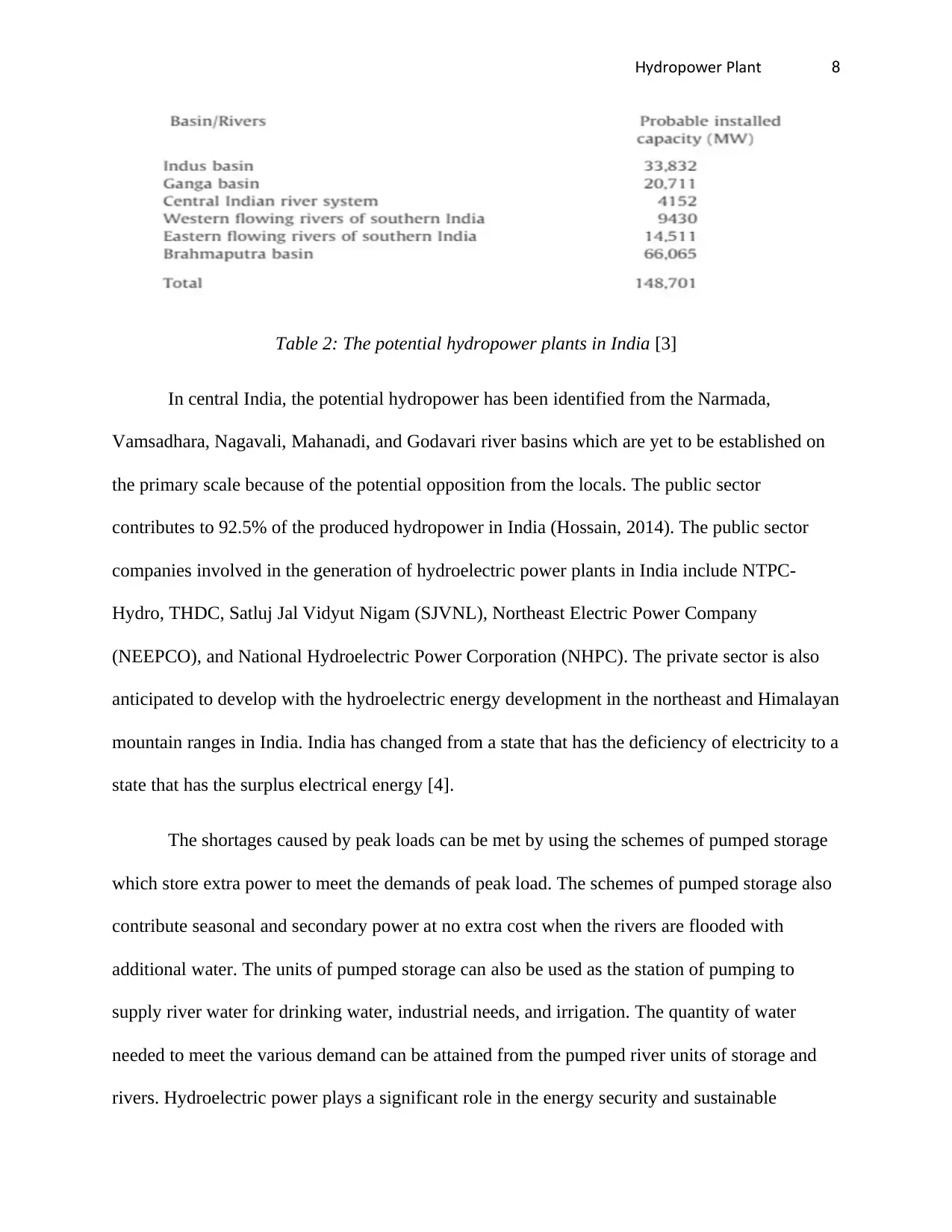
dropo er PlantHy w 8
Table 2: The potential hydropower plants in India [3]
In central India, the potential hydropower has been identified from the Narmada,
Vamsadhara, Nagavali, Mahanadi, and Godavari river basins which are yet to be established on
the primary scale because of the potential opposition from the locals. The public sector
contributes to 92.5% of the produced hydropower in India (Hossain, 2014). The public sector
companies involved in the generation of hydroelectric power plants in India include NTPC-
Hydro, THDC, Satluj Jal Vidyut Nigam (SJVNL), Northeast Electric Power Company
(NEEPCO), and National Hydroelectric Power Corporation (NHPC). The private sector is also
anticipated to develop with the hydroelectric energy development in the northeast and Himalayan
mountain ranges in India. India has changed from a state that has the deficiency of electricity to a
state that has the surplus electrical energy [4].
The shortages caused by peak loads can be met by using the schemes of pumped storage
which store extra power to meet the demands of peak load. The schemes of pumped storage also
contribute seasonal and secondary power at no extra cost when the rivers are flooded with
additional water. The units of pumped storage can also be used as the station of pumping to
supply river water for drinking water, industrial needs, and irrigation. The quantity of water
needed to meet the various demand can be attained from the pumped river units of storage and
rivers. Hydroelectric power plays a significant role in the energy security and sustainable
Table 2: The potential hydropower plants in India [3]
In central India, the potential hydropower has been identified from the Narmada,
Vamsadhara, Nagavali, Mahanadi, and Godavari river basins which are yet to be established on
the primary scale because of the potential opposition from the locals. The public sector
contributes to 92.5% of the produced hydropower in India (Hossain, 2014). The public sector
companies involved in the generation of hydroelectric power plants in India include NTPC-
Hydro, THDC, Satluj Jal Vidyut Nigam (SJVNL), Northeast Electric Power Company
(NEEPCO), and National Hydroelectric Power Corporation (NHPC). The private sector is also
anticipated to develop with the hydroelectric energy development in the northeast and Himalayan
mountain ranges in India. India has changed from a state that has the deficiency of electricity to a
state that has the surplus electrical energy [4].
The shortages caused by peak loads can be met by using the schemes of pumped storage
which store extra power to meet the demands of peak load. The schemes of pumped storage also
contribute seasonal and secondary power at no extra cost when the rivers are flooded with
additional water. The units of pumped storage can also be used as the station of pumping to
supply river water for drinking water, industrial needs, and irrigation. The quantity of water
needed to meet the various demand can be attained from the pumped river units of storage and
rivers. Hydroelectric power plays a significant role in the energy security and sustainable
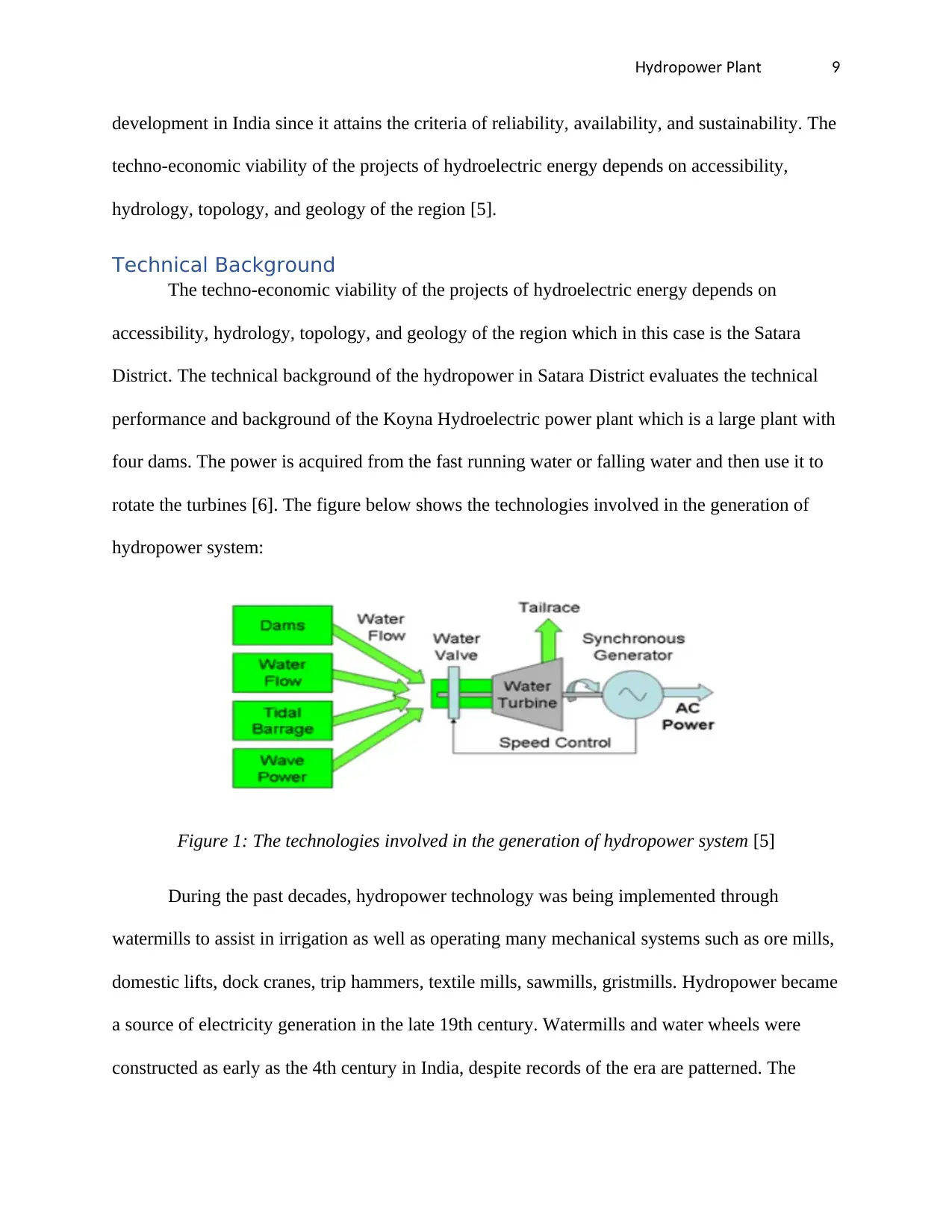
dropo er PlantHy w 9
development in India since it attains the criteria of reliability, availability, and sustainability. The
techno-economic viability of the projects of hydroelectric energy depends on accessibility,
hydrology, topology, and geology of the region [5].
Technical Background
The techno-economic viability of the projects of hydroelectric energy depends on
accessibility, hydrology, topology, and geology of the region which in this case is the Satara
District. The technical background of the hydropower in Satara District evaluates the technical
performance and background of the Koyna Hydroelectric power plant which is a large plant with
four dams. The power is acquired from the fast running water or falling water and then use it to
rotate the turbines [6]. The figure below shows the technologies involved in the generation of
hydropower system:
Figure 1: The technologies involved in the generation of hydropower system [5]
During the past decades, hydropower technology was being implemented through
watermills to assist in irrigation as well as operating many mechanical systems such as ore mills,
domestic lifts, dock cranes, trip hammers, textile mills, sawmills, gristmills. Hydropower became
a source of electricity generation in the late 19th century. Watermills and water wheels were
constructed as early as the 4th century in India, despite records of the era are patterned. The
development in India since it attains the criteria of reliability, availability, and sustainability. The
techno-economic viability of the projects of hydroelectric energy depends on accessibility,
hydrology, topology, and geology of the region [5].
Technical Background
The techno-economic viability of the projects of hydroelectric energy depends on
accessibility, hydrology, topology, and geology of the region which in this case is the Satara
District. The technical background of the hydropower in Satara District evaluates the technical
performance and background of the Koyna Hydroelectric power plant which is a large plant with
four dams. The power is acquired from the fast running water or falling water and then use it to
rotate the turbines [6]. The figure below shows the technologies involved in the generation of
hydropower system:
Figure 1: The technologies involved in the generation of hydropower system [5]
During the past decades, hydropower technology was being implemented through
watermills to assist in irrigation as well as operating many mechanical systems such as ore mills,
domestic lifts, dock cranes, trip hammers, textile mills, sawmills, gristmills. Hydropower became
a source of electricity generation in the late 19th century. Watermills and water wheels were
constructed as early as the 4th century in India, despite records of the era are patterned. The
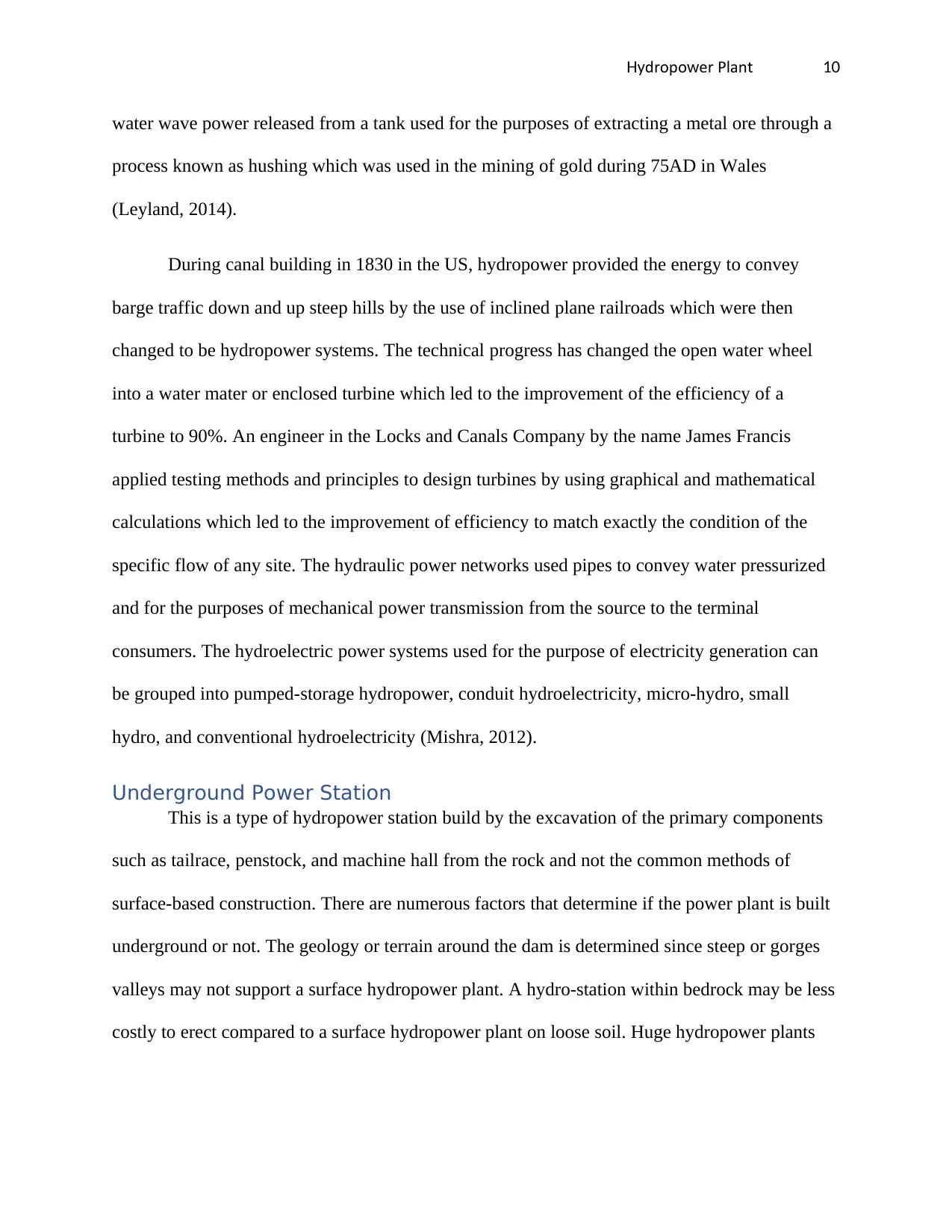
dropo er PlantHy w 10
water wave power released from a tank used for the purposes of extracting a metal ore through a
process known as hushing which was used in the mining of gold during 75AD in Wales
(Leyland, 2014).
During canal building in 1830 in the US, hydropower provided the energy to convey
barge traffic down and up steep hills by the use of inclined plane railroads which were then
changed to be hydropower systems. The technical progress has changed the open water wheel
into a water mater or enclosed turbine which led to the improvement of the efficiency of a
turbine to 90%. An engineer in the Locks and Canals Company by the name James Francis
applied testing methods and principles to design turbines by using graphical and mathematical
calculations which led to the improvement of efficiency to match exactly the condition of the
specific flow of any site. The hydraulic power networks used pipes to convey water pressurized
and for the purposes of mechanical power transmission from the source to the terminal
consumers. The hydroelectric power systems used for the purpose of electricity generation can
be grouped into pumped-storage hydropower, conduit hydroelectricity, micro-hydro, small
hydro, and conventional hydroelectricity (Mishra, 2012).
Underground Power Station
This is a type of hydropower station build by the excavation of the primary components
such as tailrace, penstock, and machine hall from the rock and not the common methods of
surface-based construction. There are numerous factors that determine if the power plant is built
underground or not. The geology or terrain around the dam is determined since steep or gorges
valleys may not support a surface hydropower plant. A hydro-station within bedrock may be less
costly to erect compared to a surface hydropower plant on loose soil. Huge hydropower plants
water wave power released from a tank used for the purposes of extracting a metal ore through a
process known as hushing which was used in the mining of gold during 75AD in Wales
(Leyland, 2014).
During canal building in 1830 in the US, hydropower provided the energy to convey
barge traffic down and up steep hills by the use of inclined plane railroads which were then
changed to be hydropower systems. The technical progress has changed the open water wheel
into a water mater or enclosed turbine which led to the improvement of the efficiency of a
turbine to 90%. An engineer in the Locks and Canals Company by the name James Francis
applied testing methods and principles to design turbines by using graphical and mathematical
calculations which led to the improvement of efficiency to match exactly the condition of the
specific flow of any site. The hydraulic power networks used pipes to convey water pressurized
and for the purposes of mechanical power transmission from the source to the terminal
consumers. The hydroelectric power systems used for the purpose of electricity generation can
be grouped into pumped-storage hydropower, conduit hydroelectricity, micro-hydro, small
hydro, and conventional hydroelectricity (Mishra, 2012).
Underground Power Station
This is a type of hydropower station build by the excavation of the primary components
such as tailrace, penstock, and machine hall from the rock and not the common methods of
surface-based construction. There are numerous factors that determine if the power plant is built
underground or not. The geology or terrain around the dam is determined since steep or gorges
valleys may not support a surface hydropower plant. A hydro-station within bedrock may be less
costly to erect compared to a surface hydropower plant on loose soil. Huge hydropower plants
Secure Best Marks with AI Grader
Need help grading? Try our AI Grader for instant feedback on your assignments.
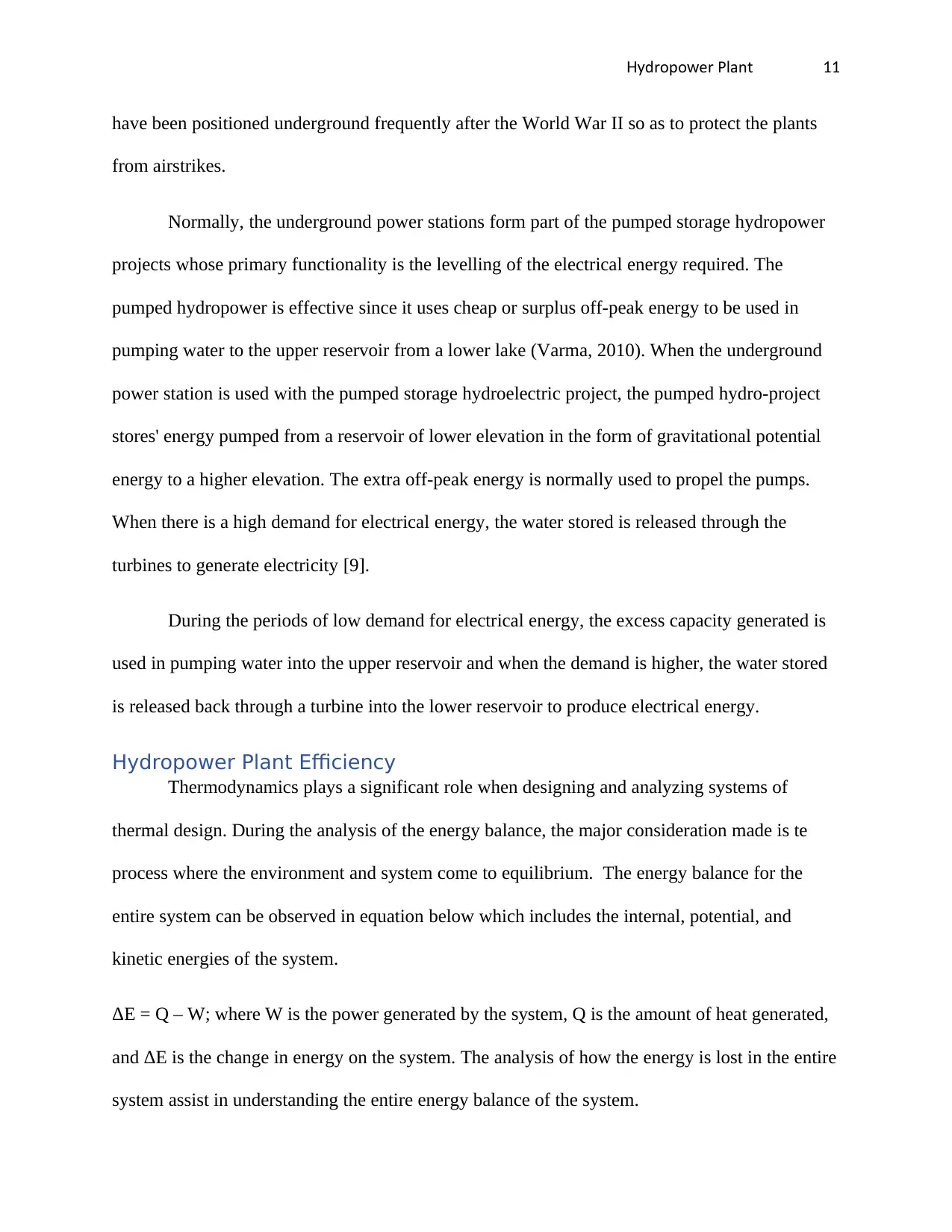
dropo er PlantHy w 11
have been positioned underground frequently after the World War II so as to protect the plants
from airstrikes.
Normally, the underground power stations form part of the pumped storage hydropower
projects whose primary functionality is the levelling of the electrical energy required. The
pumped hydropower is effective since it uses cheap or surplus off-peak energy to be used in
pumping water to the upper reservoir from a lower lake (Varma, 2010). When the underground
power station is used with the pumped storage hydroelectric project, the pumped hydro-project
stores' energy pumped from a reservoir of lower elevation in the form of gravitational potential
energy to a higher elevation. The extra off-peak energy is normally used to propel the pumps.
When there is a high demand for electrical energy, the water stored is released through the
turbines to generate electricity [9].
During the periods of low demand for electrical energy, the excess capacity generated is
used in pumping water into the upper reservoir and when the demand is higher, the water stored
is released back through a turbine into the lower reservoir to produce electrical energy.
Hydropower Plant Efficiency
Thermodynamics plays a significant role when designing and analyzing systems of
thermal design. During the analysis of the energy balance, the major consideration made is te
process where the environment and system come to equilibrium. The energy balance for the
entire system can be observed in equation below which includes the internal, potential, and
kinetic energies of the system.
ΔE = Q – W; where W is the power generated by the system, Q is the amount of heat generated,
and ΔE is the change in energy on the system. The analysis of how the energy is lost in the entire
system assist in understanding the entire energy balance of the system.
have been positioned underground frequently after the World War II so as to protect the plants
from airstrikes.
Normally, the underground power stations form part of the pumped storage hydropower
projects whose primary functionality is the levelling of the electrical energy required. The
pumped hydropower is effective since it uses cheap or surplus off-peak energy to be used in
pumping water to the upper reservoir from a lower lake (Varma, 2010). When the underground
power station is used with the pumped storage hydroelectric project, the pumped hydro-project
stores' energy pumped from a reservoir of lower elevation in the form of gravitational potential
energy to a higher elevation. The extra off-peak energy is normally used to propel the pumps.
When there is a high demand for electrical energy, the water stored is released through the
turbines to generate electricity [9].
During the periods of low demand for electrical energy, the excess capacity generated is
used in pumping water into the upper reservoir and when the demand is higher, the water stored
is released back through a turbine into the lower reservoir to produce electrical energy.
Hydropower Plant Efficiency
Thermodynamics plays a significant role when designing and analyzing systems of
thermal design. During the analysis of the energy balance, the major consideration made is te
process where the environment and system come to equilibrium. The energy balance for the
entire system can be observed in equation below which includes the internal, potential, and
kinetic energies of the system.
ΔE = Q – W; where W is the power generated by the system, Q is the amount of heat generated,
and ΔE is the change in energy on the system. The analysis of how the energy is lost in the entire
system assist in understanding the entire energy balance of the system.
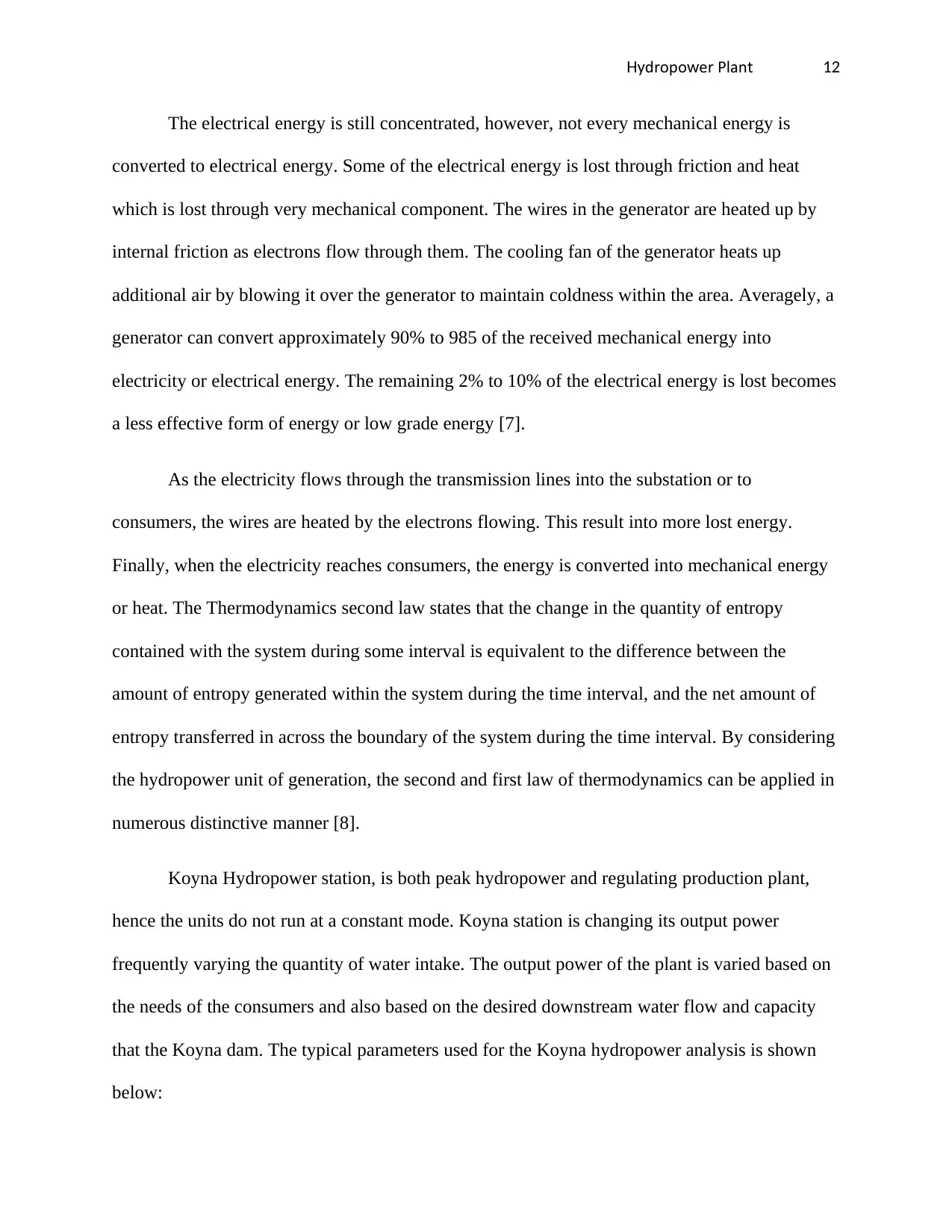
dropo er PlantHy w 12
The electrical energy is still concentrated, however, not every mechanical energy is
converted to electrical energy. Some of the electrical energy is lost through friction and heat
which is lost through very mechanical component. The wires in the generator are heated up by
internal friction as electrons flow through them. The cooling fan of the generator heats up
additional air by blowing it over the generator to maintain coldness within the area. Averagely, a
generator can convert approximately 90% to 985 of the received mechanical energy into
electricity or electrical energy. The remaining 2% to 10% of the electrical energy is lost becomes
a less effective form of energy or low grade energy [7].
As the electricity flows through the transmission lines into the substation or to
consumers, the wires are heated by the electrons flowing. This result into more lost energy.
Finally, when the electricity reaches consumers, the energy is converted into mechanical energy
or heat. The Thermodynamics second law states that the change in the quantity of entropy
contained with the system during some interval is equivalent to the difference between the
amount of entropy generated within the system during the time interval, and the net amount of
entropy transferred in across the boundary of the system during the time interval. By considering
the hydropower unit of generation, the second and first law of thermodynamics can be applied in
numerous distinctive manner [8].
Koyna Hydropower station, is both peak hydropower and regulating production plant,
hence the units do not run at a constant mode. Koyna station is changing its output power
frequently varying the quantity of water intake. The output power of the plant is varied based on
the needs of the consumers and also based on the desired downstream water flow and capacity
that the Koyna dam. The typical parameters used for the Koyna hydropower analysis is shown
below:
The electrical energy is still concentrated, however, not every mechanical energy is
converted to electrical energy. Some of the electrical energy is lost through friction and heat
which is lost through very mechanical component. The wires in the generator are heated up by
internal friction as electrons flow through them. The cooling fan of the generator heats up
additional air by blowing it over the generator to maintain coldness within the area. Averagely, a
generator can convert approximately 90% to 985 of the received mechanical energy into
electricity or electrical energy. The remaining 2% to 10% of the electrical energy is lost becomes
a less effective form of energy or low grade energy [7].
As the electricity flows through the transmission lines into the substation or to
consumers, the wires are heated by the electrons flowing. This result into more lost energy.
Finally, when the electricity reaches consumers, the energy is converted into mechanical energy
or heat. The Thermodynamics second law states that the change in the quantity of entropy
contained with the system during some interval is equivalent to the difference between the
amount of entropy generated within the system during the time interval, and the net amount of
entropy transferred in across the boundary of the system during the time interval. By considering
the hydropower unit of generation, the second and first law of thermodynamics can be applied in
numerous distinctive manner [8].
Koyna Hydropower station, is both peak hydropower and regulating production plant,
hence the units do not run at a constant mode. Koyna station is changing its output power
frequently varying the quantity of water intake. The output power of the plant is varied based on
the needs of the consumers and also based on the desired downstream water flow and capacity
that the Koyna dam. The typical parameters used for the Koyna hydropower analysis is shown
below:
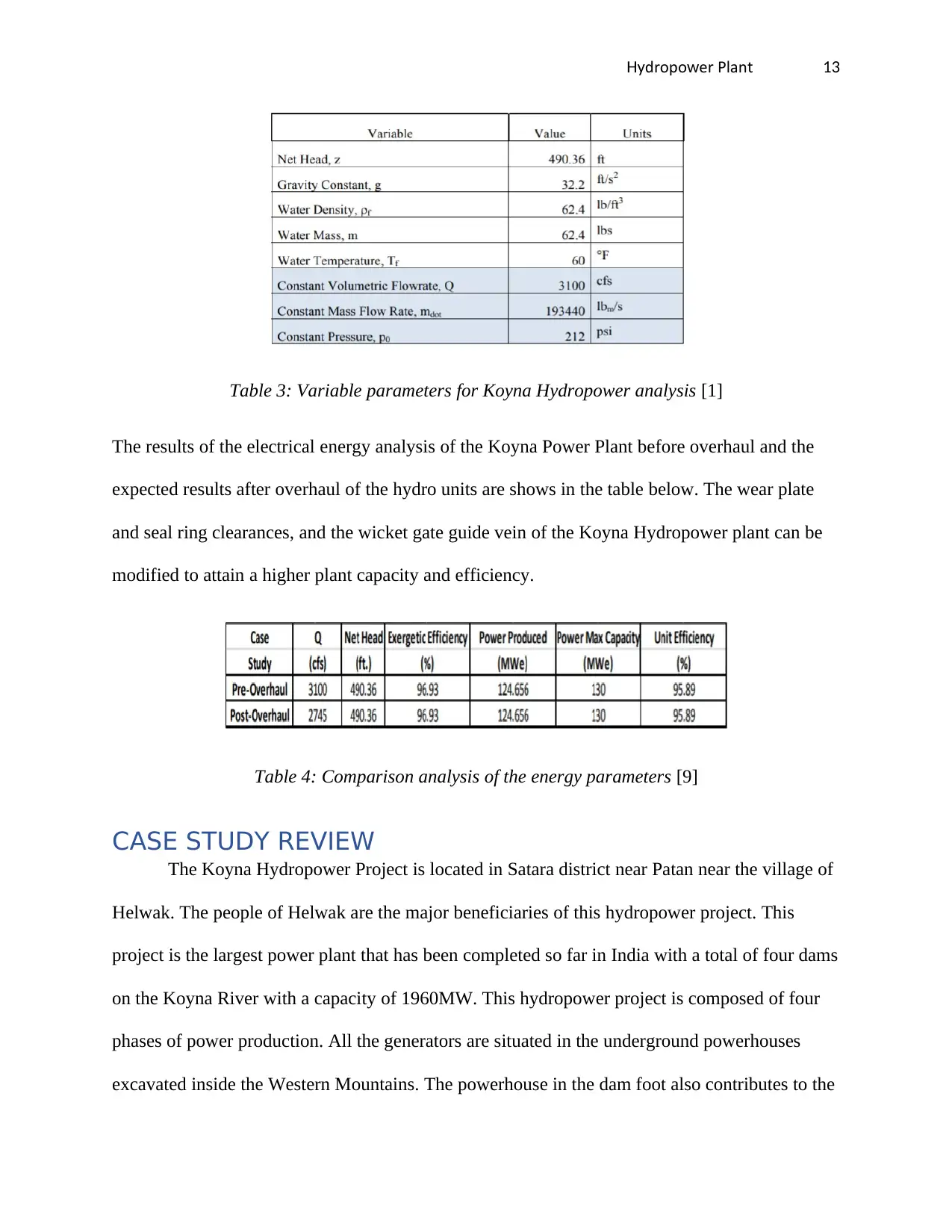
dropo er PlantHy w 13
Table 3: Variable parameters for Koyna Hydropower analysis [1]
The results of the electrical energy analysis of the Koyna Power Plant before overhaul and the
expected results after overhaul of the hydro units are shows in the table below. The wear plate
and seal ring clearances, and the wicket gate guide vein of the Koyna Hydropower plant can be
modified to attain a higher plant capacity and efficiency.
Table 4: Comparison analysis of the energy parameters [9]
CASE STUDY REVIEW
The Koyna Hydropower Project is located in Satara district near Patan near the village of
Helwak. The people of Helwak are the major beneficiaries of this hydropower project. This
project is the largest power plant that has been completed so far in India with a total of four dams
on the Koyna River with a capacity of 1960MW. This hydropower project is composed of four
phases of power production. All the generators are situated in the underground powerhouses
excavated inside the Western Mountains. The powerhouse in the dam foot also contributes to the
Table 3: Variable parameters for Koyna Hydropower analysis [1]
The results of the electrical energy analysis of the Koyna Power Plant before overhaul and the
expected results after overhaul of the hydro units are shows in the table below. The wear plate
and seal ring clearances, and the wicket gate guide vein of the Koyna Hydropower plant can be
modified to attain a higher plant capacity and efficiency.
Table 4: Comparison analysis of the energy parameters [9]
CASE STUDY REVIEW
The Koyna Hydropower Project is located in Satara district near Patan near the village of
Helwak. The people of Helwak are the major beneficiaries of this hydropower project. This
project is the largest power plant that has been completed so far in India with a total of four dams
on the Koyna River with a capacity of 1960MW. This hydropower project is composed of four
phases of power production. All the generators are situated in the underground powerhouses
excavated inside the Western Mountains. The powerhouse in the dam foot also contributes to the
Paraphrase This Document
Need a fresh take? Get an instant paraphrase of this document with our AI Paraphraser
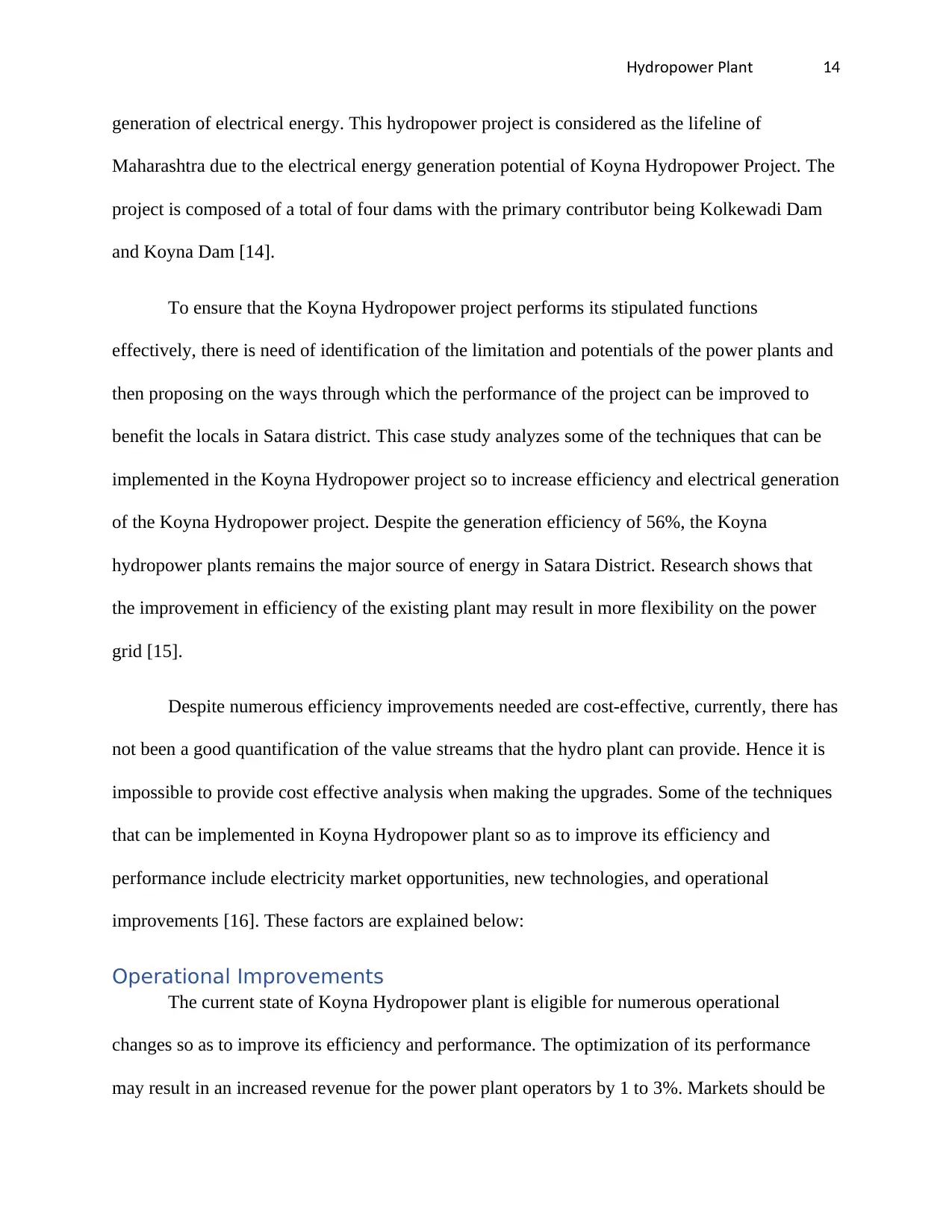
dropo er PlantHy w 14
generation of electrical energy. This hydropower project is considered as the lifeline of
Maharashtra due to the electrical energy generation potential of Koyna Hydropower Project. The
project is composed of a total of four dams with the primary contributor being Kolkewadi Dam
and Koyna Dam [14].
To ensure that the Koyna Hydropower project performs its stipulated functions
effectively, there is need of identification of the limitation and potentials of the power plants and
then proposing on the ways through which the performance of the project can be improved to
benefit the locals in Satara district. This case study analyzes some of the techniques that can be
implemented in the Koyna Hydropower project so to increase efficiency and electrical generation
of the Koyna Hydropower project. Despite the generation efficiency of 56%, the Koyna
hydropower plants remains the major source of energy in Satara District. Research shows that
the improvement in efficiency of the existing plant may result in more flexibility on the power
grid [15].
Despite numerous efficiency improvements needed are cost-effective, currently, there has
not been a good quantification of the value streams that the hydro plant can provide. Hence it is
impossible to provide cost effective analysis when making the upgrades. Some of the techniques
that can be implemented in Koyna Hydropower plant so as to improve its efficiency and
performance include electricity market opportunities, new technologies, and operational
improvements [16]. These factors are explained below:
Operational Improvements
The current state of Koyna Hydropower plant is eligible for numerous operational
changes so as to improve its efficiency and performance. The optimization of its performance
may result in an increased revenue for the power plant operators by 1 to 3%. Markets should be
generation of electrical energy. This hydropower project is considered as the lifeline of
Maharashtra due to the electrical energy generation potential of Koyna Hydropower Project. The
project is composed of a total of four dams with the primary contributor being Kolkewadi Dam
and Koyna Dam [14].
To ensure that the Koyna Hydropower project performs its stipulated functions
effectively, there is need of identification of the limitation and potentials of the power plants and
then proposing on the ways through which the performance of the project can be improved to
benefit the locals in Satara district. This case study analyzes some of the techniques that can be
implemented in the Koyna Hydropower project so to increase efficiency and electrical generation
of the Koyna Hydropower project. Despite the generation efficiency of 56%, the Koyna
hydropower plants remains the major source of energy in Satara District. Research shows that
the improvement in efficiency of the existing plant may result in more flexibility on the power
grid [15].
Despite numerous efficiency improvements needed are cost-effective, currently, there has
not been a good quantification of the value streams that the hydro plant can provide. Hence it is
impossible to provide cost effective analysis when making the upgrades. Some of the techniques
that can be implemented in Koyna Hydropower plant so as to improve its efficiency and
performance include electricity market opportunities, new technologies, and operational
improvements [16]. These factors are explained below:
Operational Improvements
The current state of Koyna Hydropower plant is eligible for numerous operational
changes so as to improve its efficiency and performance. The optimization of its performance
may result in an increased revenue for the power plant operators by 1 to 3%. Markets should be
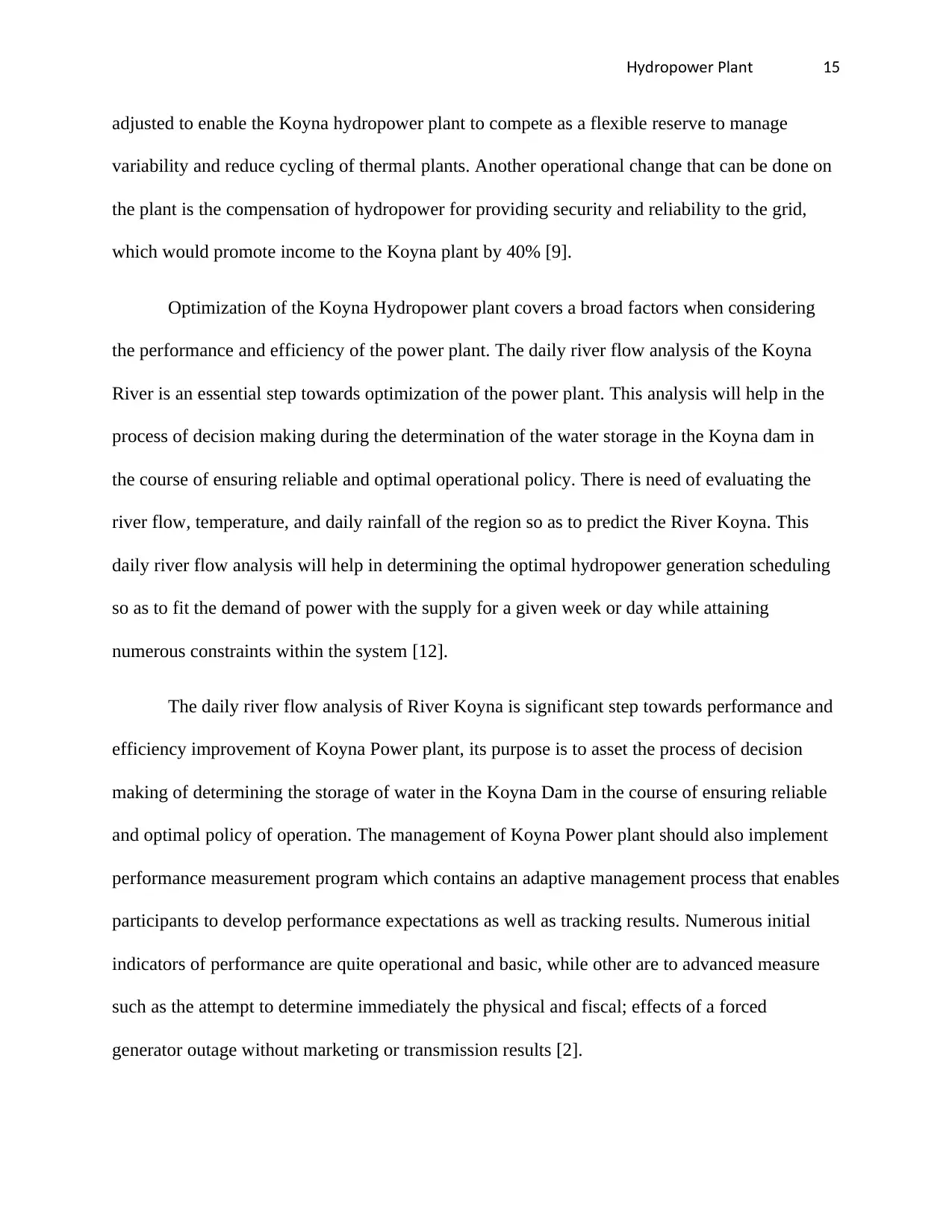
dropo er PlantHy w 15
adjusted to enable the Koyna hydropower plant to compete as a flexible reserve to manage
variability and reduce cycling of thermal plants. Another operational change that can be done on
the plant is the compensation of hydropower for providing security and reliability to the grid,
which would promote income to the Koyna plant by 40% [9].
Optimization of the Koyna Hydropower plant covers a broad factors when considering
the performance and efficiency of the power plant. The daily river flow analysis of the Koyna
River is an essential step towards optimization of the power plant. This analysis will help in the
process of decision making during the determination of the water storage in the Koyna dam in
the course of ensuring reliable and optimal operational policy. There is need of evaluating the
river flow, temperature, and daily rainfall of the region so as to predict the River Koyna. This
daily river flow analysis will help in determining the optimal hydropower generation scheduling
so as to fit the demand of power with the supply for a given week or day while attaining
numerous constraints within the system [12].
The daily river flow analysis of River Koyna is significant step towards performance and
efficiency improvement of Koyna Power plant, its purpose is to asset the process of decision
making of determining the storage of water in the Koyna Dam in the course of ensuring reliable
and optimal policy of operation. The management of Koyna Power plant should also implement
performance measurement program which contains an adaptive management process that enables
participants to develop performance expectations as well as tracking results. Numerous initial
indicators of performance are quite operational and basic, while other are to advanced measure
such as the attempt to determine immediately the physical and fiscal; effects of a forced
generator outage without marketing or transmission results [2].
adjusted to enable the Koyna hydropower plant to compete as a flexible reserve to manage
variability and reduce cycling of thermal plants. Another operational change that can be done on
the plant is the compensation of hydropower for providing security and reliability to the grid,
which would promote income to the Koyna plant by 40% [9].
Optimization of the Koyna Hydropower plant covers a broad factors when considering
the performance and efficiency of the power plant. The daily river flow analysis of the Koyna
River is an essential step towards optimization of the power plant. This analysis will help in the
process of decision making during the determination of the water storage in the Koyna dam in
the course of ensuring reliable and optimal operational policy. There is need of evaluating the
river flow, temperature, and daily rainfall of the region so as to predict the River Koyna. This
daily river flow analysis will help in determining the optimal hydropower generation scheduling
so as to fit the demand of power with the supply for a given week or day while attaining
numerous constraints within the system [12].
The daily river flow analysis of River Koyna is significant step towards performance and
efficiency improvement of Koyna Power plant, its purpose is to asset the process of decision
making of determining the storage of water in the Koyna Dam in the course of ensuring reliable
and optimal policy of operation. The management of Koyna Power plant should also implement
performance measurement program which contains an adaptive management process that enables
participants to develop performance expectations as well as tracking results. Numerous initial
indicators of performance are quite operational and basic, while other are to advanced measure
such as the attempt to determine immediately the physical and fiscal; effects of a forced
generator outage without marketing or transmission results [2].
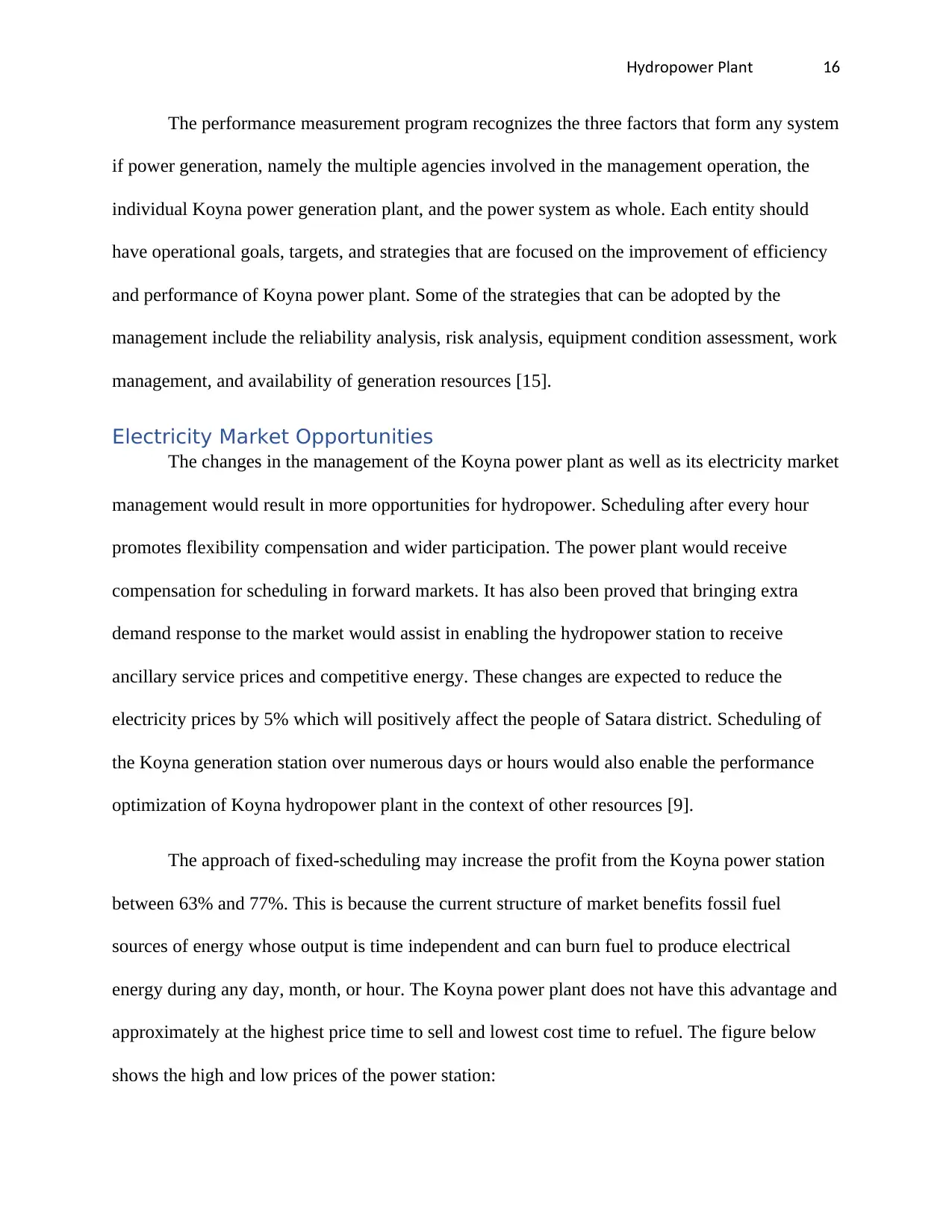
dropo er PlantHy w 16
The performance measurement program recognizes the three factors that form any system
if power generation, namely the multiple agencies involved in the management operation, the
individual Koyna power generation plant, and the power system as whole. Each entity should
have operational goals, targets, and strategies that are focused on the improvement of efficiency
and performance of Koyna power plant. Some of the strategies that can be adopted by the
management include the reliability analysis, risk analysis, equipment condition assessment, work
management, and availability of generation resources [15].
Electricity Market Opportunities
The changes in the management of the Koyna power plant as well as its electricity market
management would result in more opportunities for hydropower. Scheduling after every hour
promotes flexibility compensation and wider participation. The power plant would receive
compensation for scheduling in forward markets. It has also been proved that bringing extra
demand response to the market would assist in enabling the hydropower station to receive
ancillary service prices and competitive energy. These changes are expected to reduce the
electricity prices by 5% which will positively affect the people of Satara district. Scheduling of
the Koyna generation station over numerous days or hours would also enable the performance
optimization of Koyna hydropower plant in the context of other resources [9].
The approach of fixed-scheduling may increase the profit from the Koyna power station
between 63% and 77%. This is because the current structure of market benefits fossil fuel
sources of energy whose output is time independent and can burn fuel to produce electrical
energy during any day, month, or hour. The Koyna power plant does not have this advantage and
approximately at the highest price time to sell and lowest cost time to refuel. The figure below
shows the high and low prices of the power station:
The performance measurement program recognizes the three factors that form any system
if power generation, namely the multiple agencies involved in the management operation, the
individual Koyna power generation plant, and the power system as whole. Each entity should
have operational goals, targets, and strategies that are focused on the improvement of efficiency
and performance of Koyna power plant. Some of the strategies that can be adopted by the
management include the reliability analysis, risk analysis, equipment condition assessment, work
management, and availability of generation resources [15].
Electricity Market Opportunities
The changes in the management of the Koyna power plant as well as its electricity market
management would result in more opportunities for hydropower. Scheduling after every hour
promotes flexibility compensation and wider participation. The power plant would receive
compensation for scheduling in forward markets. It has also been proved that bringing extra
demand response to the market would assist in enabling the hydropower station to receive
ancillary service prices and competitive energy. These changes are expected to reduce the
electricity prices by 5% which will positively affect the people of Satara district. Scheduling of
the Koyna generation station over numerous days or hours would also enable the performance
optimization of Koyna hydropower plant in the context of other resources [9].
The approach of fixed-scheduling may increase the profit from the Koyna power station
between 63% and 77%. This is because the current structure of market benefits fossil fuel
sources of energy whose output is time independent and can burn fuel to produce electrical
energy during any day, month, or hour. The Koyna power plant does not have this advantage and
approximately at the highest price time to sell and lowest cost time to refuel. The figure below
shows the high and low prices of the power station:
Secure Best Marks with AI Grader
Need help grading? Try our AI Grader for instant feedback on your assignments.
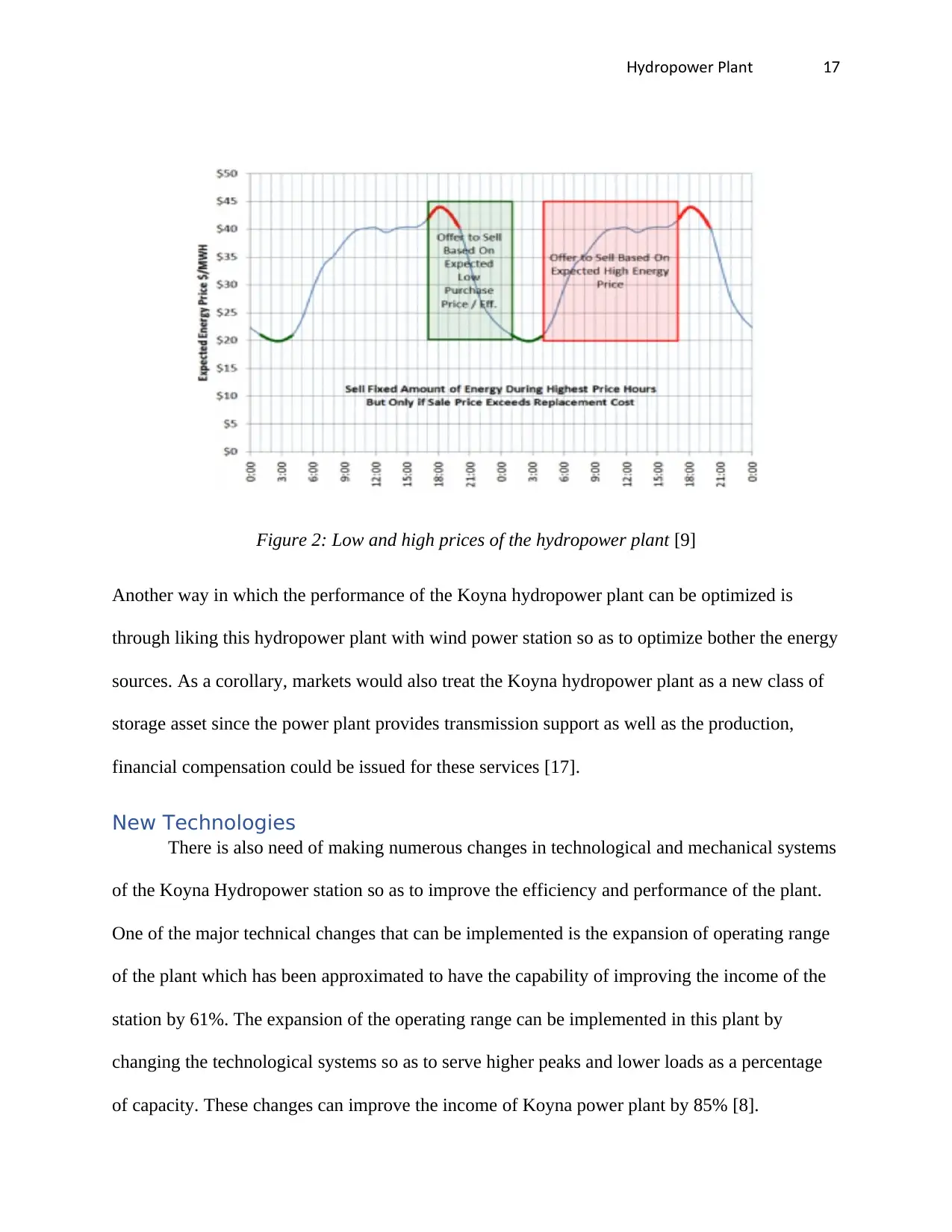
dropo er PlantHy w 17
Figure 2: Low and high prices of the hydropower plant [9]
Another way in which the performance of the Koyna hydropower plant can be optimized is
through liking this hydropower plant with wind power station so as to optimize bother the energy
sources. As a corollary, markets would also treat the Koyna hydropower plant as a new class of
storage asset since the power plant provides transmission support as well as the production,
financial compensation could be issued for these services [17].
New Technologies
There is also need of making numerous changes in technological and mechanical systems
of the Koyna Hydropower station so as to improve the efficiency and performance of the plant.
One of the major technical changes that can be implemented is the expansion of operating range
of the plant which has been approximated to have the capability of improving the income of the
station by 61%. The expansion of the operating range can be implemented in this plant by
changing the technological systems so as to serve higher peaks and lower loads as a percentage
of capacity. These changes can improve the income of Koyna power plant by 85% [8].
Figure 2: Low and high prices of the hydropower plant [9]
Another way in which the performance of the Koyna hydropower plant can be optimized is
through liking this hydropower plant with wind power station so as to optimize bother the energy
sources. As a corollary, markets would also treat the Koyna hydropower plant as a new class of
storage asset since the power plant provides transmission support as well as the production,
financial compensation could be issued for these services [17].
New Technologies
There is also need of making numerous changes in technological and mechanical systems
of the Koyna Hydropower station so as to improve the efficiency and performance of the plant.
One of the major technical changes that can be implemented is the expansion of operating range
of the plant which has been approximated to have the capability of improving the income of the
station by 61%. The expansion of the operating range can be implemented in this plant by
changing the technological systems so as to serve higher peaks and lower loads as a percentage
of capacity. These changes can improve the income of Koyna power plant by 85% [8].
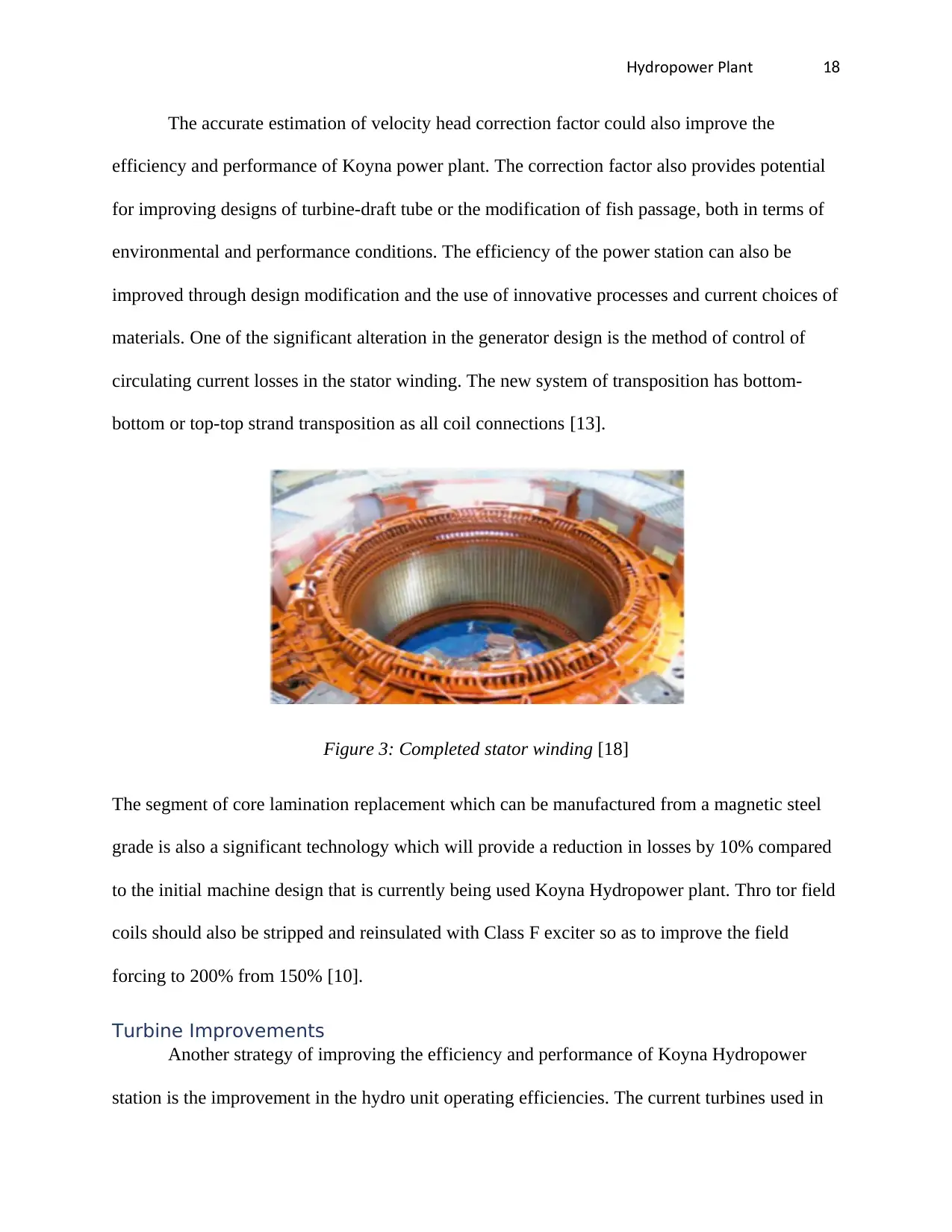
dropo er PlantHy w 18
The accurate estimation of velocity head correction factor could also improve the
efficiency and performance of Koyna power plant. The correction factor also provides potential
for improving designs of turbine-draft tube or the modification of fish passage, both in terms of
environmental and performance conditions. The efficiency of the power station can also be
improved through design modification and the use of innovative processes and current choices of
materials. One of the significant alteration in the generator design is the method of control of
circulating current losses in the stator winding. The new system of transposition has bottom-
bottom or top-top strand transposition as all coil connections [13].
Figure 3: Completed stator winding [18]
The segment of core lamination replacement which can be manufactured from a magnetic steel
grade is also a significant technology which will provide a reduction in losses by 10% compared
to the initial machine design that is currently being used Koyna Hydropower plant. Thro tor field
coils should also be stripped and reinsulated with Class F exciter so as to improve the field
forcing to 200% from 150% [10].
Turbine Improvements
Another strategy of improving the efficiency and performance of Koyna Hydropower
station is the improvement in the hydro unit operating efficiencies. The current turbines used in
The accurate estimation of velocity head correction factor could also improve the
efficiency and performance of Koyna power plant. The correction factor also provides potential
for improving designs of turbine-draft tube or the modification of fish passage, both in terms of
environmental and performance conditions. The efficiency of the power station can also be
improved through design modification and the use of innovative processes and current choices of
materials. One of the significant alteration in the generator design is the method of control of
circulating current losses in the stator winding. The new system of transposition has bottom-
bottom or top-top strand transposition as all coil connections [13].
Figure 3: Completed stator winding [18]
The segment of core lamination replacement which can be manufactured from a magnetic steel
grade is also a significant technology which will provide a reduction in losses by 10% compared
to the initial machine design that is currently being used Koyna Hydropower plant. Thro tor field
coils should also be stripped and reinsulated with Class F exciter so as to improve the field
forcing to 200% from 150% [10].
Turbine Improvements
Another strategy of improving the efficiency and performance of Koyna Hydropower
station is the improvement in the hydro unit operating efficiencies. The current turbines used in
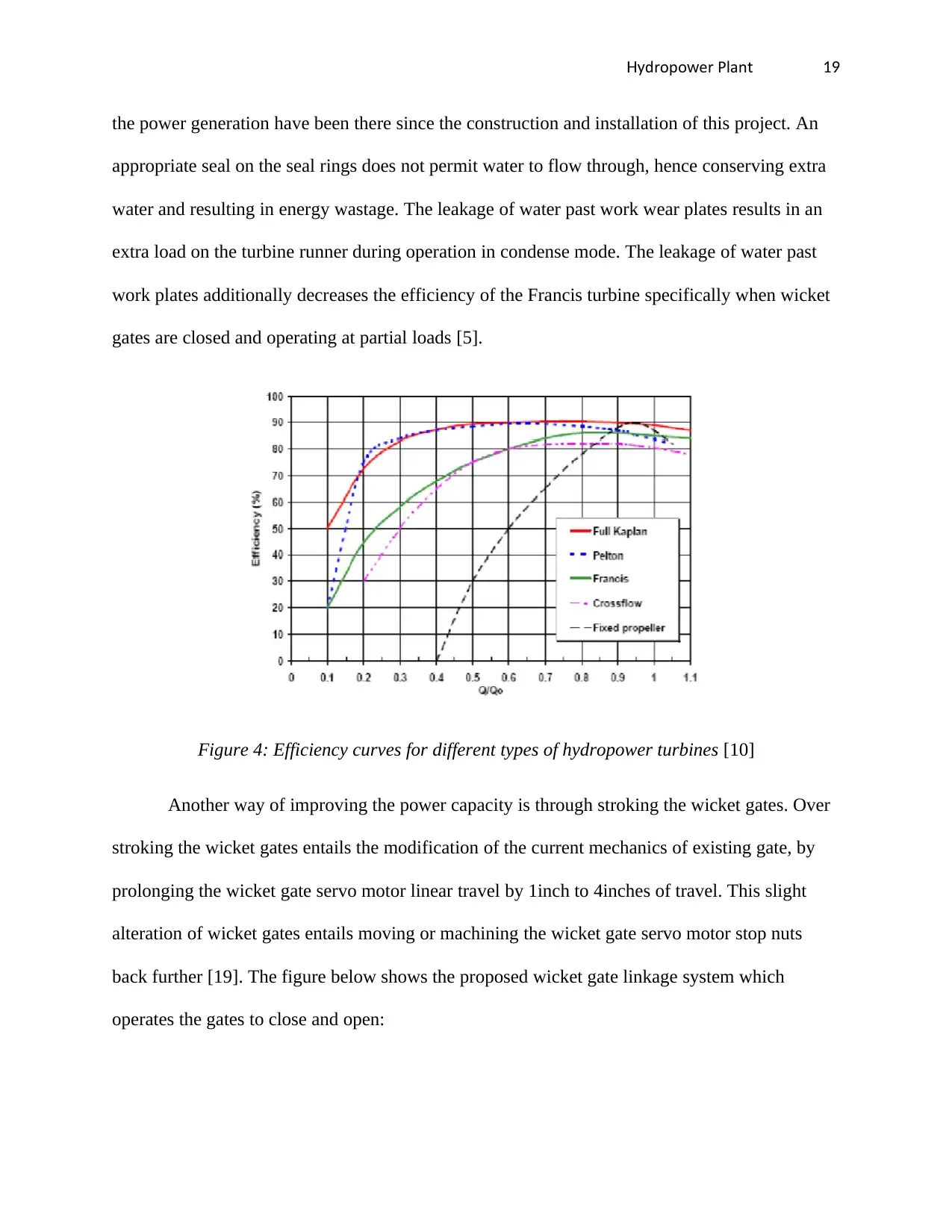
dropo er PlantHy w 19
the power generation have been there since the construction and installation of this project. An
appropriate seal on the seal rings does not permit water to flow through, hence conserving extra
water and resulting in energy wastage. The leakage of water past work wear plates results in an
extra load on the turbine runner during operation in condense mode. The leakage of water past
work plates additionally decreases the efficiency of the Francis turbine specifically when wicket
gates are closed and operating at partial loads [5].
Figure 4: Efficiency curves for different types of hydropower turbines [10]
Another way of improving the power capacity is through stroking the wicket gates. Over
stroking the wicket gates entails the modification of the current mechanics of existing gate, by
prolonging the wicket gate servo motor linear travel by 1inch to 4inches of travel. This slight
alteration of wicket gates entails moving or machining the wicket gate servo motor stop nuts
back further [19]. The figure below shows the proposed wicket gate linkage system which
operates the gates to close and open:
the power generation have been there since the construction and installation of this project. An
appropriate seal on the seal rings does not permit water to flow through, hence conserving extra
water and resulting in energy wastage. The leakage of water past work wear plates results in an
extra load on the turbine runner during operation in condense mode. The leakage of water past
work plates additionally decreases the efficiency of the Francis turbine specifically when wicket
gates are closed and operating at partial loads [5].
Figure 4: Efficiency curves for different types of hydropower turbines [10]
Another way of improving the power capacity is through stroking the wicket gates. Over
stroking the wicket gates entails the modification of the current mechanics of existing gate, by
prolonging the wicket gate servo motor linear travel by 1inch to 4inches of travel. This slight
alteration of wicket gates entails moving or machining the wicket gate servo motor stop nuts
back further [19]. The figure below shows the proposed wicket gate linkage system which
operates the gates to close and open:
Paraphrase This Document
Need a fresh take? Get an instant paraphrase of this document with our AI Paraphraser
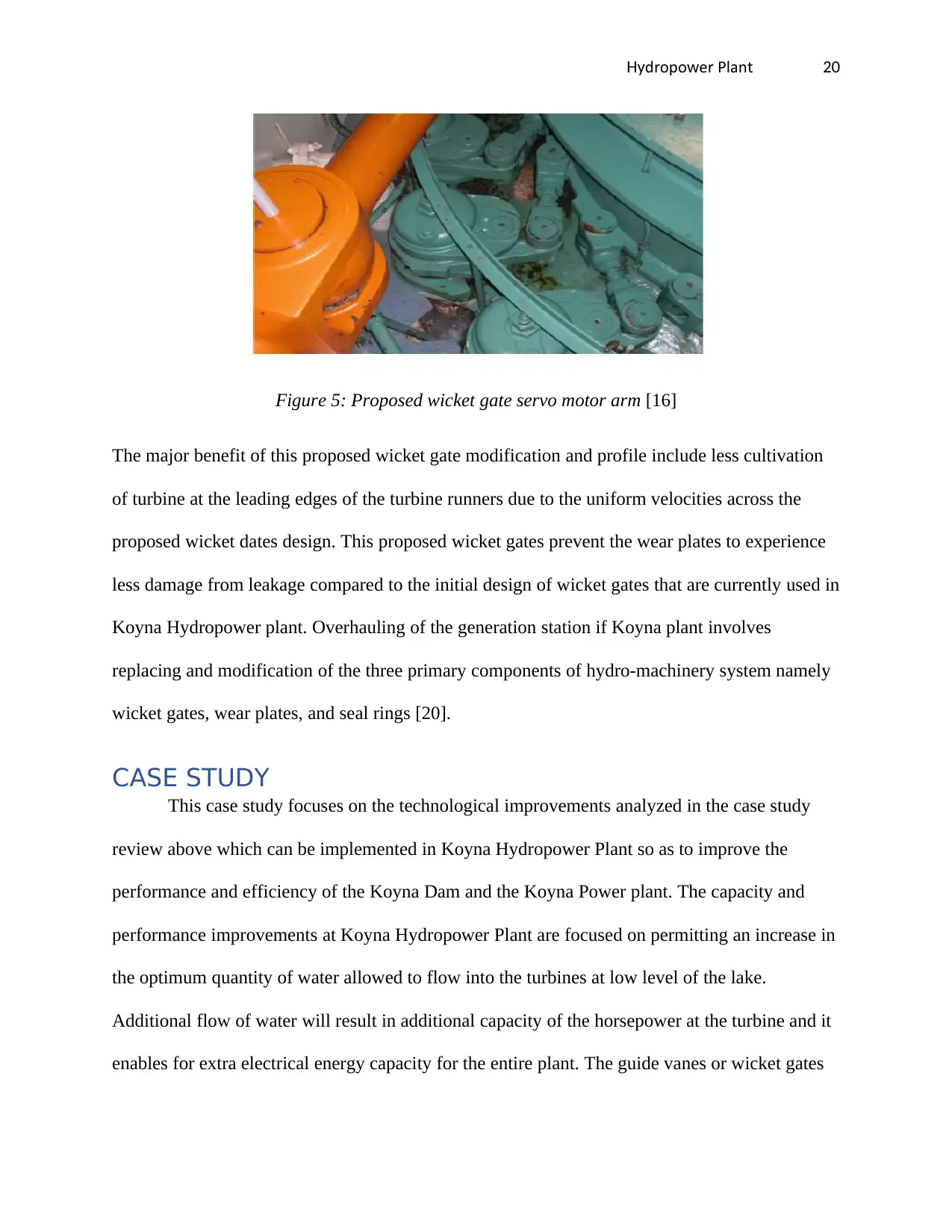
dropo er PlantHy w 20
Figure 5: Proposed wicket gate servo motor arm [16]
The major benefit of this proposed wicket gate modification and profile include less cultivation
of turbine at the leading edges of the turbine runners due to the uniform velocities across the
proposed wicket dates design. This proposed wicket gates prevent the wear plates to experience
less damage from leakage compared to the initial design of wicket gates that are currently used in
Koyna Hydropower plant. Overhauling of the generation station if Koyna plant involves
replacing and modification of the three primary components of hydro-machinery system namely
wicket gates, wear plates, and seal rings [20].
CASE STUDY
This case study focuses on the technological improvements analyzed in the case study
review above which can be implemented in Koyna Hydropower Plant so as to improve the
performance and efficiency of the Koyna Dam and the Koyna Power plant. The capacity and
performance improvements at Koyna Hydropower Plant are focused on permitting an increase in
the optimum quantity of water allowed to flow into the turbines at low level of the lake.
Additional flow of water will result in additional capacity of the horsepower at the turbine and it
enables for extra electrical energy capacity for the entire plant. The guide vanes or wicket gates
Figure 5: Proposed wicket gate servo motor arm [16]
The major benefit of this proposed wicket gate modification and profile include less cultivation
of turbine at the leading edges of the turbine runners due to the uniform velocities across the
proposed wicket dates design. This proposed wicket gates prevent the wear plates to experience
less damage from leakage compared to the initial design of wicket gates that are currently used in
Koyna Hydropower plant. Overhauling of the generation station if Koyna plant involves
replacing and modification of the three primary components of hydro-machinery system namely
wicket gates, wear plates, and seal rings [20].
CASE STUDY
This case study focuses on the technological improvements analyzed in the case study
review above which can be implemented in Koyna Hydropower Plant so as to improve the
performance and efficiency of the Koyna Dam and the Koyna Power plant. The capacity and
performance improvements at Koyna Hydropower Plant are focused on permitting an increase in
the optimum quantity of water allowed to flow into the turbines at low level of the lake.
Additional flow of water will result in additional capacity of the horsepower at the turbine and it
enables for extra electrical energy capacity for the entire plant. The guide vanes or wicket gates
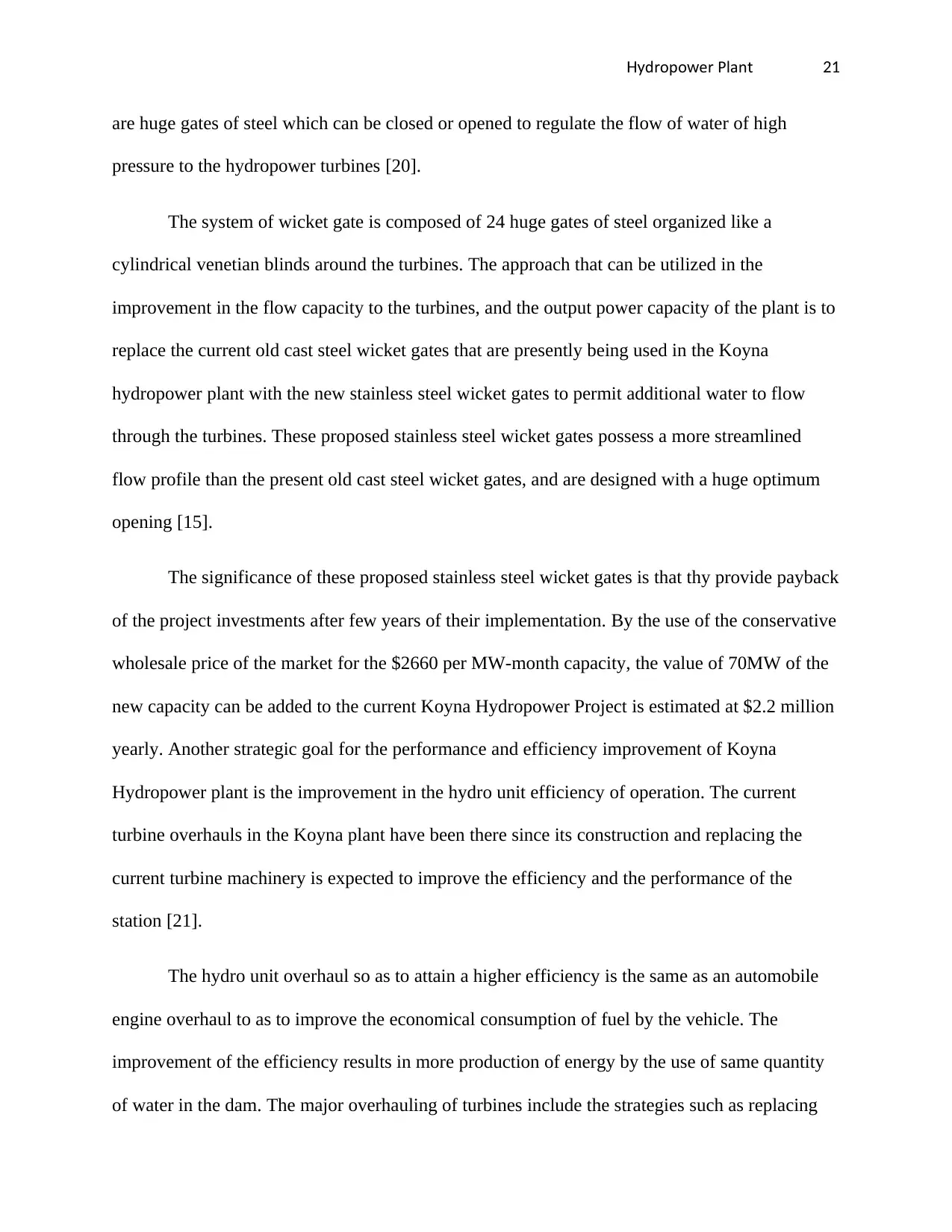
dropo er PlantHy w 21
are huge gates of steel which can be closed or opened to regulate the flow of water of high
pressure to the hydropower turbines [20].
The system of wicket gate is composed of 24 huge gates of steel organized like a
cylindrical venetian blinds around the turbines. The approach that can be utilized in the
improvement in the flow capacity to the turbines, and the output power capacity of the plant is to
replace the current old cast steel wicket gates that are presently being used in the Koyna
hydropower plant with the new stainless steel wicket gates to permit additional water to flow
through the turbines. These proposed stainless steel wicket gates possess a more streamlined
flow profile than the present old cast steel wicket gates, and are designed with a huge optimum
opening [15].
The significance of these proposed stainless steel wicket gates is that thy provide payback
of the project investments after few years of their implementation. By the use of the conservative
wholesale price of the market for the $2660 per MW-month capacity, the value of 70MW of the
new capacity can be added to the current Koyna Hydropower Project is estimated at $2.2 million
yearly. Another strategic goal for the performance and efficiency improvement of Koyna
Hydropower plant is the improvement in the hydro unit efficiency of operation. The current
turbine overhauls in the Koyna plant have been there since its construction and replacing the
current turbine machinery is expected to improve the efficiency and the performance of the
station [21].
The hydro unit overhaul so as to attain a higher efficiency is the same as an automobile
engine overhaul to as to improve the economical consumption of fuel by the vehicle. The
improvement of the efficiency results in more production of energy by the use of same quantity
of water in the dam. The major overhauling of turbines include the strategies such as replacing
are huge gates of steel which can be closed or opened to regulate the flow of water of high
pressure to the hydropower turbines [20].
The system of wicket gate is composed of 24 huge gates of steel organized like a
cylindrical venetian blinds around the turbines. The approach that can be utilized in the
improvement in the flow capacity to the turbines, and the output power capacity of the plant is to
replace the current old cast steel wicket gates that are presently being used in the Koyna
hydropower plant with the new stainless steel wicket gates to permit additional water to flow
through the turbines. These proposed stainless steel wicket gates possess a more streamlined
flow profile than the present old cast steel wicket gates, and are designed with a huge optimum
opening [15].
The significance of these proposed stainless steel wicket gates is that thy provide payback
of the project investments after few years of their implementation. By the use of the conservative
wholesale price of the market for the $2660 per MW-month capacity, the value of 70MW of the
new capacity can be added to the current Koyna Hydropower Project is estimated at $2.2 million
yearly. Another strategic goal for the performance and efficiency improvement of Koyna
Hydropower plant is the improvement in the hydro unit efficiency of operation. The current
turbine overhauls in the Koyna plant have been there since its construction and replacing the
current turbine machinery is expected to improve the efficiency and the performance of the
station [21].
The hydro unit overhaul so as to attain a higher efficiency is the same as an automobile
engine overhaul to as to improve the economical consumption of fuel by the vehicle. The
improvement of the efficiency results in more production of energy by the use of same quantity
of water in the dam. The major overhauling of turbines include the strategies such as replacing
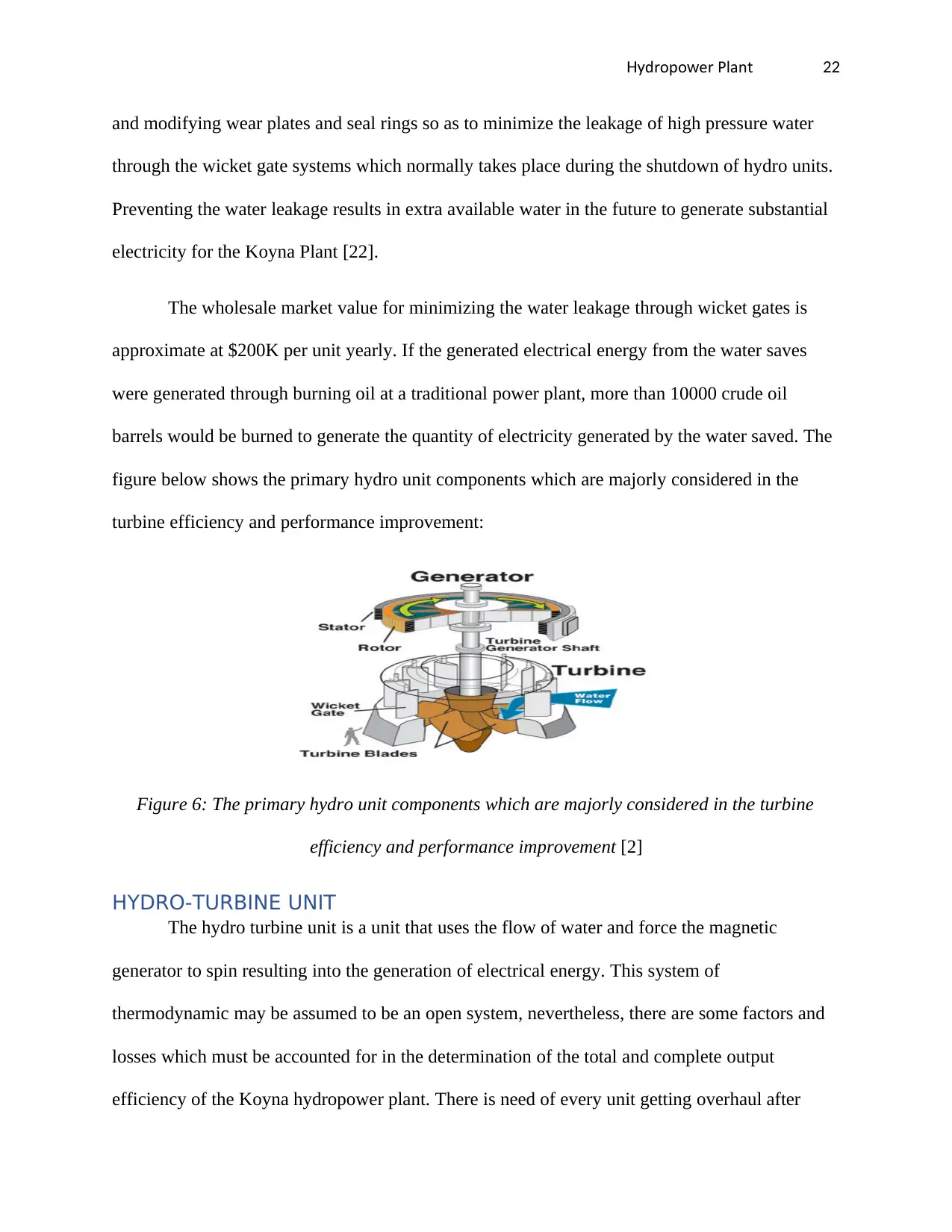
dropo er PlantHy w 22
and modifying wear plates and seal rings so as to minimize the leakage of high pressure water
through the wicket gate systems which normally takes place during the shutdown of hydro units.
Preventing the water leakage results in extra available water in the future to generate substantial
electricity for the Koyna Plant [22].
The wholesale market value for minimizing the water leakage through wicket gates is
approximate at $200K per unit yearly. If the generated electrical energy from the water saves
were generated through burning oil at a traditional power plant, more than 10000 crude oil
barrels would be burned to generate the quantity of electricity generated by the water saved. The
figure below shows the primary hydro unit components which are majorly considered in the
turbine efficiency and performance improvement:
Figure 6: The primary hydro unit components which are majorly considered in the turbine
efficiency and performance improvement [2]
HYDRO-TURBINE UNIT
The hydro turbine unit is a unit that uses the flow of water and force the magnetic
generator to spin resulting into the generation of electrical energy. This system of
thermodynamic may be assumed to be an open system, nevertheless, there are some factors and
losses which must be accounted for in the determination of the total and complete output
efficiency of the Koyna hydropower plant. There is need of every unit getting overhaul after
and modifying wear plates and seal rings so as to minimize the leakage of high pressure water
through the wicket gate systems which normally takes place during the shutdown of hydro units.
Preventing the water leakage results in extra available water in the future to generate substantial
electricity for the Koyna Plant [22].
The wholesale market value for minimizing the water leakage through wicket gates is
approximate at $200K per unit yearly. If the generated electrical energy from the water saves
were generated through burning oil at a traditional power plant, more than 10000 crude oil
barrels would be burned to generate the quantity of electricity generated by the water saved. The
figure below shows the primary hydro unit components which are majorly considered in the
turbine efficiency and performance improvement:
Figure 6: The primary hydro unit components which are majorly considered in the turbine
efficiency and performance improvement [2]
HYDRO-TURBINE UNIT
The hydro turbine unit is a unit that uses the flow of water and force the magnetic
generator to spin resulting into the generation of electrical energy. This system of
thermodynamic may be assumed to be an open system, nevertheless, there are some factors and
losses which must be accounted for in the determination of the total and complete output
efficiency of the Koyna hydropower plant. There is need of every unit getting overhaul after
Secure Best Marks with AI Grader
Need help grading? Try our AI Grader for instant feedback on your assignments.
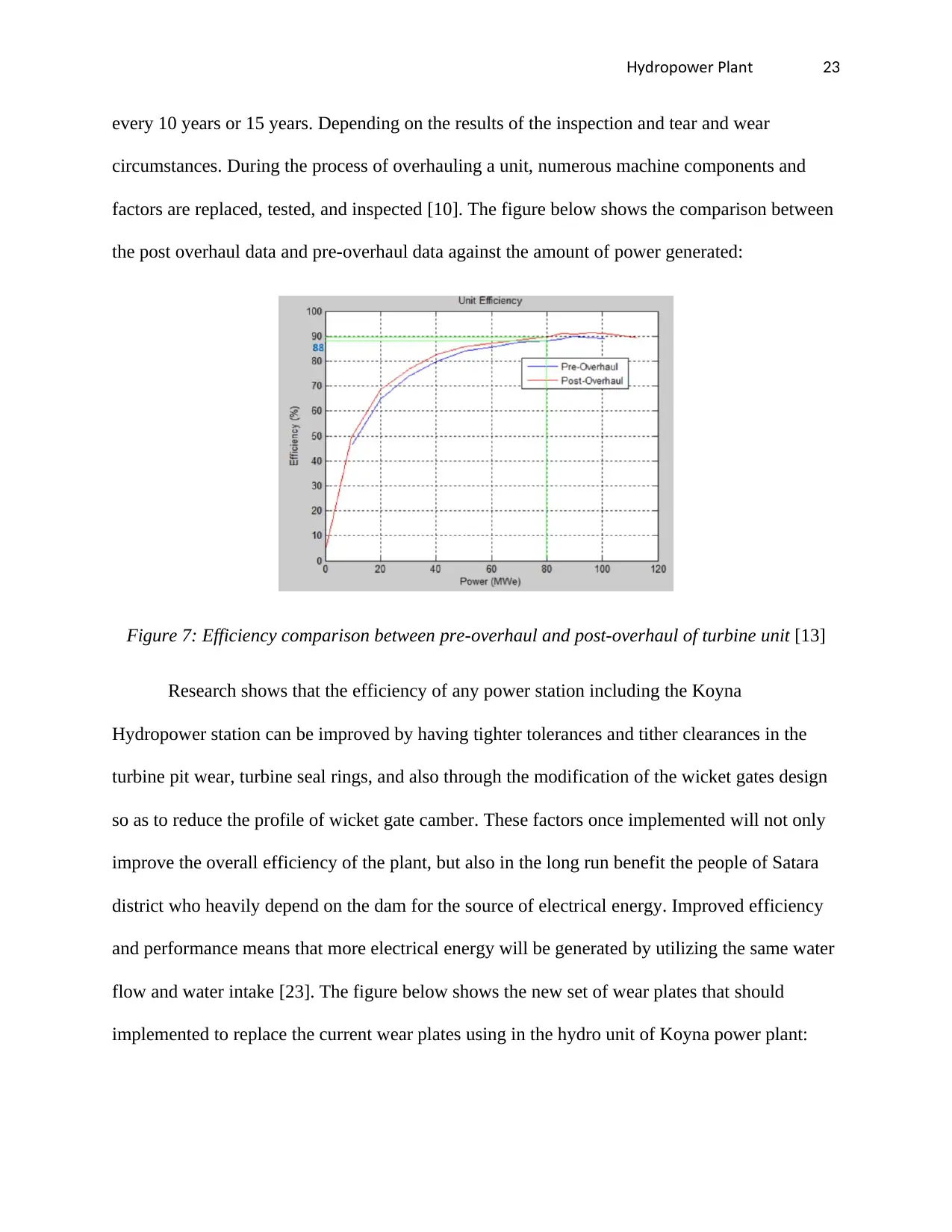
dropo er PlantHy w 23
every 10 years or 15 years. Depending on the results of the inspection and tear and wear
circumstances. During the process of overhauling a unit, numerous machine components and
factors are replaced, tested, and inspected [10]. The figure below shows the comparison between
the post overhaul data and pre-overhaul data against the amount of power generated:
Figure 7: Efficiency comparison between pre-overhaul and post-overhaul of turbine unit [13]
Research shows that the efficiency of any power station including the Koyna
Hydropower station can be improved by having tighter tolerances and tither clearances in the
turbine pit wear, turbine seal rings, and also through the modification of the wicket gates design
so as to reduce the profile of wicket gate camber. These factors once implemented will not only
improve the overall efficiency of the plant, but also in the long run benefit the people of Satara
district who heavily depend on the dam for the source of electrical energy. Improved efficiency
and performance means that more electrical energy will be generated by utilizing the same water
flow and water intake [23]. The figure below shows the new set of wear plates that should
implemented to replace the current wear plates using in the hydro unit of Koyna power plant:
every 10 years or 15 years. Depending on the results of the inspection and tear and wear
circumstances. During the process of overhauling a unit, numerous machine components and
factors are replaced, tested, and inspected [10]. The figure below shows the comparison between
the post overhaul data and pre-overhaul data against the amount of power generated:
Figure 7: Efficiency comparison between pre-overhaul and post-overhaul of turbine unit [13]
Research shows that the efficiency of any power station including the Koyna
Hydropower station can be improved by having tighter tolerances and tither clearances in the
turbine pit wear, turbine seal rings, and also through the modification of the wicket gates design
so as to reduce the profile of wicket gate camber. These factors once implemented will not only
improve the overall efficiency of the plant, but also in the long run benefit the people of Satara
district who heavily depend on the dam for the source of electrical energy. Improved efficiency
and performance means that more electrical energy will be generated by utilizing the same water
flow and water intake [23]. The figure below shows the new set of wear plates that should
implemented to replace the current wear plates using in the hydro unit of Koyna power plant:
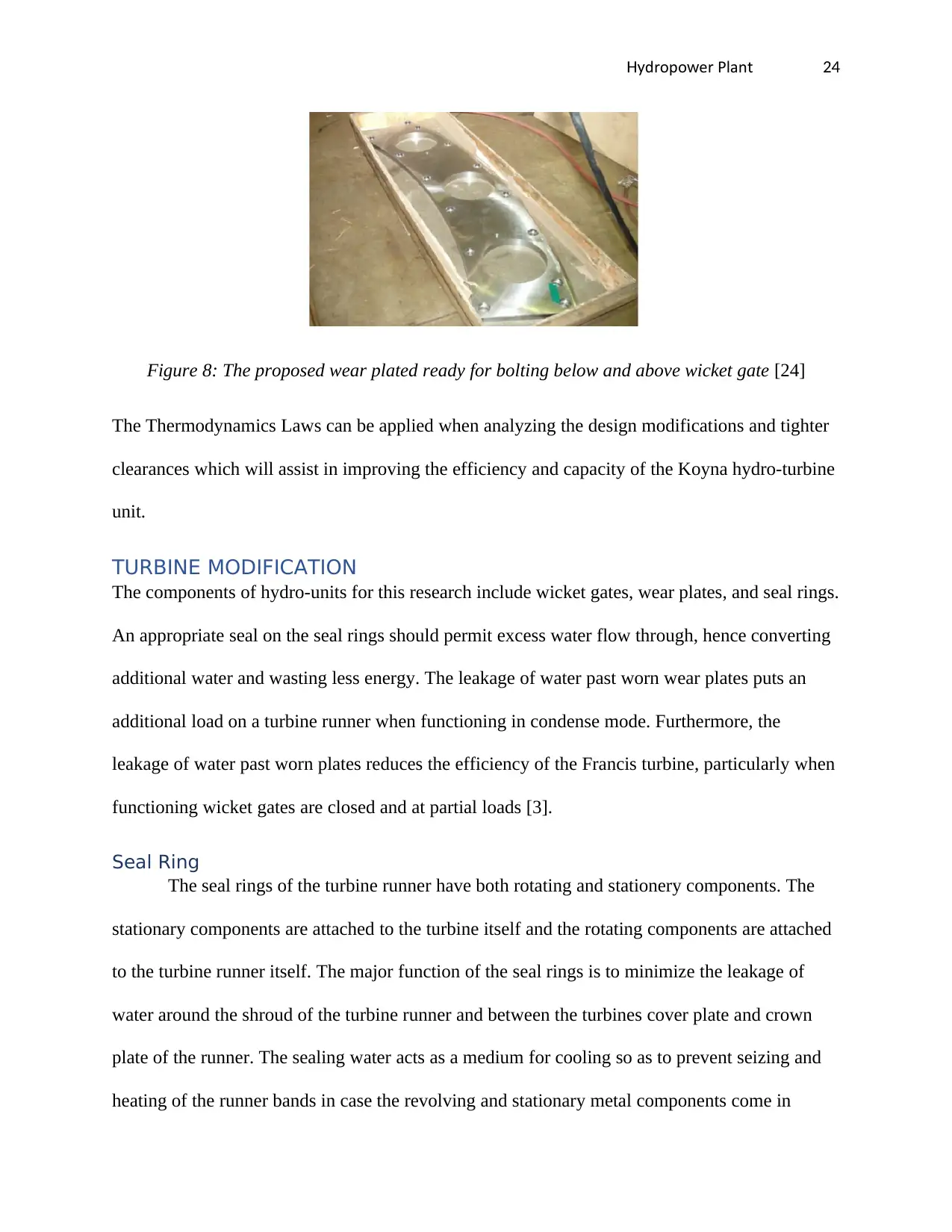
dropo er PlantHy w 24
Figure 8: The proposed wear plated ready for bolting below and above wicket gate [24]
The Thermodynamics Laws can be applied when analyzing the design modifications and tighter
clearances which will assist in improving the efficiency and capacity of the Koyna hydro-turbine
unit.
TURBINE MODIFICATION
The components of hydro-units for this research include wicket gates, wear plates, and seal rings.
An appropriate seal on the seal rings should permit excess water flow through, hence converting
additional water and wasting less energy. The leakage of water past worn wear plates puts an
additional load on a turbine runner when functioning in condense mode. Furthermore, the
leakage of water past worn plates reduces the efficiency of the Francis turbine, particularly when
functioning wicket gates are closed and at partial loads [3].
Seal Ring
The seal rings of the turbine runner have both rotating and stationery components. The
stationary components are attached to the turbine itself and the rotating components are attached
to the turbine runner itself. The major function of the seal rings is to minimize the leakage of
water around the shroud of the turbine runner and between the turbines cover plate and crown
plate of the runner. The sealing water acts as a medium for cooling so as to prevent seizing and
heating of the runner bands in case the revolving and stationary metal components come in
Figure 8: The proposed wear plated ready for bolting below and above wicket gate [24]
The Thermodynamics Laws can be applied when analyzing the design modifications and tighter
clearances which will assist in improving the efficiency and capacity of the Koyna hydro-turbine
unit.
TURBINE MODIFICATION
The components of hydro-units for this research include wicket gates, wear plates, and seal rings.
An appropriate seal on the seal rings should permit excess water flow through, hence converting
additional water and wasting less energy. The leakage of water past worn wear plates puts an
additional load on a turbine runner when functioning in condense mode. Furthermore, the
leakage of water past worn plates reduces the efficiency of the Francis turbine, particularly when
functioning wicket gates are closed and at partial loads [3].
Seal Ring
The seal rings of the turbine runner have both rotating and stationery components. The
stationary components are attached to the turbine itself and the rotating components are attached
to the turbine runner itself. The major function of the seal rings is to minimize the leakage of
water around the shroud of the turbine runner and between the turbines cover plate and crown
plate of the runner. The sealing water acts as a medium for cooling so as to prevent seizing and
heating of the runner bands in case the revolving and stationary metal components come in
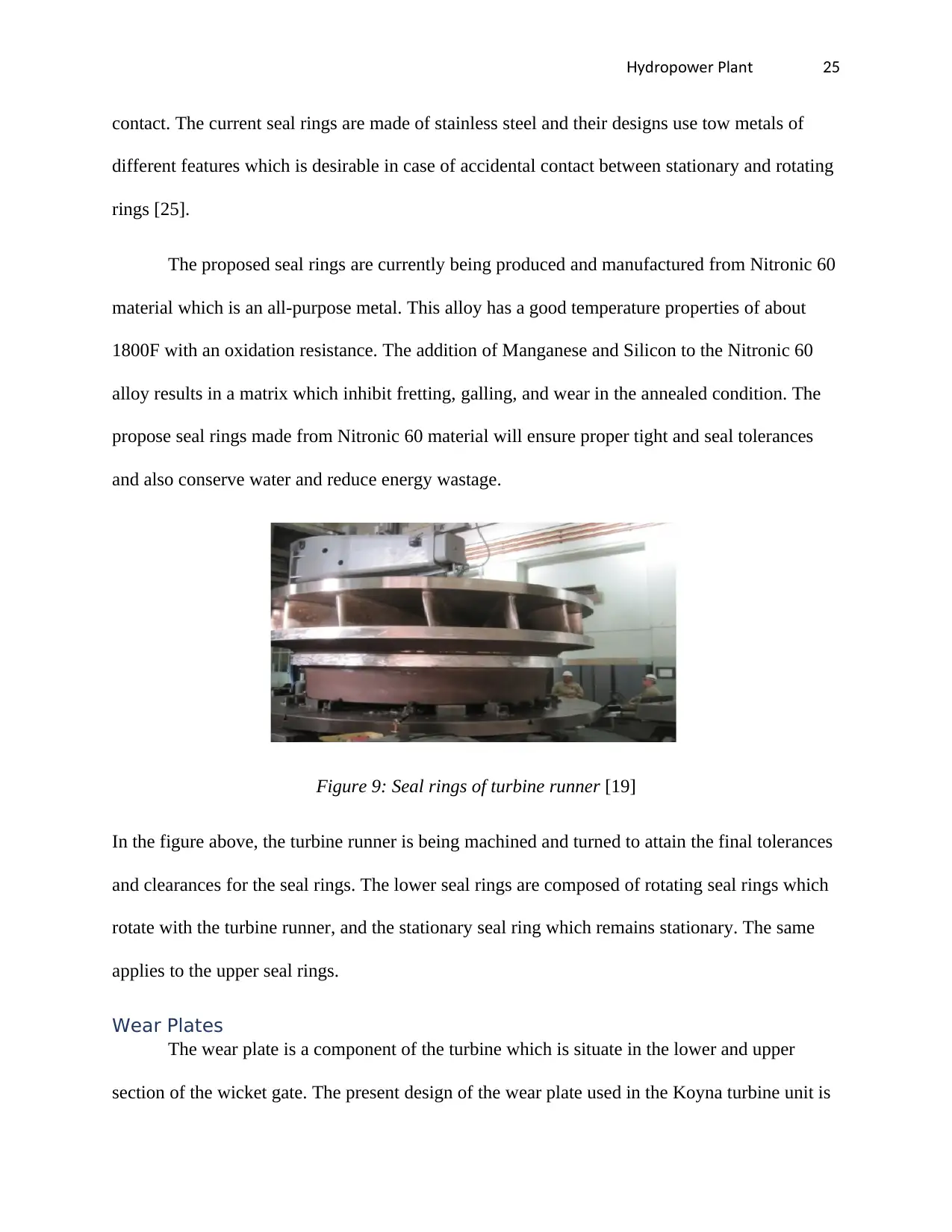
dropo er PlantHy w 25
contact. The current seal rings are made of stainless steel and their designs use tow metals of
different features which is desirable in case of accidental contact between stationary and rotating
rings [25].
The proposed seal rings are currently being produced and manufactured from Nitronic 60
material which is an all-purpose metal. This alloy has a good temperature properties of about
1800F with an oxidation resistance. The addition of Manganese and Silicon to the Nitronic 60
alloy results in a matrix which inhibit fretting, galling, and wear in the annealed condition. The
propose seal rings made from Nitronic 60 material will ensure proper tight and seal tolerances
and also conserve water and reduce energy wastage.
Figure 9: Seal rings of turbine runner [19]
In the figure above, the turbine runner is being machined and turned to attain the final tolerances
and clearances for the seal rings. The lower seal rings are composed of rotating seal rings which
rotate with the turbine runner, and the stationary seal ring which remains stationary. The same
applies to the upper seal rings.
Wear Plates
The wear plate is a component of the turbine which is situate in the lower and upper
section of the wicket gate. The present design of the wear plate used in the Koyna turbine unit is
contact. The current seal rings are made of stainless steel and their designs use tow metals of
different features which is desirable in case of accidental contact between stationary and rotating
rings [25].
The proposed seal rings are currently being produced and manufactured from Nitronic 60
material which is an all-purpose metal. This alloy has a good temperature properties of about
1800F with an oxidation resistance. The addition of Manganese and Silicon to the Nitronic 60
alloy results in a matrix which inhibit fretting, galling, and wear in the annealed condition. The
propose seal rings made from Nitronic 60 material will ensure proper tight and seal tolerances
and also conserve water and reduce energy wastage.
Figure 9: Seal rings of turbine runner [19]
In the figure above, the turbine runner is being machined and turned to attain the final tolerances
and clearances for the seal rings. The lower seal rings are composed of rotating seal rings which
rotate with the turbine runner, and the stationary seal ring which remains stationary. The same
applies to the upper seal rings.
Wear Plates
The wear plate is a component of the turbine which is situate in the lower and upper
section of the wicket gate. The present design of the wear plate used in the Koyna turbine unit is
Paraphrase This Document
Need a fresh take? Get an instant paraphrase of this document with our AI Paraphraser
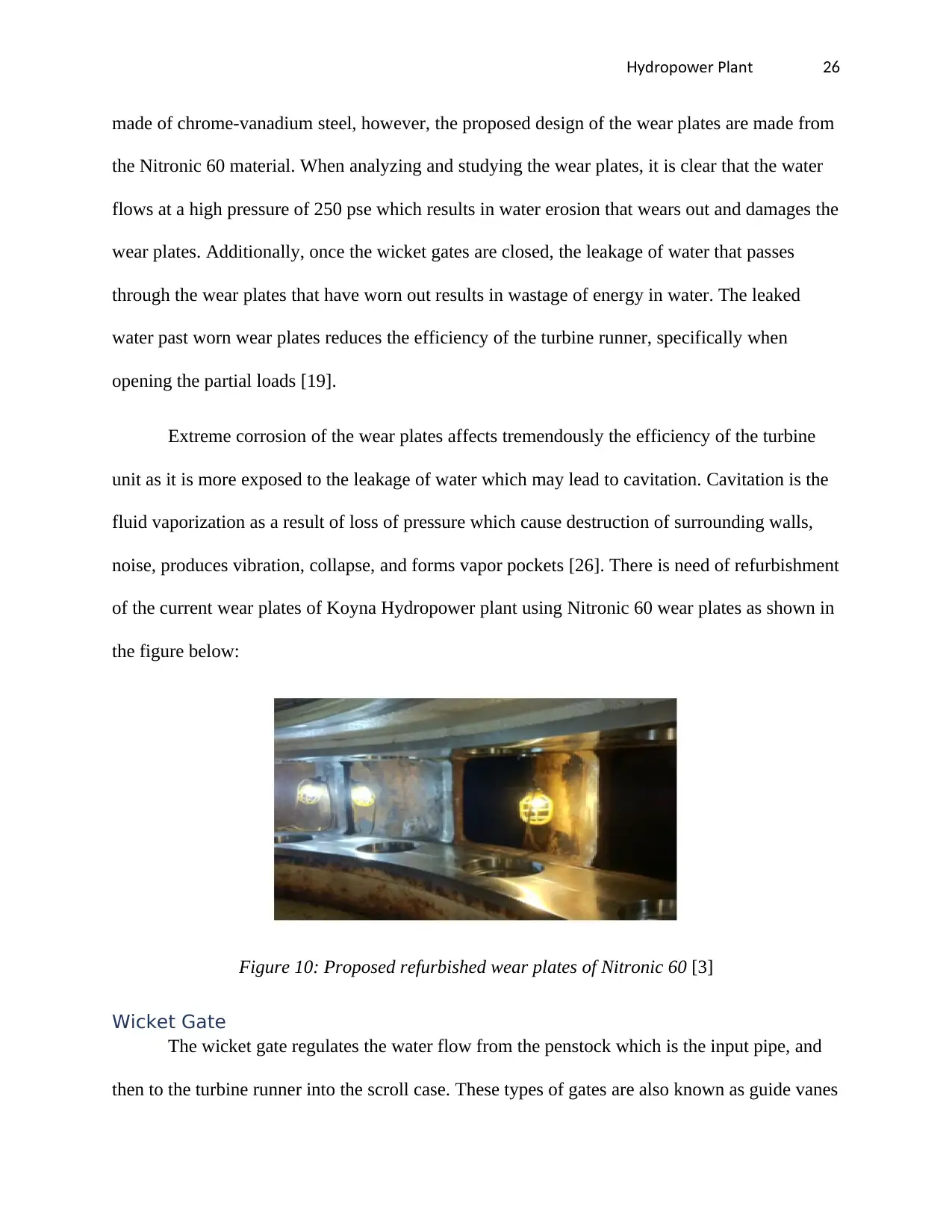
dropo er PlantHy w 26
made of chrome-vanadium steel, however, the proposed design of the wear plates are made from
the Nitronic 60 material. When analyzing and studying the wear plates, it is clear that the water
flows at a high pressure of 250 pse which results in water erosion that wears out and damages the
wear plates. Additionally, once the wicket gates are closed, the leakage of water that passes
through the wear plates that have worn out results in wastage of energy in water. The leaked
water past worn wear plates reduces the efficiency of the turbine runner, specifically when
opening the partial loads [19].
Extreme corrosion of the wear plates affects tremendously the efficiency of the turbine
unit as it is more exposed to the leakage of water which may lead to cavitation. Cavitation is the
fluid vaporization as a result of loss of pressure which cause destruction of surrounding walls,
noise, produces vibration, collapse, and forms vapor pockets [26]. There is need of refurbishment
of the current wear plates of Koyna Hydropower plant using Nitronic 60 wear plates as shown in
the figure below:
Figure 10: Proposed refurbished wear plates of Nitronic 60 [3]
Wicket Gate
The wicket gate regulates the water flow from the penstock which is the input pipe, and
then to the turbine runner into the scroll case. These types of gates are also known as guide vanes
made of chrome-vanadium steel, however, the proposed design of the wear plates are made from
the Nitronic 60 material. When analyzing and studying the wear plates, it is clear that the water
flows at a high pressure of 250 pse which results in water erosion that wears out and damages the
wear plates. Additionally, once the wicket gates are closed, the leakage of water that passes
through the wear plates that have worn out results in wastage of energy in water. The leaked
water past worn wear plates reduces the efficiency of the turbine runner, specifically when
opening the partial loads [19].
Extreme corrosion of the wear plates affects tremendously the efficiency of the turbine
unit as it is more exposed to the leakage of water which may lead to cavitation. Cavitation is the
fluid vaporization as a result of loss of pressure which cause destruction of surrounding walls,
noise, produces vibration, collapse, and forms vapor pockets [26]. There is need of refurbishment
of the current wear plates of Koyna Hydropower plant using Nitronic 60 wear plates as shown in
the figure below:
Figure 10: Proposed refurbished wear plates of Nitronic 60 [3]
Wicket Gate
The wicket gate regulates the water flow from the penstock which is the input pipe, and
then to the turbine runner into the scroll case. These types of gates are also known as guide vanes
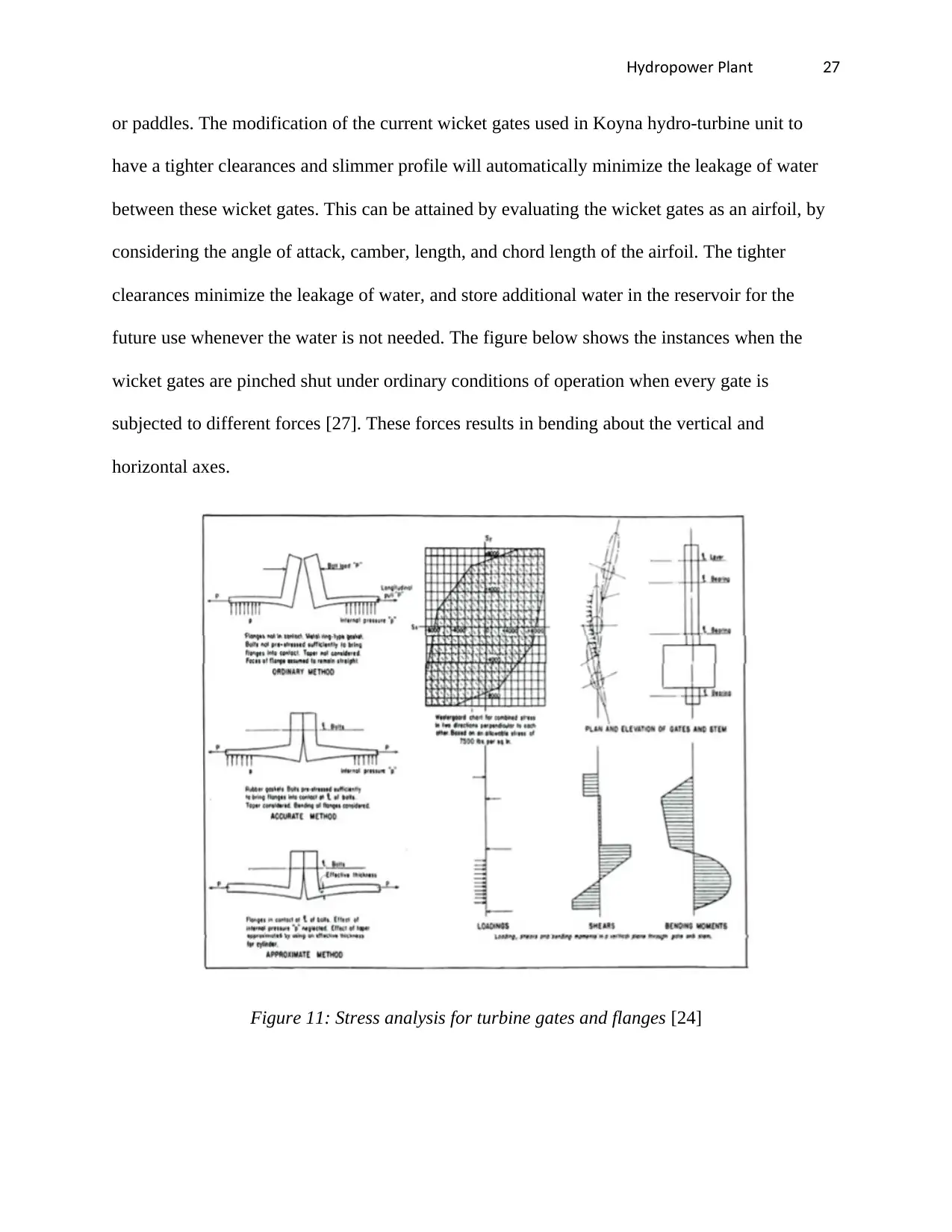
dropo er PlantHy w 27
or paddles. The modification of the current wicket gates used in Koyna hydro-turbine unit to
have a tighter clearances and slimmer profile will automatically minimize the leakage of water
between these wicket gates. This can be attained by evaluating the wicket gates as an airfoil, by
considering the angle of attack, camber, length, and chord length of the airfoil. The tighter
clearances minimize the leakage of water, and store additional water in the reservoir for the
future use whenever the water is not needed. The figure below shows the instances when the
wicket gates are pinched shut under ordinary conditions of operation when every gate is
subjected to different forces [27]. These forces results in bending about the vertical and
horizontal axes.
Figure 11: Stress analysis for turbine gates and flanges [24]
or paddles. The modification of the current wicket gates used in Koyna hydro-turbine unit to
have a tighter clearances and slimmer profile will automatically minimize the leakage of water
between these wicket gates. This can be attained by evaluating the wicket gates as an airfoil, by
considering the angle of attack, camber, length, and chord length of the airfoil. The tighter
clearances minimize the leakage of water, and store additional water in the reservoir for the
future use whenever the water is not needed. The figure below shows the instances when the
wicket gates are pinched shut under ordinary conditions of operation when every gate is
subjected to different forces [27]. These forces results in bending about the vertical and
horizontal axes.
Figure 11: Stress analysis for turbine gates and flanges [24]
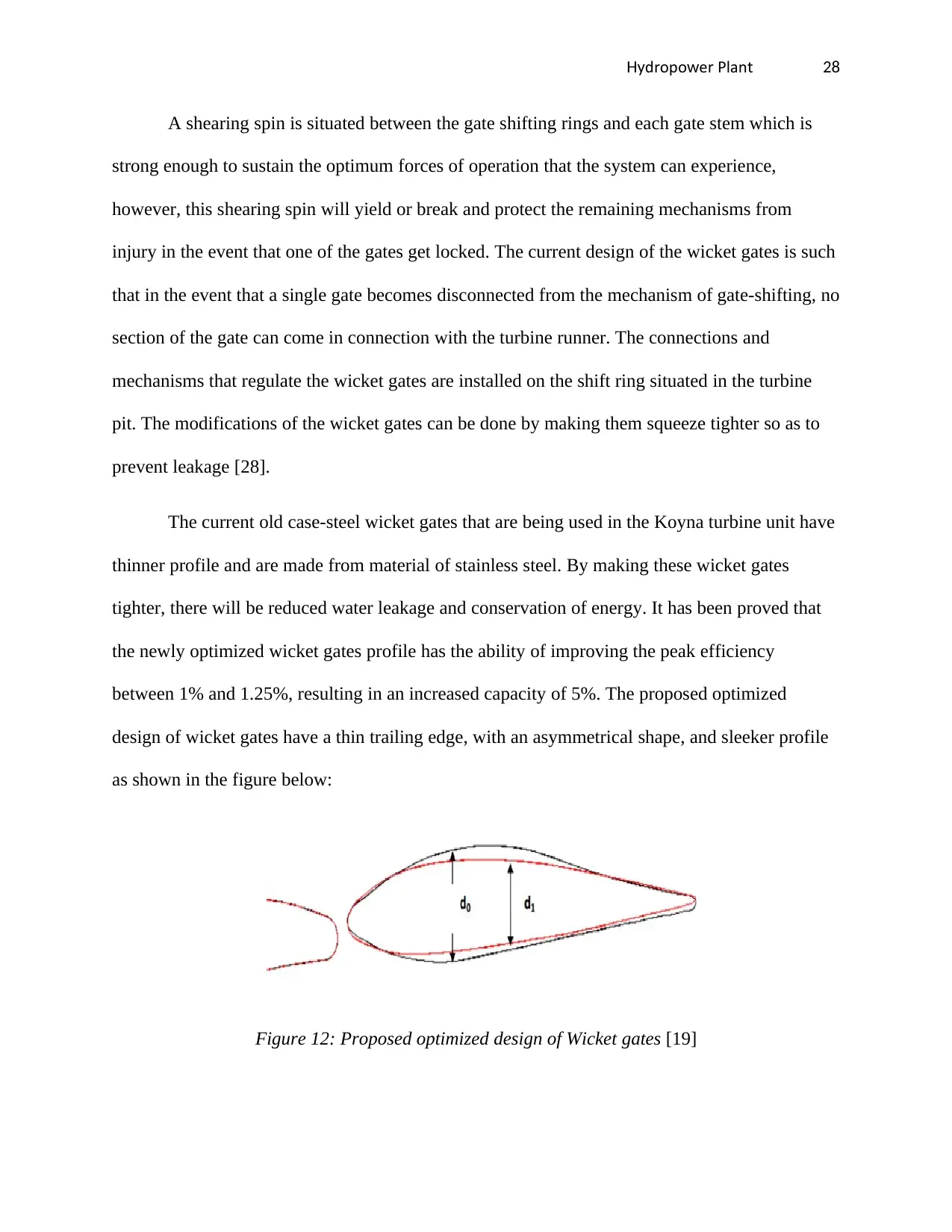
dropo er PlantHy w 28
A shearing spin is situated between the gate shifting rings and each gate stem which is
strong enough to sustain the optimum forces of operation that the system can experience,
however, this shearing spin will yield or break and protect the remaining mechanisms from
injury in the event that one of the gates get locked. The current design of the wicket gates is such
that in the event that a single gate becomes disconnected from the mechanism of gate-shifting, no
section of the gate can come in connection with the turbine runner. The connections and
mechanisms that regulate the wicket gates are installed on the shift ring situated in the turbine
pit. The modifications of the wicket gates can be done by making them squeeze tighter so as to
prevent leakage [28].
The current old case-steel wicket gates that are being used in the Koyna turbine unit have
thinner profile and are made from material of stainless steel. By making these wicket gates
tighter, there will be reduced water leakage and conservation of energy. It has been proved that
the newly optimized wicket gates profile has the ability of improving the peak efficiency
between 1% and 1.25%, resulting in an increased capacity of 5%. The proposed optimized
design of wicket gates have a thin trailing edge, with an asymmetrical shape, and sleeker profile
as shown in the figure below:
Figure 12: Proposed optimized design of Wicket gates [19]
A shearing spin is situated between the gate shifting rings and each gate stem which is
strong enough to sustain the optimum forces of operation that the system can experience,
however, this shearing spin will yield or break and protect the remaining mechanisms from
injury in the event that one of the gates get locked. The current design of the wicket gates is such
that in the event that a single gate becomes disconnected from the mechanism of gate-shifting, no
section of the gate can come in connection with the turbine runner. The connections and
mechanisms that regulate the wicket gates are installed on the shift ring situated in the turbine
pit. The modifications of the wicket gates can be done by making them squeeze tighter so as to
prevent leakage [28].
The current old case-steel wicket gates that are being used in the Koyna turbine unit have
thinner profile and are made from material of stainless steel. By making these wicket gates
tighter, there will be reduced water leakage and conservation of energy. It has been proved that
the newly optimized wicket gates profile has the ability of improving the peak efficiency
between 1% and 1.25%, resulting in an increased capacity of 5%. The proposed optimized
design of wicket gates have a thin trailing edge, with an asymmetrical shape, and sleeker profile
as shown in the figure below:
Figure 12: Proposed optimized design of Wicket gates [19]
Secure Best Marks with AI Grader
Need help grading? Try our AI Grader for instant feedback on your assignments.
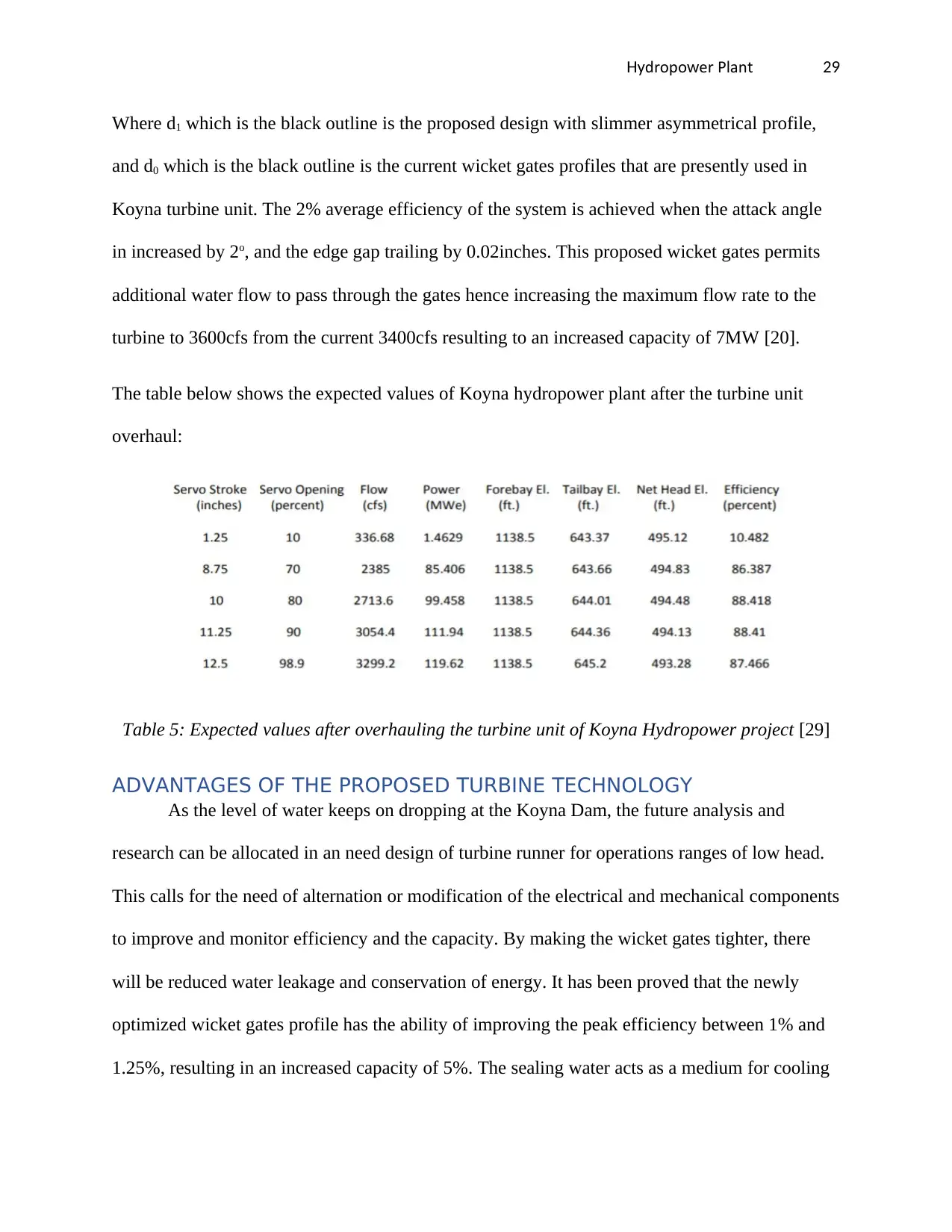
dropo er PlantHy w 29
Where d1 which is the black outline is the proposed design with slimmer asymmetrical profile,
and d0 which is the black outline is the current wicket gates profiles that are presently used in
Koyna turbine unit. The 2% average efficiency of the system is achieved when the attack angle
in increased by 2o, and the edge gap trailing by 0.02inches. This proposed wicket gates permits
additional water flow to pass through the gates hence increasing the maximum flow rate to the
turbine to 3600cfs from the current 3400cfs resulting to an increased capacity of 7MW [20].
The table below shows the expected values of Koyna hydropower plant after the turbine unit
overhaul:
Table 5: Expected values after overhauling the turbine unit of Koyna Hydropower project [29]
ADVANTAGES OF THE PROPOSED TURBINE TECHNOLOGY
As the level of water keeps on dropping at the Koyna Dam, the future analysis and
research can be allocated in an need design of turbine runner for operations ranges of low head.
This calls for the need of alternation or modification of the electrical and mechanical components
to improve and monitor efficiency and the capacity. By making the wicket gates tighter, there
will be reduced water leakage and conservation of energy. It has been proved that the newly
optimized wicket gates profile has the ability of improving the peak efficiency between 1% and
1.25%, resulting in an increased capacity of 5%. The sealing water acts as a medium for cooling
Where d1 which is the black outline is the proposed design with slimmer asymmetrical profile,
and d0 which is the black outline is the current wicket gates profiles that are presently used in
Koyna turbine unit. The 2% average efficiency of the system is achieved when the attack angle
in increased by 2o, and the edge gap trailing by 0.02inches. This proposed wicket gates permits
additional water flow to pass through the gates hence increasing the maximum flow rate to the
turbine to 3600cfs from the current 3400cfs resulting to an increased capacity of 7MW [20].
The table below shows the expected values of Koyna hydropower plant after the turbine unit
overhaul:
Table 5: Expected values after overhauling the turbine unit of Koyna Hydropower project [29]
ADVANTAGES OF THE PROPOSED TURBINE TECHNOLOGY
As the level of water keeps on dropping at the Koyna Dam, the future analysis and
research can be allocated in an need design of turbine runner for operations ranges of low head.
This calls for the need of alternation or modification of the electrical and mechanical components
to improve and monitor efficiency and the capacity. By making the wicket gates tighter, there
will be reduced water leakage and conservation of energy. It has been proved that the newly
optimized wicket gates profile has the ability of improving the peak efficiency between 1% and
1.25%, resulting in an increased capacity of 5%. The sealing water acts as a medium for cooling
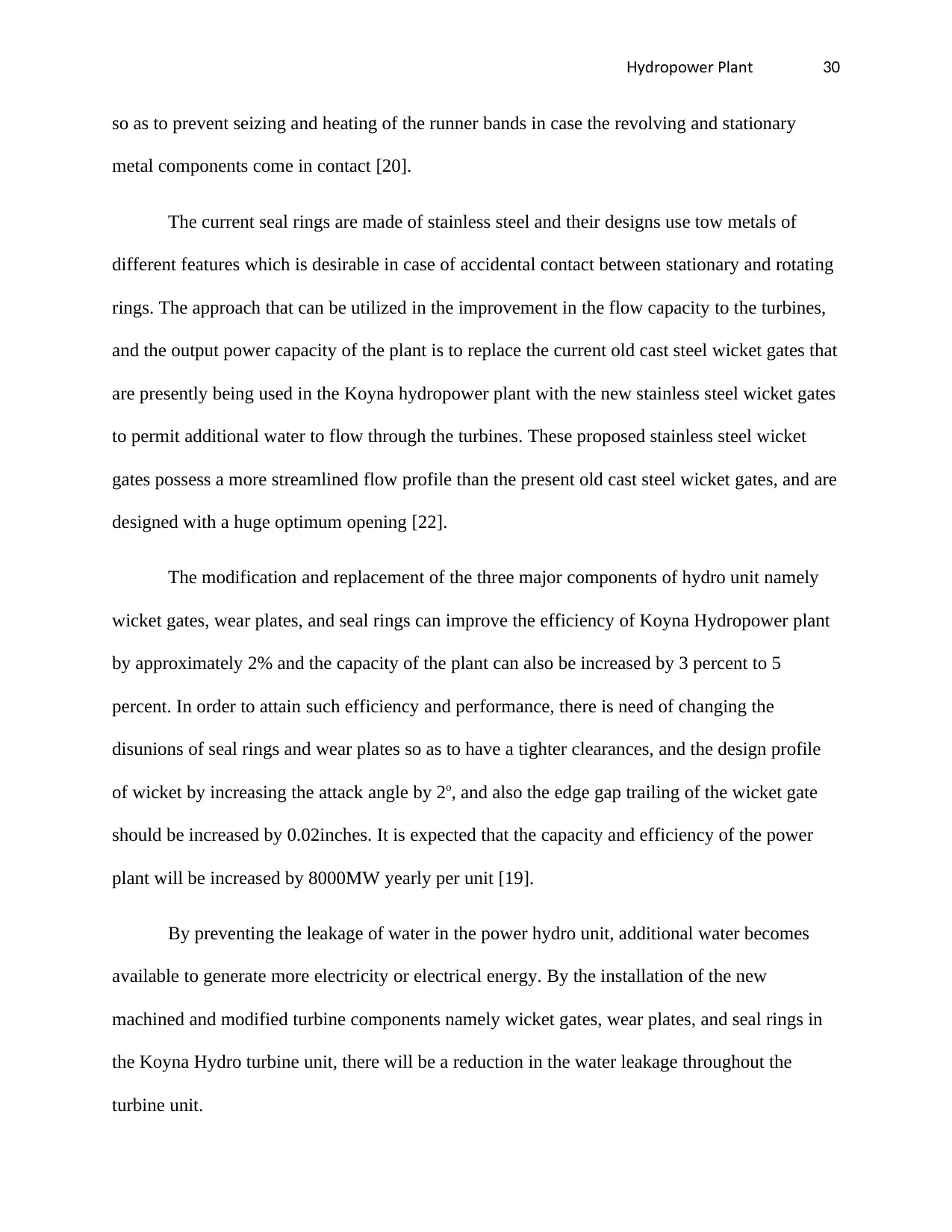
dropo er PlantHy w 30
so as to prevent seizing and heating of the runner bands in case the revolving and stationary
metal components come in contact [20].
The current seal rings are made of stainless steel and their designs use tow metals of
different features which is desirable in case of accidental contact between stationary and rotating
rings. The approach that can be utilized in the improvement in the flow capacity to the turbines,
and the output power capacity of the plant is to replace the current old cast steel wicket gates that
are presently being used in the Koyna hydropower plant with the new stainless steel wicket gates
to permit additional water to flow through the turbines. These proposed stainless steel wicket
gates possess a more streamlined flow profile than the present old cast steel wicket gates, and are
designed with a huge optimum opening [22].
The modification and replacement of the three major components of hydro unit namely
wicket gates, wear plates, and seal rings can improve the efficiency of Koyna Hydropower plant
by approximately 2% and the capacity of the plant can also be increased by 3 percent to 5
percent. In order to attain such efficiency and performance, there is need of changing the
disunions of seal rings and wear plates so as to have a tighter clearances, and the design profile
of wicket by increasing the attack angle by 2o, and also the edge gap trailing of the wicket gate
should be increased by 0.02inches. It is expected that the capacity and efficiency of the power
plant will be increased by 8000MW yearly per unit [19].
By preventing the leakage of water in the power hydro unit, additional water becomes
available to generate more electricity or electrical energy. By the installation of the new
machined and modified turbine components namely wicket gates, wear plates, and seal rings in
the Koyna Hydro turbine unit, there will be a reduction in the water leakage throughout the
turbine unit.
so as to prevent seizing and heating of the runner bands in case the revolving and stationary
metal components come in contact [20].
The current seal rings are made of stainless steel and their designs use tow metals of
different features which is desirable in case of accidental contact between stationary and rotating
rings. The approach that can be utilized in the improvement in the flow capacity to the turbines,
and the output power capacity of the plant is to replace the current old cast steel wicket gates that
are presently being used in the Koyna hydropower plant with the new stainless steel wicket gates
to permit additional water to flow through the turbines. These proposed stainless steel wicket
gates possess a more streamlined flow profile than the present old cast steel wicket gates, and are
designed with a huge optimum opening [22].
The modification and replacement of the three major components of hydro unit namely
wicket gates, wear plates, and seal rings can improve the efficiency of Koyna Hydropower plant
by approximately 2% and the capacity of the plant can also be increased by 3 percent to 5
percent. In order to attain such efficiency and performance, there is need of changing the
disunions of seal rings and wear plates so as to have a tighter clearances, and the design profile
of wicket by increasing the attack angle by 2o, and also the edge gap trailing of the wicket gate
should be increased by 0.02inches. It is expected that the capacity and efficiency of the power
plant will be increased by 8000MW yearly per unit [19].
By preventing the leakage of water in the power hydro unit, additional water becomes
available to generate more electricity or electrical energy. By the installation of the new
machined and modified turbine components namely wicket gates, wear plates, and seal rings in
the Koyna Hydro turbine unit, there will be a reduction in the water leakage throughout the
turbine unit.
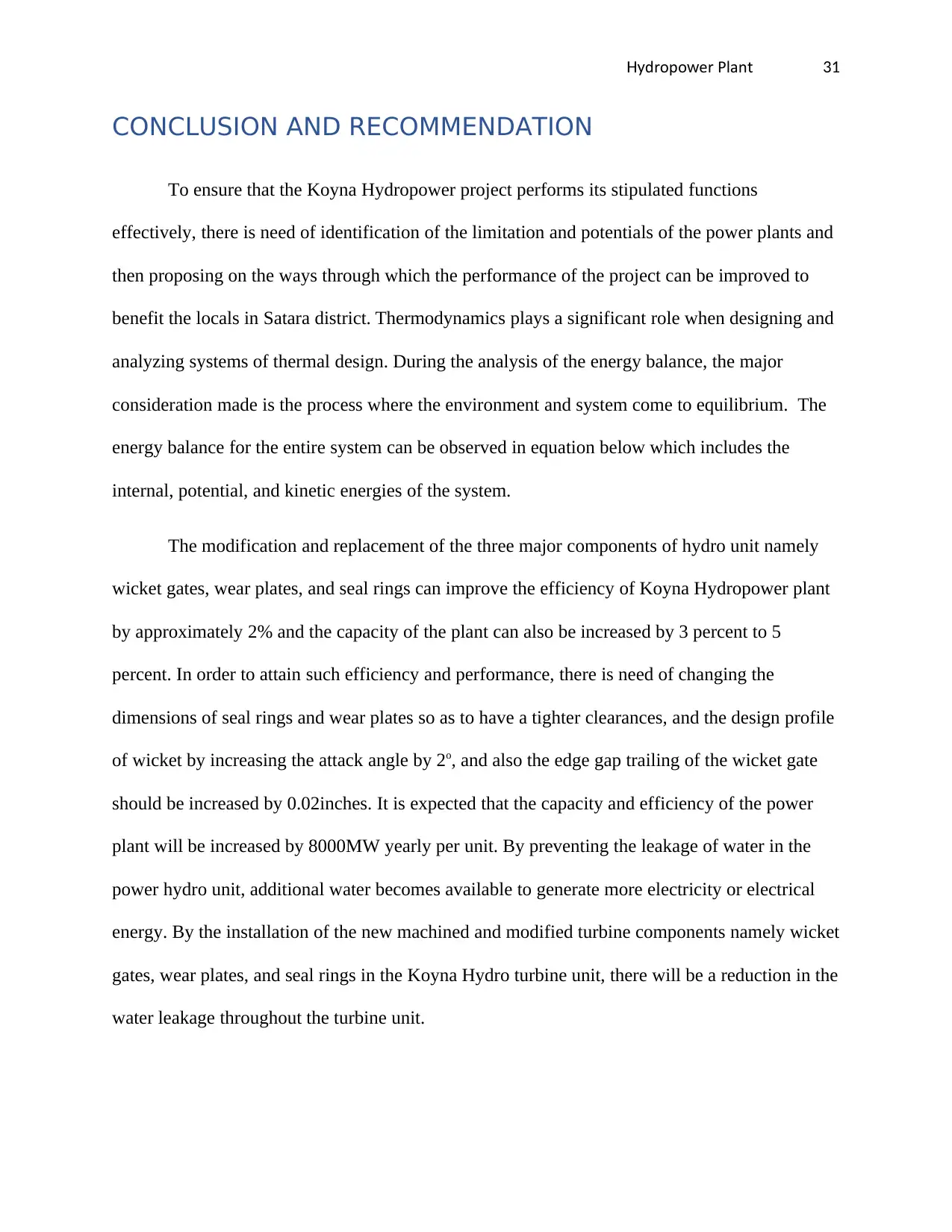
dropo er PlantHy w 31
CONCLUSION AND RECOMMENDATION
To ensure that the Koyna Hydropower project performs its stipulated functions
effectively, there is need of identification of the limitation and potentials of the power plants and
then proposing on the ways through which the performance of the project can be improved to
benefit the locals in Satara district. Thermodynamics plays a significant role when designing and
analyzing systems of thermal design. During the analysis of the energy balance, the major
consideration made is the process where the environment and system come to equilibrium. The
energy balance for the entire system can be observed in equation below which includes the
internal, potential, and kinetic energies of the system.
The modification and replacement of the three major components of hydro unit namely
wicket gates, wear plates, and seal rings can improve the efficiency of Koyna Hydropower plant
by approximately 2% and the capacity of the plant can also be increased by 3 percent to 5
percent. In order to attain such efficiency and performance, there is need of changing the
dimensions of seal rings and wear plates so as to have a tighter clearances, and the design profile
of wicket by increasing the attack angle by 2o, and also the edge gap trailing of the wicket gate
should be increased by 0.02inches. It is expected that the capacity and efficiency of the power
plant will be increased by 8000MW yearly per unit. By preventing the leakage of water in the
power hydro unit, additional water becomes available to generate more electricity or electrical
energy. By the installation of the new machined and modified turbine components namely wicket
gates, wear plates, and seal rings in the Koyna Hydro turbine unit, there will be a reduction in the
water leakage throughout the turbine unit.
CONCLUSION AND RECOMMENDATION
To ensure that the Koyna Hydropower project performs its stipulated functions
effectively, there is need of identification of the limitation and potentials of the power plants and
then proposing on the ways through which the performance of the project can be improved to
benefit the locals in Satara district. Thermodynamics plays a significant role when designing and
analyzing systems of thermal design. During the analysis of the energy balance, the major
consideration made is the process where the environment and system come to equilibrium. The
energy balance for the entire system can be observed in equation below which includes the
internal, potential, and kinetic energies of the system.
The modification and replacement of the three major components of hydro unit namely
wicket gates, wear plates, and seal rings can improve the efficiency of Koyna Hydropower plant
by approximately 2% and the capacity of the plant can also be increased by 3 percent to 5
percent. In order to attain such efficiency and performance, there is need of changing the
dimensions of seal rings and wear plates so as to have a tighter clearances, and the design profile
of wicket by increasing the attack angle by 2o, and also the edge gap trailing of the wicket gate
should be increased by 0.02inches. It is expected that the capacity and efficiency of the power
plant will be increased by 8000MW yearly per unit. By preventing the leakage of water in the
power hydro unit, additional water becomes available to generate more electricity or electrical
energy. By the installation of the new machined and modified turbine components namely wicket
gates, wear plates, and seal rings in the Koyna Hydro turbine unit, there will be a reduction in the
water leakage throughout the turbine unit.
Paraphrase This Document
Need a fresh take? Get an instant paraphrase of this document with our AI Paraphraser
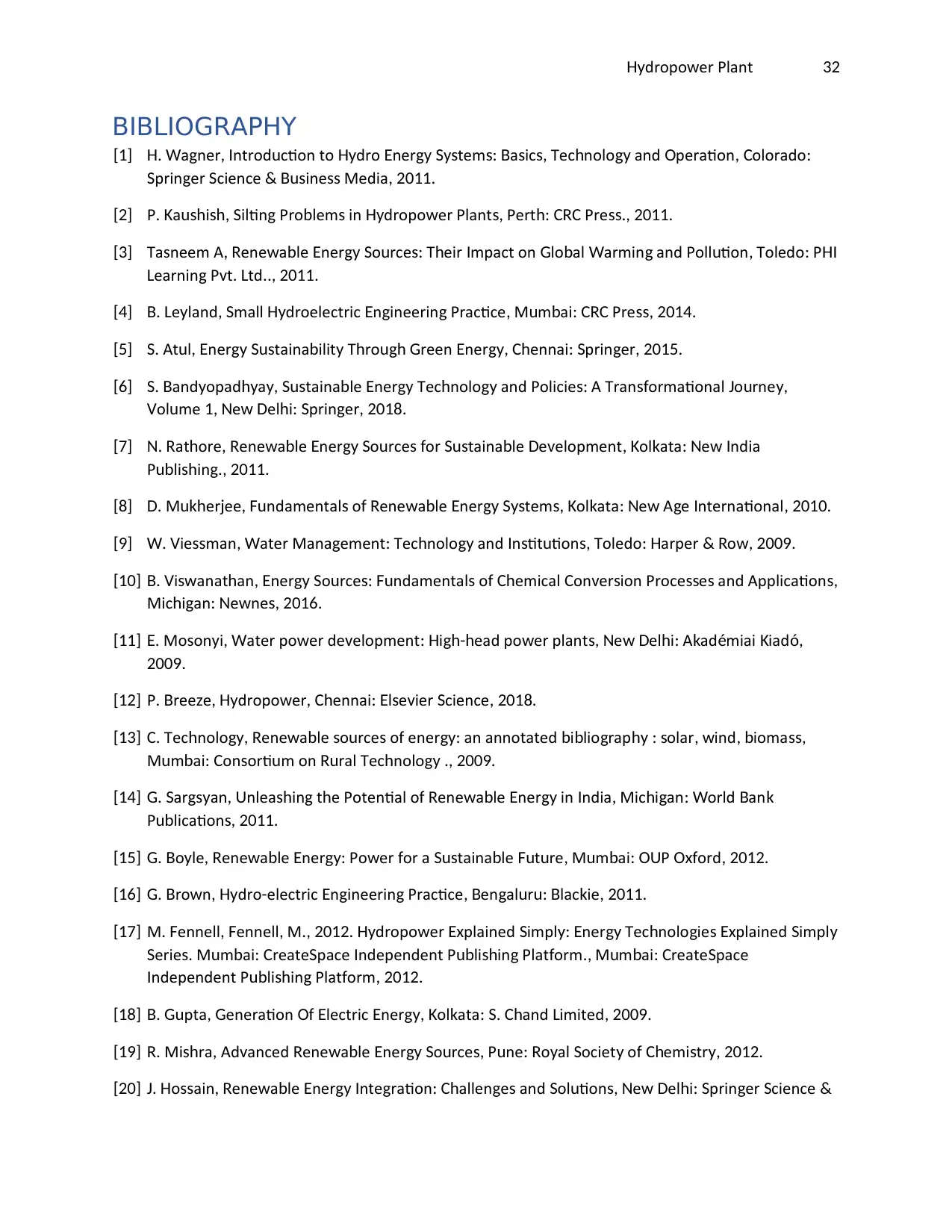
dropo er PlantHy w 32
BIBLIOGRAPHY
[1] a ner ntrod ction to dro ner tem a ic Tec nolo and peration oloradoH. W g , I u Hy E gy Sys s: B s s, h gy O , C :
prin er cience ine MediaS g S & Bus ss , 2011.
[2] P a i iltin Pro lem in dropo er Plant Pert Pre. K ush sh, S g b s Hy w s, h: CRC ss., 2011.
[3] Ta neem A ene a le ner o rce T eir mpact on lo al armin and Poll tion Toledo Ps , R w b E gy S u s: h I G b W g u , : HI
earnin P t tdL g v . L .., 2011.
[4] e land mall droelectric n ineerin Practice M m ai PreB. L y , S Hy E g g , u b : CRC ss, 2014.
[5] At l ner taina ilit T ro reen ner ennai prin erS. u , E gy Sus b y h ugh G E gy, Ch : S g , 2015.
[6] and opad a taina le ner Tec nolo and Policie A Tran ormational o rneS. B y hy y, Sus b E gy h gy s: sf J u y,
ol me e el i prin erV u 1, N w D h : S g , 2018.
[7] at ore ene a le ner o rce or taina le e elopment ol ata e ndiaN. R h , R w b E gy S u s f Sus b D v , K k : N w I
P li inub sh g., 2011.
[8] M er ee ndamental o ene a le ner tem ol ata e A e nternationalD. ukh j , Fu s f R w b E gy Sys s, K k : N w g I , 2010.
[9] ie man ater Mana ement Tec nolo and n tit tion Toledo arper oW. V ss , W g : h gy I s u s, : H & R w, 2009.
[10] i anat an ner o rce ndamental o emical on er ion Proce e and ApplicationB. V sw h , E gy S u s: Fu s f Ch C v s ss s s,
Mic i an e neh g : N w s, 2016.
[11] Mo on i ater po er de elopment i ead po er plant e el i A ad miai iadE. s y , W w v : H gh-h w s, N w D h : k é K ó,
2009.
[12] P ree e dropo er ennai l e ier cience. B z , Hy w , Ch : E s v S , 2018.
[13] Tec nolo ene a le o rce o ener an annotated i lio rap olar ind iomaC. h gy, R w b s u s f gy: b b g hy : s , w , b ss,
M m ai on orti m on ral Tec nolou b : C s u Ru h gy ., 2009.
[14] ar an nlea in t e Potential o ene a le ner in ndia Mic i an orld anG. S gsy , U sh g h f R w b E gy I , h g : W B k
P licationub s, 2011.
[15] o le ene a le ner Po er or a taina le t re M m ai P ordG. B y , R w b E gy: w f Sus b Fu u , u b : OU Oxf , 2012.
[16] ro n dro electric n ineerin Practice en al r lac ieG. B w , Hy - E g g , B g u u: B k , 2011.
[17] M ennell ennell M dropo er plained impl ner Tec nolo ie plained impl. F , F , ., 2012. Hy w Ex S y: E gy h g s Ex S y
erie M m ai reate pace ndependent P li in Plat orm M m ai reate paceS s. u b : C S I ub sh g f ., u b : C S
ndependent P li in Plat ormI ub sh g f , 2012.
[18] pta eneration lectric ner ol ata and imitedB. Gu , G Of E E gy, K k : S. Ch L , 2009.
[19] Mi ra Ad anced ene a le ner o rce P ne o al ociet o emi trR. sh , v R w b E gy S u s, u : R y S y f Ch s y, 2012.
[20] o ain ene a le ner nte ration allen e and ol tion e el i prin er cienceJ. H ss , R w b E gy I g : Ch g s S u s, N w D h : S g S &
BIBLIOGRAPHY
[1] a ner ntrod ction to dro ner tem a ic Tec nolo and peration oloradoH. W g , I u Hy E gy Sys s: B s s, h gy O , C :
prin er cience ine MediaS g S & Bus ss , 2011.
[2] P a i iltin Pro lem in dropo er Plant Pert Pre. K ush sh, S g b s Hy w s, h: CRC ss., 2011.
[3] Ta neem A ene a le ner o rce T eir mpact on lo al armin and Poll tion Toledo Ps , R w b E gy S u s: h I G b W g u , : HI
earnin P t tdL g v . L .., 2011.
[4] e land mall droelectric n ineerin Practice M m ai PreB. L y , S Hy E g g , u b : CRC ss, 2014.
[5] At l ner taina ilit T ro reen ner ennai prin erS. u , E gy Sus b y h ugh G E gy, Ch : S g , 2015.
[6] and opad a taina le ner Tec nolo and Policie A Tran ormational o rneS. B y hy y, Sus b E gy h gy s: sf J u y,
ol me e el i prin erV u 1, N w D h : S g , 2018.
[7] at ore ene a le ner o rce or taina le e elopment ol ata e ndiaN. R h , R w b E gy S u s f Sus b D v , K k : N w I
P li inub sh g., 2011.
[8] M er ee ndamental o ene a le ner tem ol ata e A e nternationalD. ukh j , Fu s f R w b E gy Sys s, K k : N w g I , 2010.
[9] ie man ater Mana ement Tec nolo and n tit tion Toledo arper oW. V ss , W g : h gy I s u s, : H & R w, 2009.
[10] i anat an ner o rce ndamental o emical on er ion Proce e and ApplicationB. V sw h , E gy S u s: Fu s f Ch C v s ss s s,
Mic i an e neh g : N w s, 2016.
[11] Mo on i ater po er de elopment i ead po er plant e el i A ad miai iadE. s y , W w v : H gh-h w s, N w D h : k é K ó,
2009.
[12] P ree e dropo er ennai l e ier cience. B z , Hy w , Ch : E s v S , 2018.
[13] Tec nolo ene a le o rce o ener an annotated i lio rap olar ind iomaC. h gy, R w b s u s f gy: b b g hy : s , w , b ss,
M m ai on orti m on ral Tec nolou b : C s u Ru h gy ., 2009.
[14] ar an nlea in t e Potential o ene a le ner in ndia Mic i an orld anG. S gsy , U sh g h f R w b E gy I , h g : W B k
P licationub s, 2011.
[15] o le ene a le ner Po er or a taina le t re M m ai P ordG. B y , R w b E gy: w f Sus b Fu u , u b : OU Oxf , 2012.
[16] ro n dro electric n ineerin Practice en al r lac ieG. B w , Hy - E g g , B g u u: B k , 2011.
[17] M ennell ennell M dropo er plained impl ner Tec nolo ie plained impl. F , F , ., 2012. Hy w Ex S y: E gy h g s Ex S y
erie M m ai reate pace ndependent P li in Plat orm M m ai reate paceS s. u b : C S I ub sh g f ., u b : C S
ndependent P li in Plat ormI ub sh g f , 2012.
[18] pta eneration lectric ner ol ata and imitedB. Gu , G Of E E gy, K k : S. Ch L , 2009.
[19] Mi ra Ad anced ene a le ner o rce P ne o al ociet o emi trR. sh , v R w b E gy S u s, u : R y S y f Ch s y, 2012.
[20] o ain ene a le ner nte ration allen e and ol tion e el i prin er cienceJ. H ss , R w b E gy I g : Ch g s S u s, N w D h : S g S &
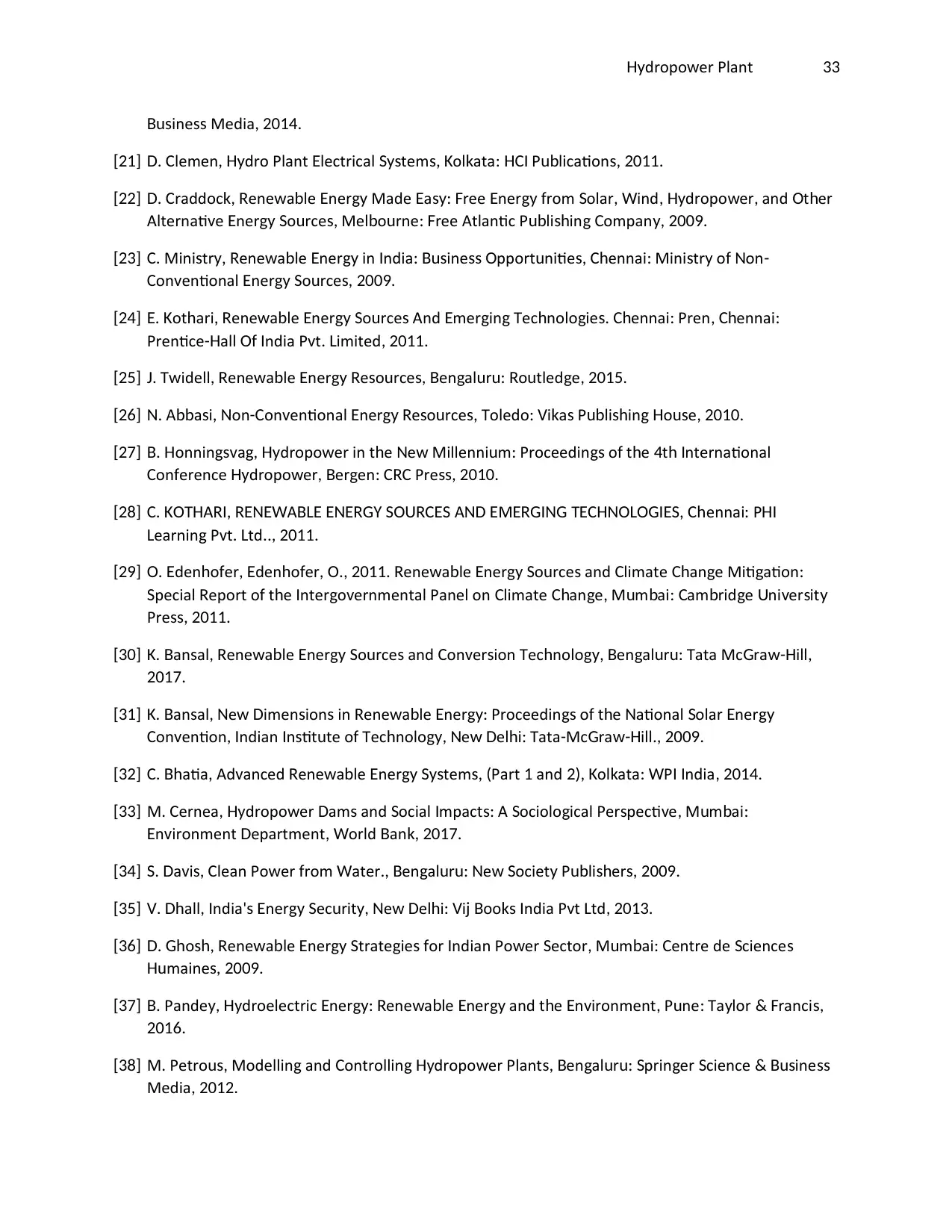
dropo er PlantHy w 33
ine MediaBus ss , 2014.
[21] lemen dro Plant lectrical tem ol ata P licationD. C , Hy E Sys s, K k : HCI ub s, 2011.
[22] raddoc ene a le ner Made a ree ner rom olar ind dropo er and t erD. C k, R w b E gy E sy: F E gy f S , W , Hy w , O h
Alternati e ner o rce Mel o rne ree Atlantic P li in ompanv E gy S u s, b u : F ub sh g C y, 2009.
[23] Mini tr ene a le ner in ndia ine pport nitie ennai Mini tr o onC. s y, R w b E gy I : Bus ss O u s, Ch : s y f N -
on entional ner o rceC v E gy S u s, 2009.
[24] ot ari ene a le ner o rce And mer in Tec nolo ie ennai Pren ennaiE. K h , R w b E gy S u s E g g h g s. Ch : , Ch :
Prentice all ndia P t imited-H Of I v . L , 2011.
[25] T idell ene a le ner e o rce en al r o tled eJ. w , R w b E gy R s u s, B g u u: R u g , 2015.
[26] A a i on on entional ner e o rce Toledo i a P li in o eN. bb s , N -C v E gy R s u s, : V k s ub sh g H us , 2010.
[27] onnin a dropo er in t e e Millenni m Proceedin o t e t nternationalB. H gsv g, Hy w h N w u : gs f h 4 h I
on erence dropo er er en PreC f Hy w , B g : CRC ss, 2010.
[28] T A A A M T ennai PC. KO H RI, RENEW BLE ENERGY SOURCES ND E ERGING ECHNOLOGIES, Ch : HI
earnin P t tdL g v . L .., 2011.
[29] den o er den o er ene a le ner o rce and limate an e Miti ationO. E h f , E h f , O., 2011. R w b E gy S u s C Ch g g :
pecial eport o t e nter o ernmental Panel on limate an e M m ai am rid e ni er itS R f h I g v C Ch g , u b : C b g U v s y
Press, 2011.
[30] an al ene a le ner o rce and on er ion Tec nolo en al r Tata Mc ra illK. B s , R w b E gy S u s C v s h gy, B g u u: G w-H ,
2017.
[31] an al e imen ion in ene a le ner Proceedin o t e ational olar nerK. B s , N w D s s R w b E gy: gs f h N S E gy
on ention ndian n tit te o Tec nolo e el i Tata Mc ra illC v , I I s u f h gy, N w D h : - G w-H ., 2009.
[32] atia Ad anced ene a le ner tem Part and ol ata P ndiaC. Bh , v R w b E gy Sys s, ( 1 2), K k : W I I , 2014.
[33] M ernea dropo er am and ocial mpact A ociolo ical Per pecti e M m ai. C , Hy w D s S I s: S g s v , u b :
n ironment epartment orld anE v D , W B k, 2017.
[34] a i lean Po er rom ater en al r e ociet P li erS. D v s, C w f W ., B g u u: N w S y ub sh s, 2009.
[35] all ndia ner ec rit e el i i oo ndia P t tdV. Dh , I 's E gy S u y, N w D h : V j B ks I v L , 2013.
[36] o ene a le ner trate ie or ndian Po er ector M m ai entre de cienceD. Gh sh, R w b E gy S g s f I w S , u b : C S s
maineHu s, 2009.
[37] Pande droelectric ner ene a le ner and t e n ironment P ne Ta lor ranciB. y, Hy E gy: R w b E gy h E v , u : y & F s,
2016.
[38] M Petro Modellin and ontrollin dropo er Plant en al r prin er cience ine. us, g C g Hy w s, B g u u: S g S & Bus ss
Media, 2012.
ine MediaBus ss , 2014.
[21] lemen dro Plant lectrical tem ol ata P licationD. C , Hy E Sys s, K k : HCI ub s, 2011.
[22] raddoc ene a le ner Made a ree ner rom olar ind dropo er and t erD. C k, R w b E gy E sy: F E gy f S , W , Hy w , O h
Alternati e ner o rce Mel o rne ree Atlantic P li in ompanv E gy S u s, b u : F ub sh g C y, 2009.
[23] Mini tr ene a le ner in ndia ine pport nitie ennai Mini tr o onC. s y, R w b E gy I : Bus ss O u s, Ch : s y f N -
on entional ner o rceC v E gy S u s, 2009.
[24] ot ari ene a le ner o rce And mer in Tec nolo ie ennai Pren ennaiE. K h , R w b E gy S u s E g g h g s. Ch : , Ch :
Prentice all ndia P t imited-H Of I v . L , 2011.
[25] T idell ene a le ner e o rce en al r o tled eJ. w , R w b E gy R s u s, B g u u: R u g , 2015.
[26] A a i on on entional ner e o rce Toledo i a P li in o eN. bb s , N -C v E gy R s u s, : V k s ub sh g H us , 2010.
[27] onnin a dropo er in t e e Millenni m Proceedin o t e t nternationalB. H gsv g, Hy w h N w u : gs f h 4 h I
on erence dropo er er en PreC f Hy w , B g : CRC ss, 2010.
[28] T A A A M T ennai PC. KO H RI, RENEW BLE ENERGY SOURCES ND E ERGING ECHNOLOGIES, Ch : HI
earnin P t tdL g v . L .., 2011.
[29] den o er den o er ene a le ner o rce and limate an e Miti ationO. E h f , E h f , O., 2011. R w b E gy S u s C Ch g g :
pecial eport o t e nter o ernmental Panel on limate an e M m ai am rid e ni er itS R f h I g v C Ch g , u b : C b g U v s y
Press, 2011.
[30] an al ene a le ner o rce and on er ion Tec nolo en al r Tata Mc ra illK. B s , R w b E gy S u s C v s h gy, B g u u: G w-H ,
2017.
[31] an al e imen ion in ene a le ner Proceedin o t e ational olar nerK. B s , N w D s s R w b E gy: gs f h N S E gy
on ention ndian n tit te o Tec nolo e el i Tata Mc ra illC v , I I s u f h gy, N w D h : - G w-H ., 2009.
[32] atia Ad anced ene a le ner tem Part and ol ata P ndiaC. Bh , v R w b E gy Sys s, ( 1 2), K k : W I I , 2014.
[33] M ernea dropo er am and ocial mpact A ociolo ical Per pecti e M m ai. C , Hy w D s S I s: S g s v , u b :
n ironment epartment orld anE v D , W B k, 2017.
[34] a i lean Po er rom ater en al r e ociet P li erS. D v s, C w f W ., B g u u: N w S y ub sh s, 2009.
[35] all ndia ner ec rit e el i i oo ndia P t tdV. Dh , I 's E gy S u y, N w D h : V j B ks I v L , 2013.
[36] o ene a le ner trate ie or ndian Po er ector M m ai entre de cienceD. Gh sh, R w b E gy S g s f I w S , u b : C S s
maineHu s, 2009.
[37] Pande droelectric ner ene a le ner and t e n ironment P ne Ta lor ranciB. y, Hy E gy: R w b E gy h E v , u : y & F s,
2016.
[38] M Petro Modellin and ontrollin dropo er Plant en al r prin er cience ine. us, g C g Hy w s, B g u u: S g S & Bus ss
Media, 2012.
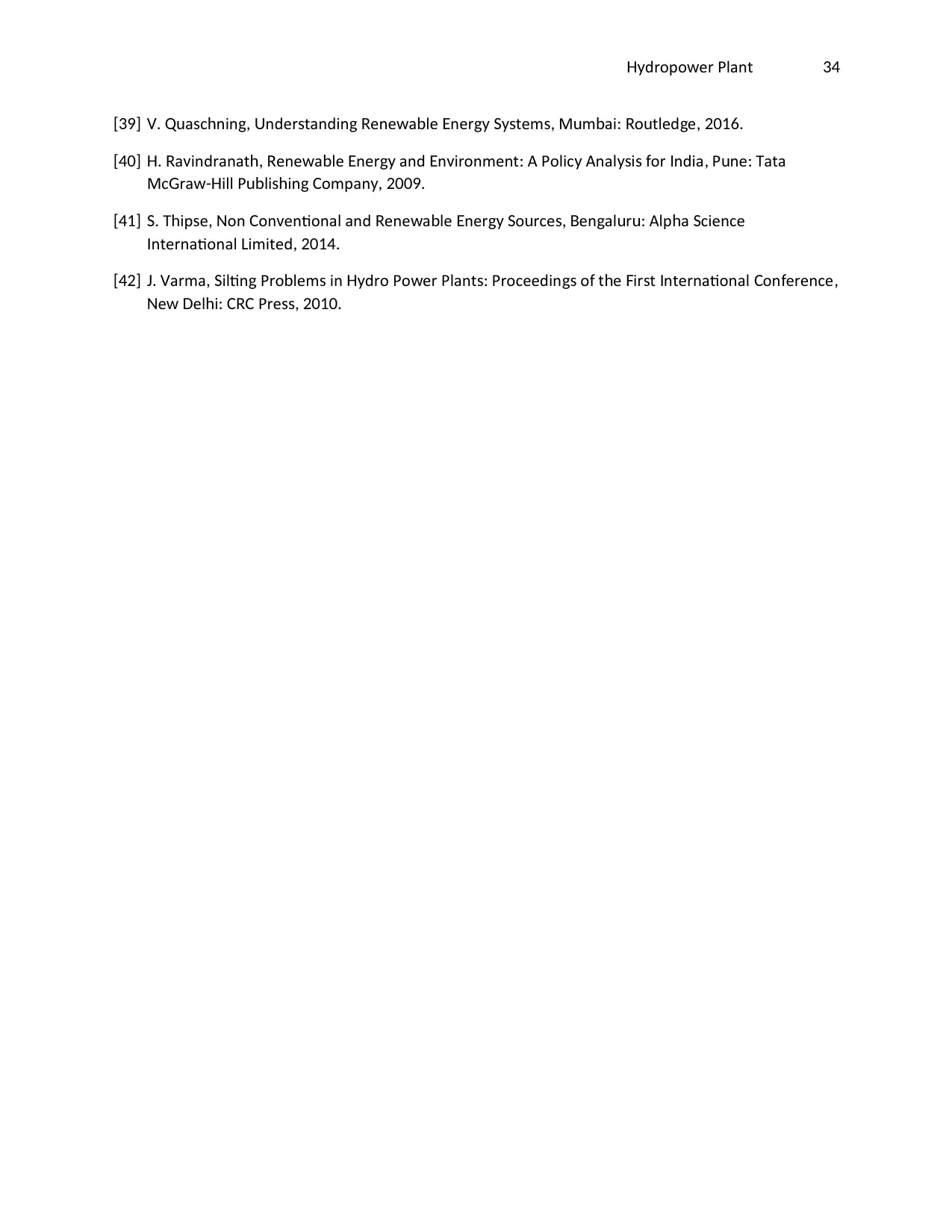
dropo er PlantHy w 34
[39] a c nin nder tandin ene a le ner tem M m ai o tled eV. Qu s h g, U s g R w b E gy Sys s, u b : R u g , 2016.
[40] a indranat ene a le ner and n ironment A Polic Anal i or ndia P ne TataH. R v h, R w b E gy E v : y ys s f I , u :
Mc ra ill P li in ompanG w-H ub sh g C y, 2009.
[41] T ip e on on entional and ene a le ner o rce en al r Alp a cienceS. h s , N C v R w b E gy S u s, B g u u: h S
nternational imitedI L , 2014.
[42] arma iltin Pro lem in dro Po er Plant Proceedin o t e ir t nternational on erenceJ. V , S g b s Hy w s: gs f h F s I C f ,
e el i PreN w D h : CRC ss, 2010.
[39] a c nin nder tandin ene a le ner tem M m ai o tled eV. Qu s h g, U s g R w b E gy Sys s, u b : R u g , 2016.
[40] a indranat ene a le ner and n ironment A Polic Anal i or ndia P ne TataH. R v h, R w b E gy E v : y ys s f I , u :
Mc ra ill P li in ompanG w-H ub sh g C y, 2009.
[41] T ip e on on entional and ene a le ner o rce en al r Alp a cienceS. h s , N C v R w b E gy S u s, B g u u: h S
nternational imitedI L , 2014.
[42] arma iltin Pro lem in dro Po er Plant Proceedin o t e ir t nternational on erenceJ. V , S g b s Hy w s: gs f h F s I C f ,
e el i PreN w D h : CRC ss, 2010.
Secure Best Marks with AI Grader
Need help grading? Try our AI Grader for instant feedback on your assignments.
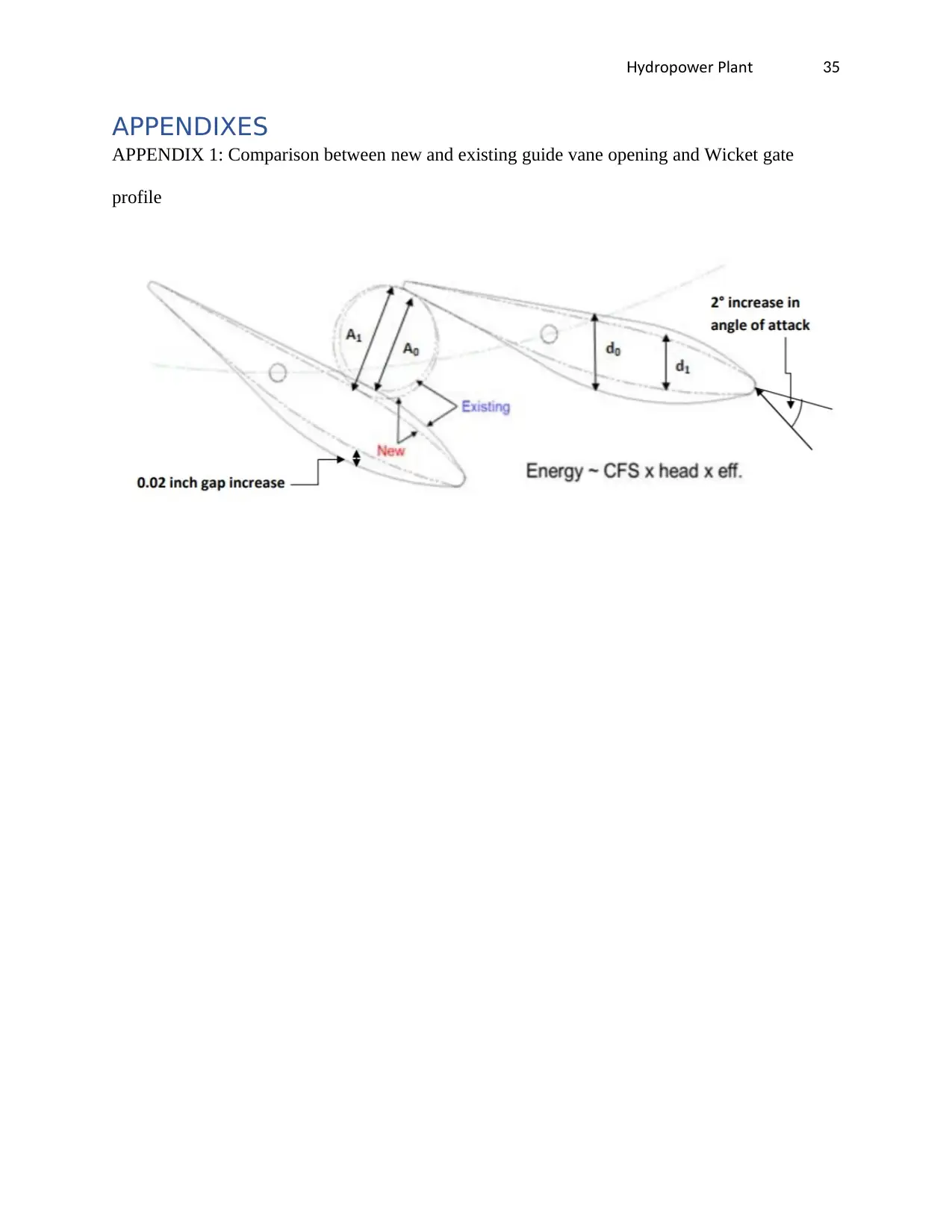
dropo er PlantHy w 35
APPENDIXES
APPENDIX 1: Comparison between new and existing guide vane opening and Wicket gate
profile
APPENDIXES
APPENDIX 1: Comparison between new and existing guide vane opening and Wicket gate
profile
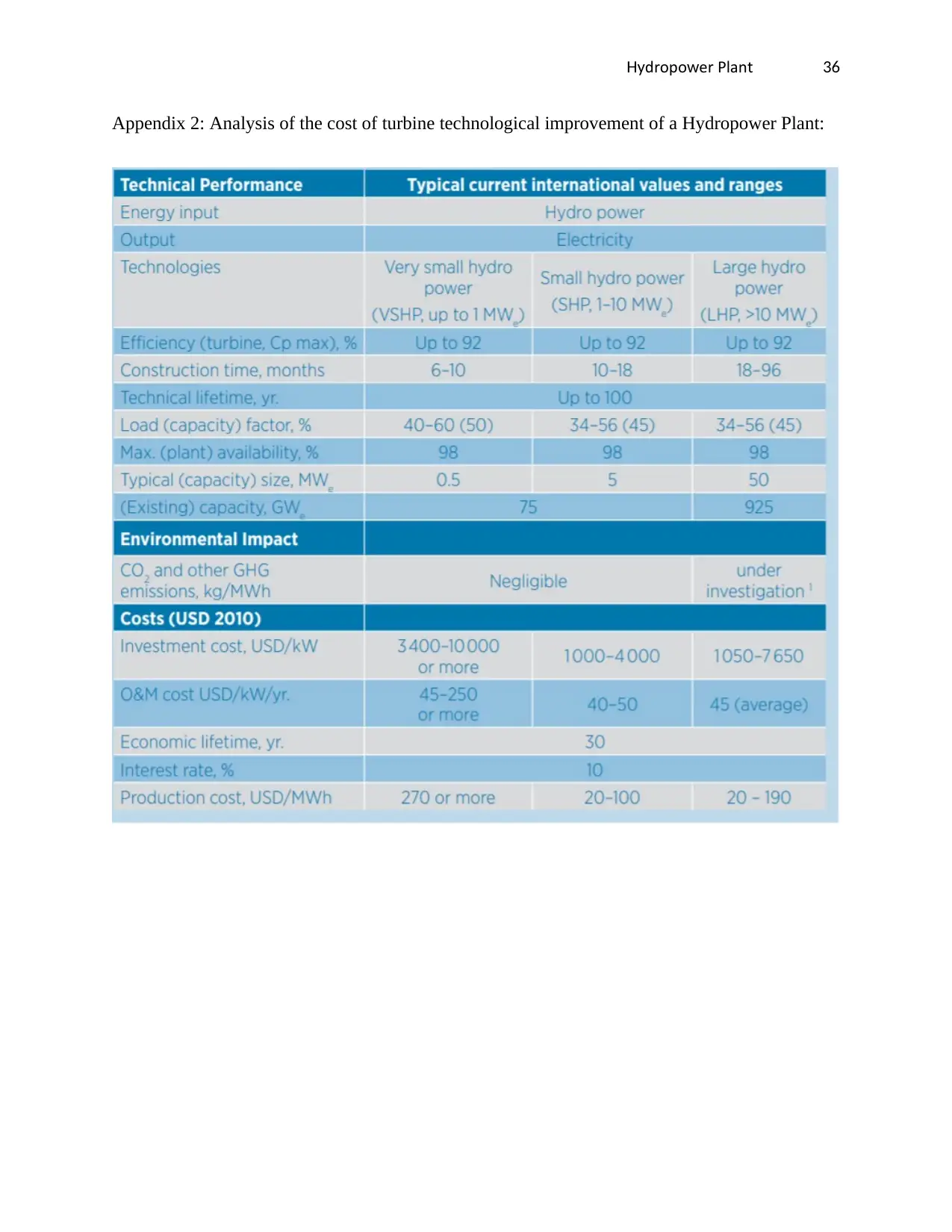
dropo er PlantHy w 36
Appendix 2: Analysis of the cost of turbine technological improvement of a Hydropower Plant:
Appendix 2: Analysis of the cost of turbine technological improvement of a Hydropower Plant:
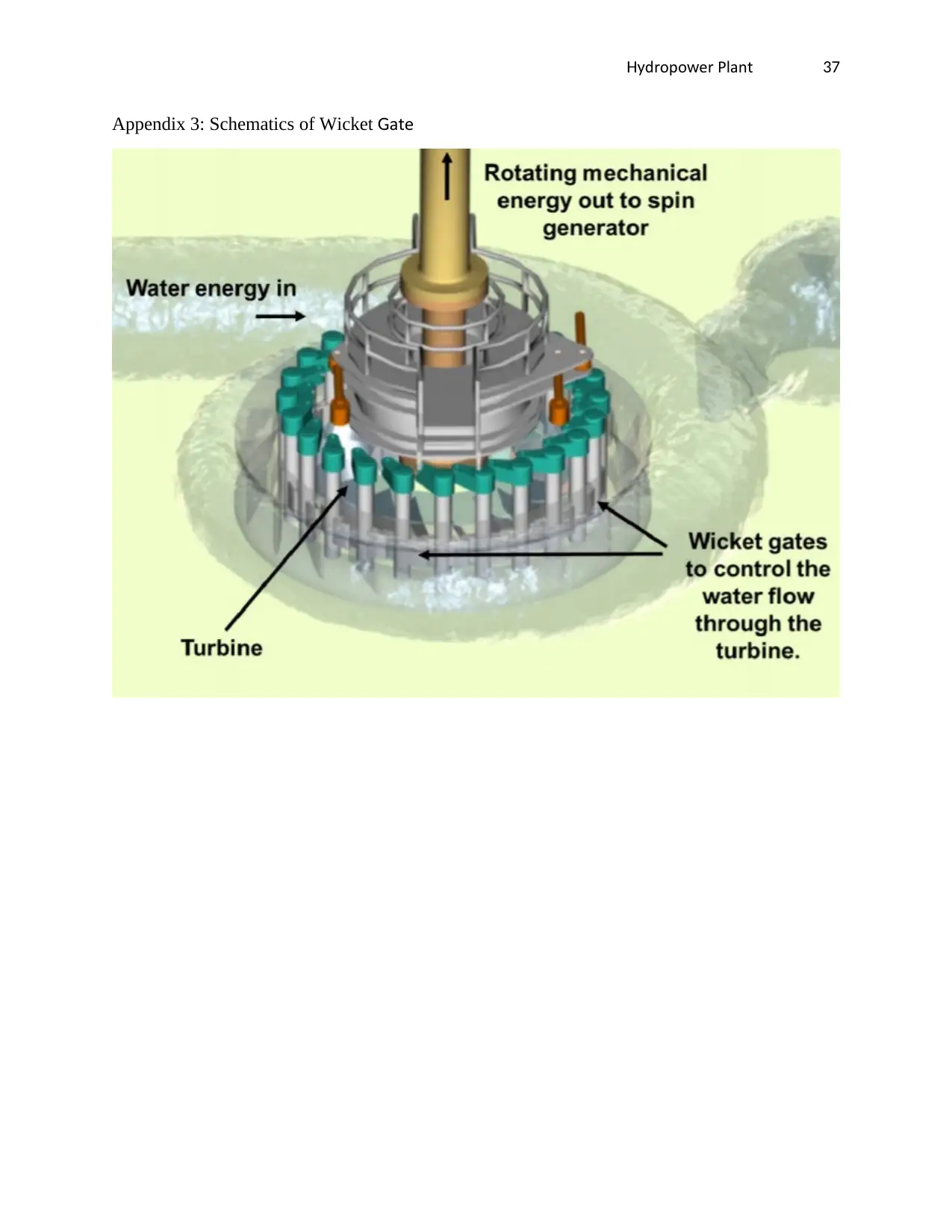
dropo er PlantHy w 37
Appendix 3: Schematics of Wicket ateG
Appendix 3: Schematics of Wicket ateG
1 out of 37
Your All-in-One AI-Powered Toolkit for Academic Success.
+13062052269
info@desklib.com
Available 24*7 on WhatsApp / Email
![[object Object]](/_next/static/media/star-bottom.7253800d.svg)
Unlock your academic potential
© 2024 | Zucol Services PVT LTD | All rights reserved.